

Fotheringhay Castle: The Final Dark Act of a Scottish Tragedy
T here is something strangely compelling about making a pilgrimage to the site from which your Tudor heroine or hero departed this earthly life. It is where they last drew breath and uttered their last words – often with a good deal of drama surrounding the occasion to boot. To stand where a person died, and to reach through the veil of time (particularly when their death was by execution), stirs up our emotions; we cannot help but wonder at the courage these men, and women, so often showed in the face of the axe-man. One such place is the site of the medieval palace-fortress of Fotheringhay Castle – the last place of imprisonment of Mary, Queen of Scots.
Having followed Mary on her journey south from Scotland last month, stopping off at the two intriguing castles of Borthwick and Bolton , we can now explore the location that was the setting for the last act in this Scottish tragedy.
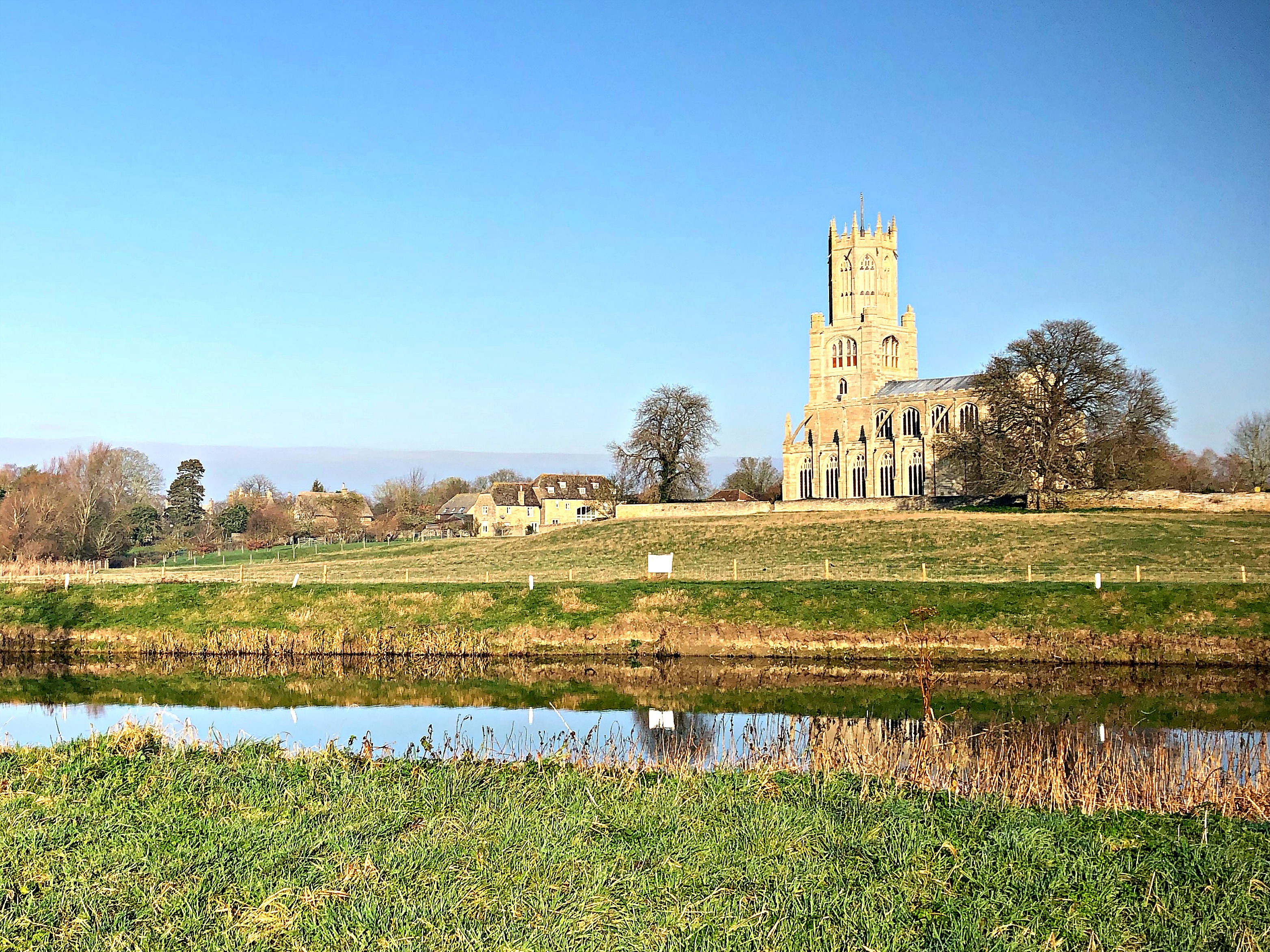
T he month of February sees the anniversaries of the executions of three English queens: Mary, Queen of Scots, on 8 February; Lady Jane Grey, the ‘nine days queen’, on 12 February; and finally, Catherine Howard on the 13th day of the month. In honour of these ladies, during February, we will be touching on one significant location associated with each of them. Today, we start with Mary and her final place of captivity and execution, Fotheringhay Castle.
Fotheringhay Castle: The Power-Base of the House of York
B efore we visit the site of Fotheringhay Castle and recreate the medieval palace as it was in the sixteenth century, let’s say a little about why this site became so significant. Fotheringhay would likely be of little interest were it not for the rising fortunes of the House of York, which allowed the early twelfth-century castle to be transformed into a power base for the family during the fifteenth century, after the creation of the first duke in 1385.
Richard II elevated Edmund, the third son of Edward III, to become 1st Duke of York. The same king affirmed the ownership of Fotheringhay with the aforementioned House of York. Thereafter, through the first half of the fifteenth century, the first, second and third dukes, respectively, developed the early medieval motte-and-bailey castle into a sizeable complex with luxurious privy accommodation befitting their noble status.
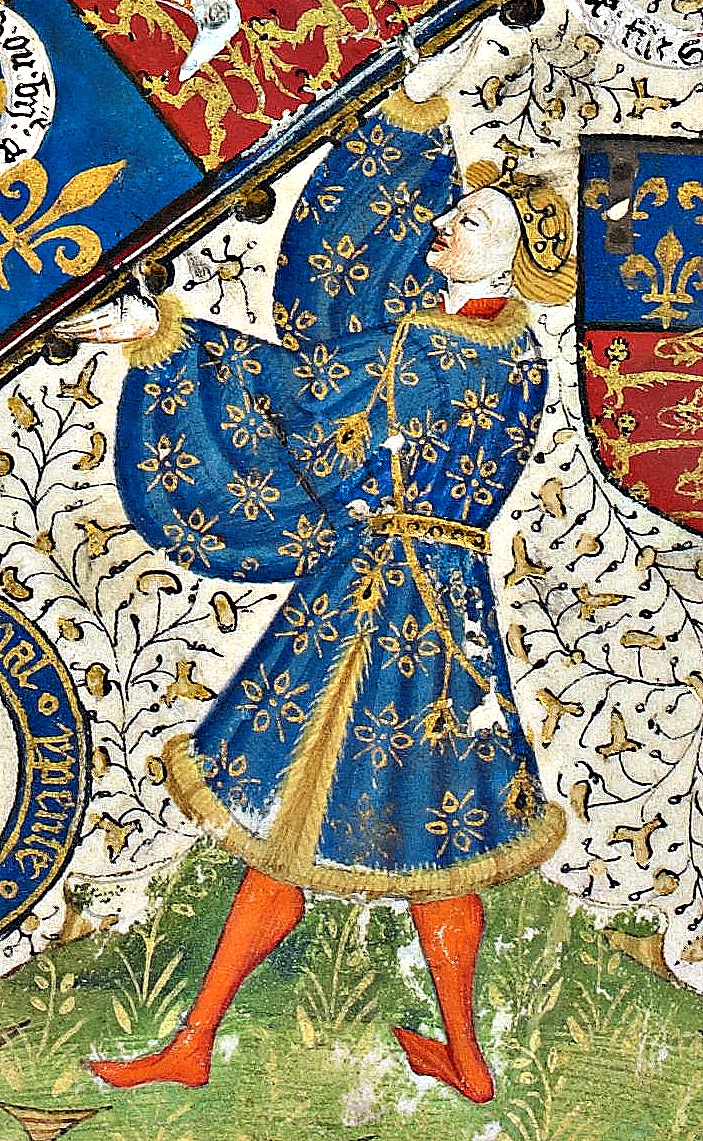
T he 3rd Duke, named Richard, was the father of King Edward IV and, later, Richard III. The latter had extremely close ties with Fotheringhay; Cecily Neville, the Duchess of York, gave birth to Richard at the castle on 2 October 1452, and he lived at Fotheringhay for the first six years of his life. Thereafter, Richard returned for extended visits after he ascended to the throne. In an adult world, which was increasingly unpredictable and dangerous, one imagines that he must have felt a deep sense of belonging and security emanating from his childhood whenever he stayed at the castle.
W hilst palatial apartments, suitable service offices and accommodation were being built at the castle, in a separate project, the collegiate church, just half a mile or so away from the castle site, was also underway. By the mid-fifteenth century, a fine college (like an abbey), served by around 30-40 monks, was complete; it comprised the college church, a monks’ house and cloisters overlooking the Northamptonshire countryside and the meandering River Nene. Established to serve and honour the glory of the Dukes of York and their family, the monks were paid to pray for the souls of their noble masters.
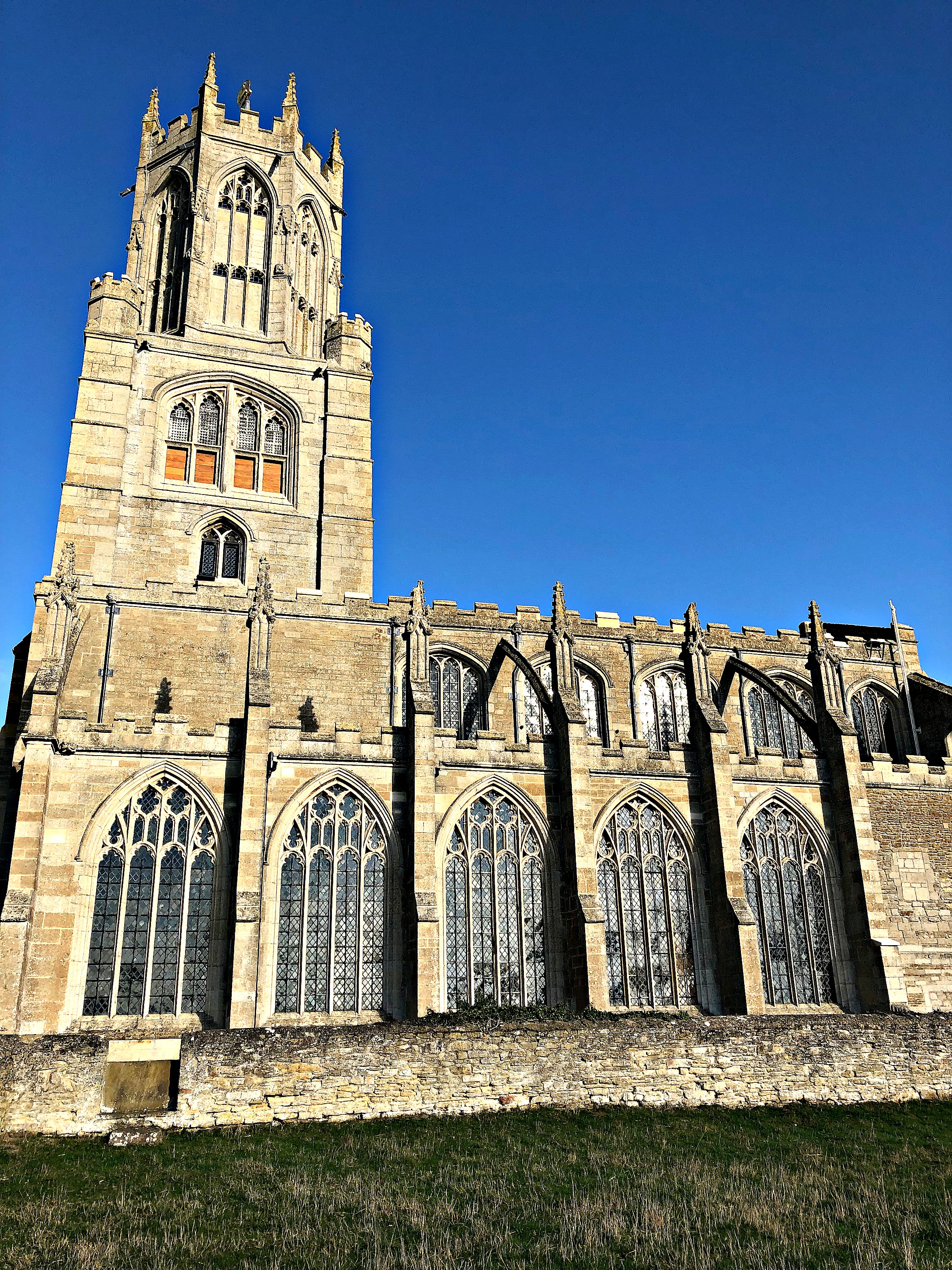
I t is difficult to say whether Edward IV felt as connected to Fotheringhay as his younger brother. What we do know is that this York king had the college rededicated in his name and that it was to Fotheringhay that he had the bodies of his father and younger brother conveyed. Edward had them brought to Fotheringhay after they had been hastily buried at Pontefract, by Lancastrian forces, following the Battle of Wakefield in 1460 (a battle which was part of the War of the Roses).
The two men (the latter only 17 at the time of his death) had been slain during the battle. In 1476, after the Yorks had gained the throne of England, and Edward was in a position to act, he had his father and brother reburied, as befitting their new royal status, in the York mausoleum at Fotheringhay.
T here are wonderful, contemporary accounts of the reinterment at Fotheringhay, which followed a solemn procession south from Pontefract. The entire royal family, Edward IV, Elizabeth Woodville, Richard, Duke of Gloucester (the future Richard III) and all the princes and princesses of York were in attendance. Afterwards, Edward held a lavish feast at the castle, with around 15,000-20,000 people attending. The funeral feast extended over two days, and it is recorded that the poor from surrounding villages benefited enormously from the king’s largesse.
T hese were the glory days of Fotheringhay Castle. Perhaps because of its association with the Yorks, Fotheringhay was little used by the Tudors. Henry VIII granted it to each of his wives in turn, and Katherine of Aragon spent much money renovating and refurbishing the castle. Despite this, it was little used, except perhaps as a place for high-status prisoners like Mary, Queen of Scots. Elizabeth I visited Fotheringhay 5 years into Mary’s custody on English soil. Later, when facing trial for treason, it seems Elizabeth remembered the fortress, located reassuringly close to the country estates of two of her most ardent supporters, William Cecil at Burghley and Christoper Hatton at the equally sumptuous, Holmby House.
Fotheringhay Castle as it Appeared in the Sixteenth Century
The surroundings, outer bailey and keep.
H aving been cunningly ensnared in the so-called Babington Plot, Mary was transferred from Chartley Manor to Fotheringhay on 25th September 1586. She was tried over two days, 14-15 October, and found guilty shortly thereafter. But what do we know of Fotheringhay and the prison that awaited her?
J ohn Leland, antiquary and traveller, visited Fotheringhay as part of his Itinerary in the 1530s, some 50 years before the Scottish queen arrived at the castle. He leaves us with a picture of the village and surrounding countryside, describing how, on the road toward Fotheringhay, he crossed ‘very flat meadows’ via a causeway of ‘some thirty large and small arches…enabling travellers to pass when the river overflows.’ The village, he states, ‘lies along a single street, and all the buildings are stone’. This is, reassuringly, much as you will see it today.
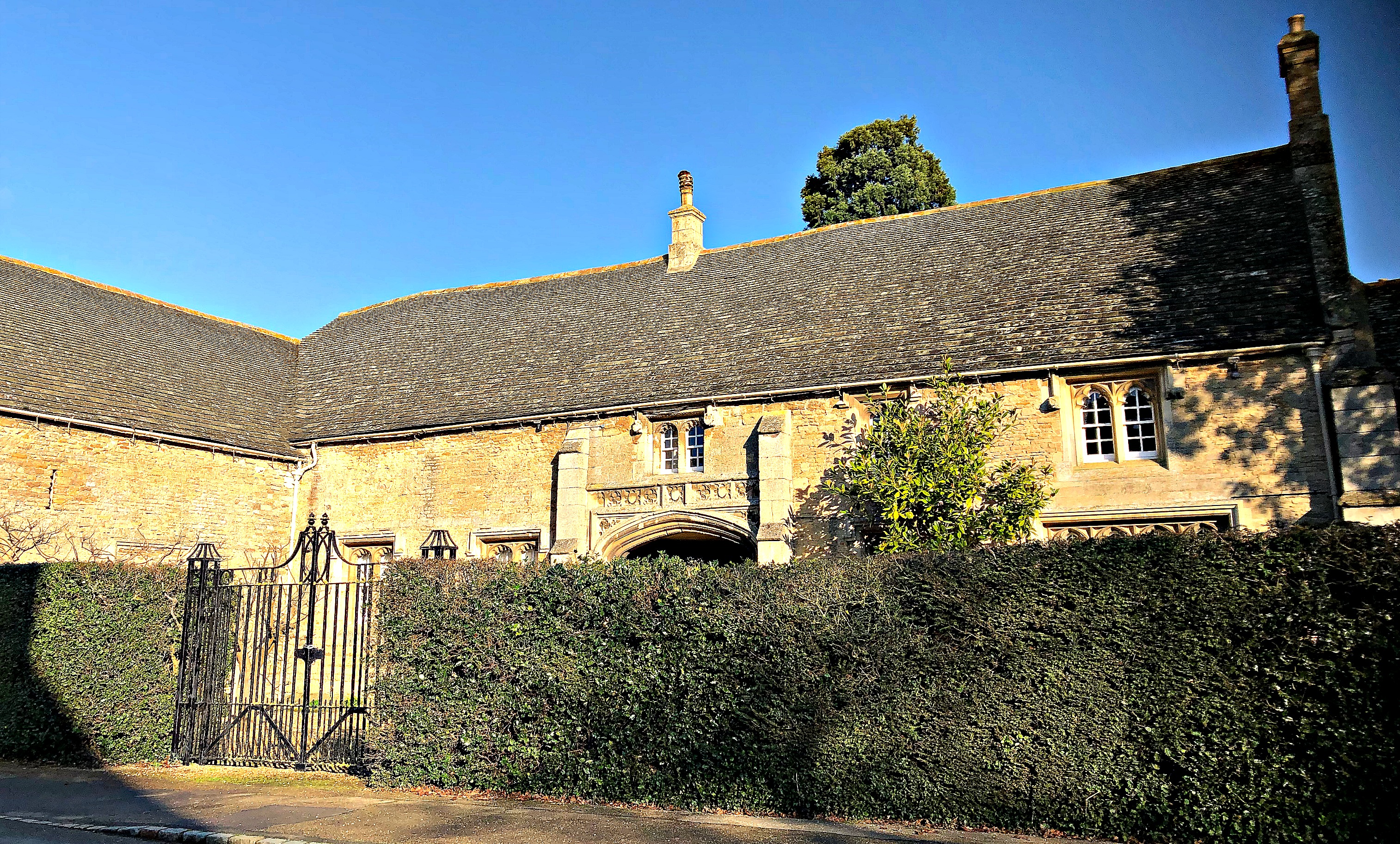
T o explore the castle compound, let’s go on a tour using the map below. It shows the entrance to the castle complex via an outer ‘GateHouse and Drawbridge’. The outer moat has since disappeared, but if you are standing near this point by the bend in the road, look around and notice the fine-looking stone house nearby. It has two blocked doorways and windows visible on the end of the building, fronting onto the road. This was called ‘The New Inn’, and it is notable in Mary’s story.
N ow a private home (co-incidentally of a descendant of William Cecil, Lord Burghley – how ironic is that?!), it once formed part of additional lodgings for the castle. Local folklore says that it was here, in this building, that the axe-man who was to end Mary’s life was lodged on the night before her execution. (This tidbit of local gossip was passed down to me via the churchwarden, who I bumped into whilst visiting the village!)
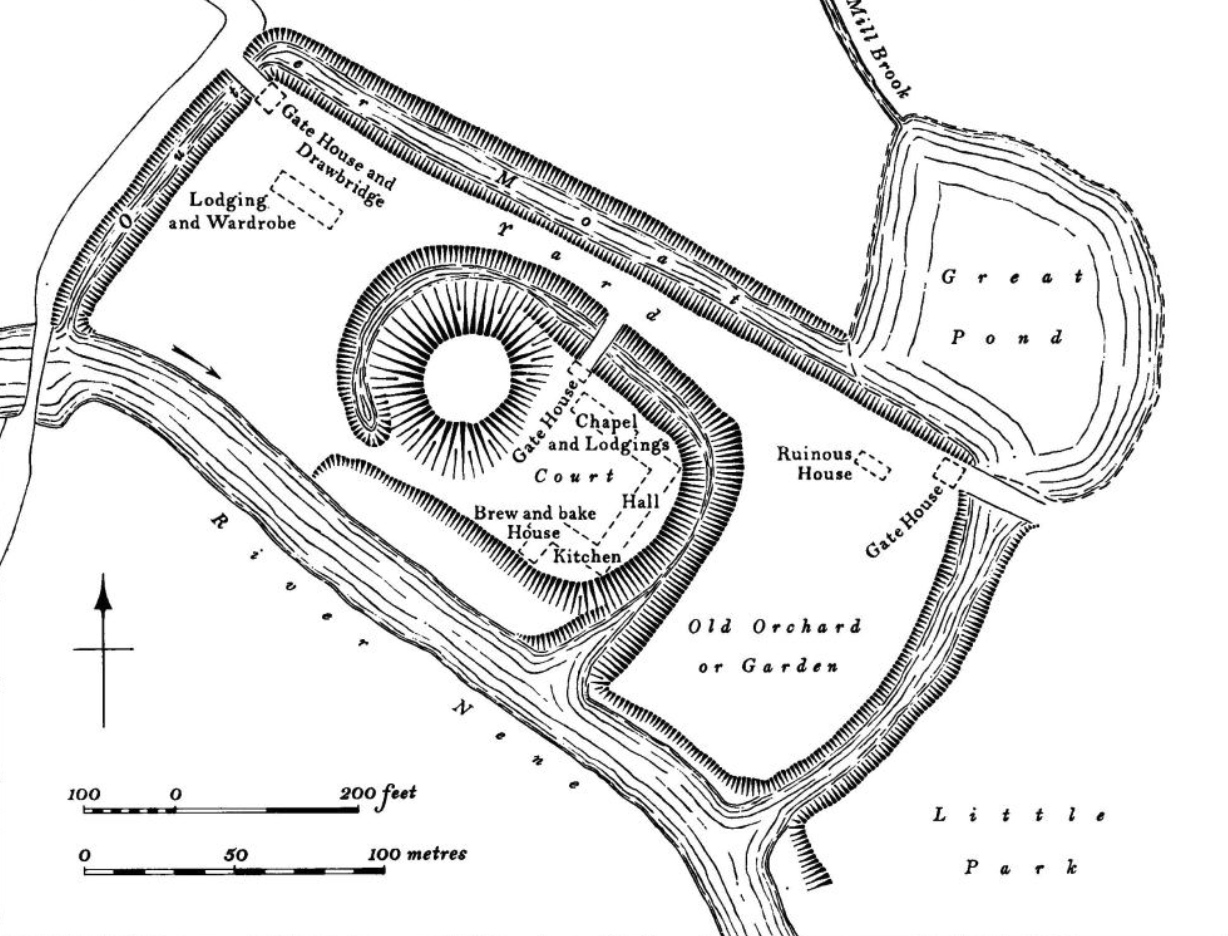
F ollow the track forward; a slight hollow in the path perhaps gives away the site of the earlier moat. Soon, you will arrive at a kissing gate and a nearby information board. Once through this gate, you are standing roughly opposite the earlier site of the inner ‘Gate House’. Marvellously, a pretty detailed account of the layout of the castle’s buildings, made just before Fotheringhay Castle’s demolition, allows us some real insight into the lodgings used to house the Scottish Queen. Let’s walk forward, crossing the inner moat, still graven into the landscape, and pass underneath the now-lost gatehouse.
‘… as soon as you are passed the drawbridge, at the gate there is a pair of stairs [ on your right I am guessing, as the description takes you up towards the castle keep on the motte ], leading up to some fair lodgings and up higher to the wardrobe, and so on to the fetterlock on top of the mound on the N.W. corner of the castle, which is built round of 8 or 16 square, with chambers lower and upper ones roundabout, but somewhat decayed, and so are the leads on the top; in the very midst of the round yard in the same there has been a well, now landed up.
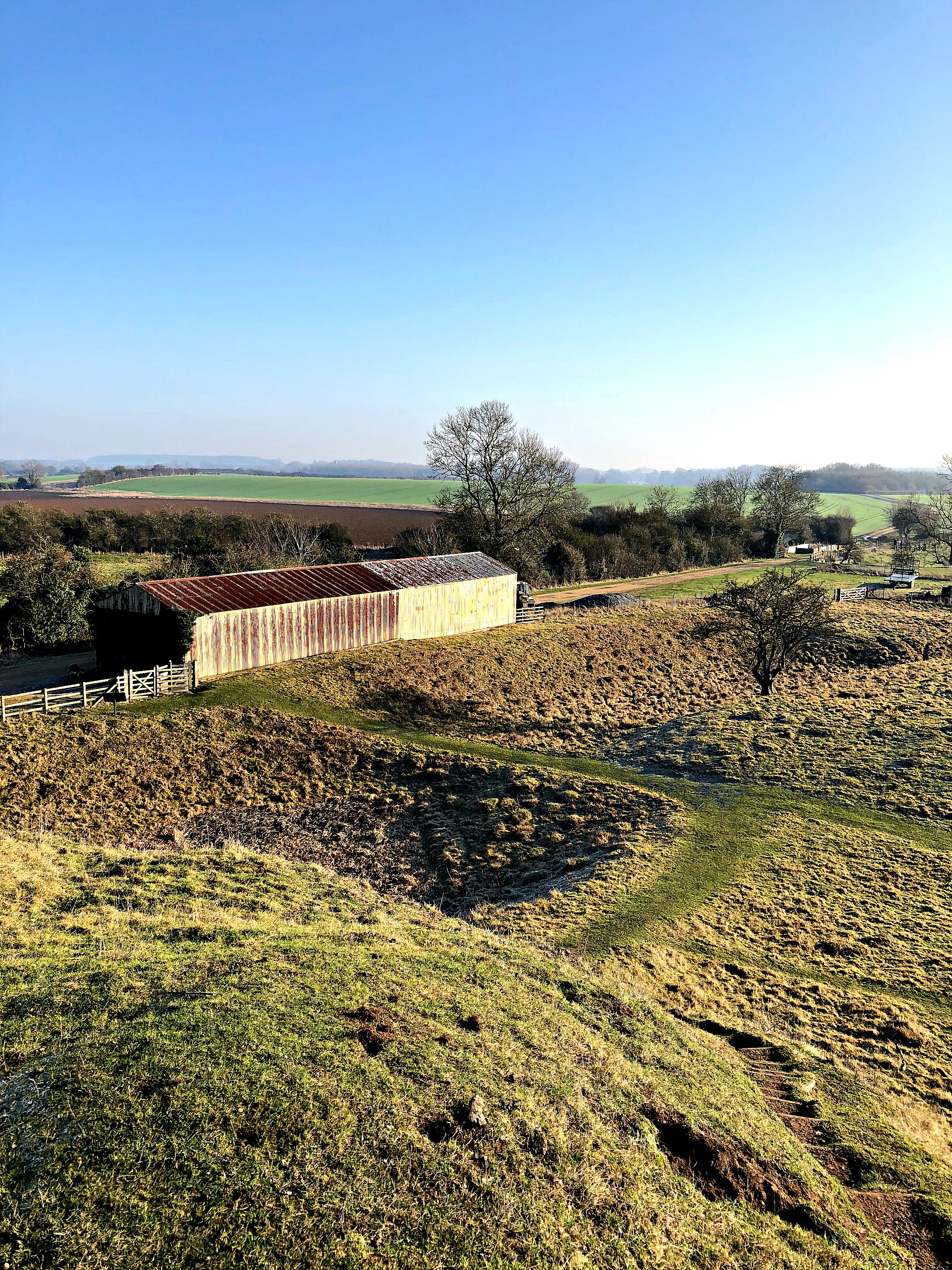
A s far as I can see from this description, the keep on top of the tower had a round, central courtyard in which there was once a well. I am curious about the description of the keep as a ‘fetterlock’. The fetterlock and falcon was a heraldic symbol much used by the Yorks: it looks like a padlock. When you visit the Church of St Mary, you will see this symbol everywhere. Does this mean that the Dukes of York built the keep in the shape of one of the two key objects associated with their heraldry, with apartments built at the ground and first-floor levels, or first and second-floor levels, or was it just an early name for a keep? I’d love to hear if anybody has a definitive answer to that!
The Inner Bailey, Privy Lodgings and Great Hall of Fotheringhay
H aving visited the keep, the description instructs us to return to the inner bailey and visit the key buildings there.
‘W hen you come down again and go towards the hall, which is wonderful spacious, there is a goodly and fair court, within the midst of the castle. Of the left-hand is the chapel, goodly lodgings, the great dining-room, and a large room, at this present well garnished with pictures. Near the hall is the buttery and kitchen; and at the other end of the kitchen a yard, convenient for wood and such purposes, with large brewhouses and bake-houses and houses convenient for offices. (H. K. Bonney, Fotheringhay, (1821), 29–30 from an account of 1625.)’

A nd so we find a large courtyard at the centre of the inner bailey. With the motte and keep behind us, the chapel is on our left, along with what seems to be the principal privy lodgings for the castle, which Leland’s account describes as ‘excellent’. These lodgings comprised at least a ‘great dining room’ and another ‘large room’ – possibly a presence chamber, privy chamber or gallery? We are not told, although galleries were often used to hang extensive collections of portraits, as mentioned in the above quote.
T he reconstructive map places the hall at the east end of the site. As usual, the high end of the hall would probably have been accessed from the privy lodgings, with the low end leading to the kitchens, pantry and buttery and beyond. This is stated clearly in the above account. It seems most likely that these high-status rooms were used to house Mary for the six months that she was at Fotheringhay Castle, although, as far as I am aware, her exact place of incarceration within the fortress is unknown.
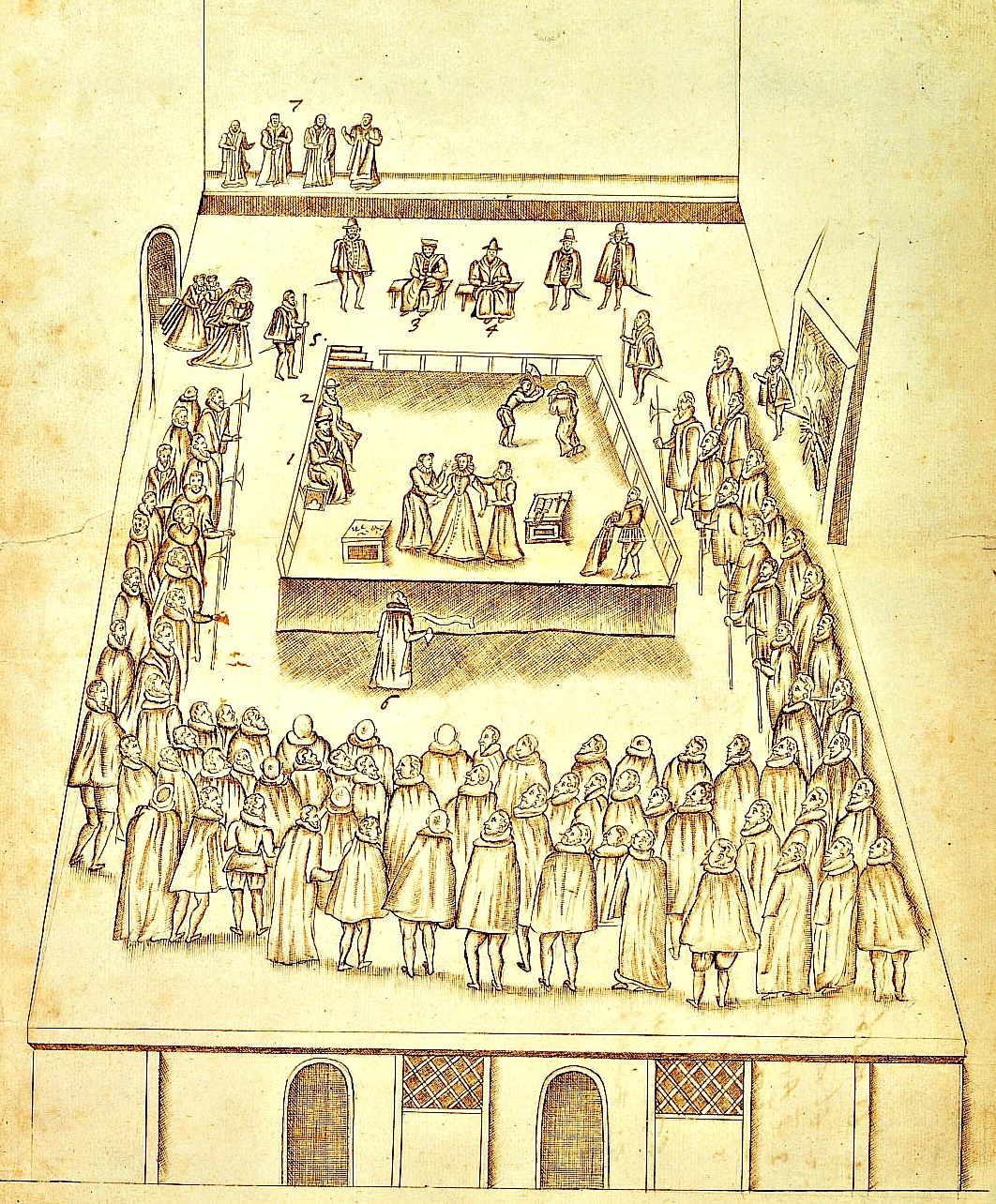
T he hall itself is described as ‘goodly spacious’, and from a drawing of the execution of Mary in the Great Hall, at the upper end of the hall, we can see a raised dais and doorway – a typical arrangement. Mary is seen entering the hall through this doorway, another indication perhaps of her being lodged in the connecting privy chambers; a large fireplace is situated centrally on the opposite wall.
Inside the Great Hall – 8 February 1587
W hen you visit today, the boundary of the inner bailey is clear, and it is easy to walk where the privy lodgings and great hall once stood. Now, it is time to pause for a moment and connect with Mary on that, no doubt, cold February morning in 1587. With the fire crackling in the grate and to the hubbub of around 300 witnesses, Mary entered the hall. In a contemporary account, the scaffold is recorded as having been arranged at the high end of the hall. It was ‘two-foot high and twelve-foot broad’ – all draped in black. The previous evening, she had penned one of her last letters to her brother-in-law, the King of France. Here is an extract:
‘Tonight, after dinner, I have been advised of my sentence: I am to be executed like a criminal at eight in the morning. I have not had time to give you a full account of everything that has happened, but if you will listen to my doctor and my other unfortunate servants, you will learn the truth, and how, thanks be to God, I scorn death and vow that I meet it innocent of any crime, even if I were their subject. The Catholic faith and the assertion of my God-given right to the English crown are the two issues on which I am condemned, and yet I am not allowed to say that it is for the Catholic religion that I die, but for fear of interference with theirs. The proof of this is that they have taken away my chaplain, and although he is in the building, I have not been able to get permission for him to come and hear my confession and give me the Last Sacrament, while they have been most insistent that I receive the consolation and instruction of their minister, brought here for that purpose…
There is a detailed contemporary description of the clothes Mary wore that day, and these were captured in a posthumous and now iconic portrait of the queen as a Catholic martyr (see below). The account describes Mary’s ‘uppermost gown of black satin’, which clearly had some print upon it, and with a train which ran ‘upon the ground’. The sleeves were ‘long hanging’ and ‘trimmed with acorn buttons of jet and pearl’. They were cut such that the under-sleeves of purple showed through and, as we famously know, when her ladies and the executioners undressed her, there revealed were her kirtle of black velvet with her ‘Boddies of crimson satin and her skirt being of crimson velvet’.
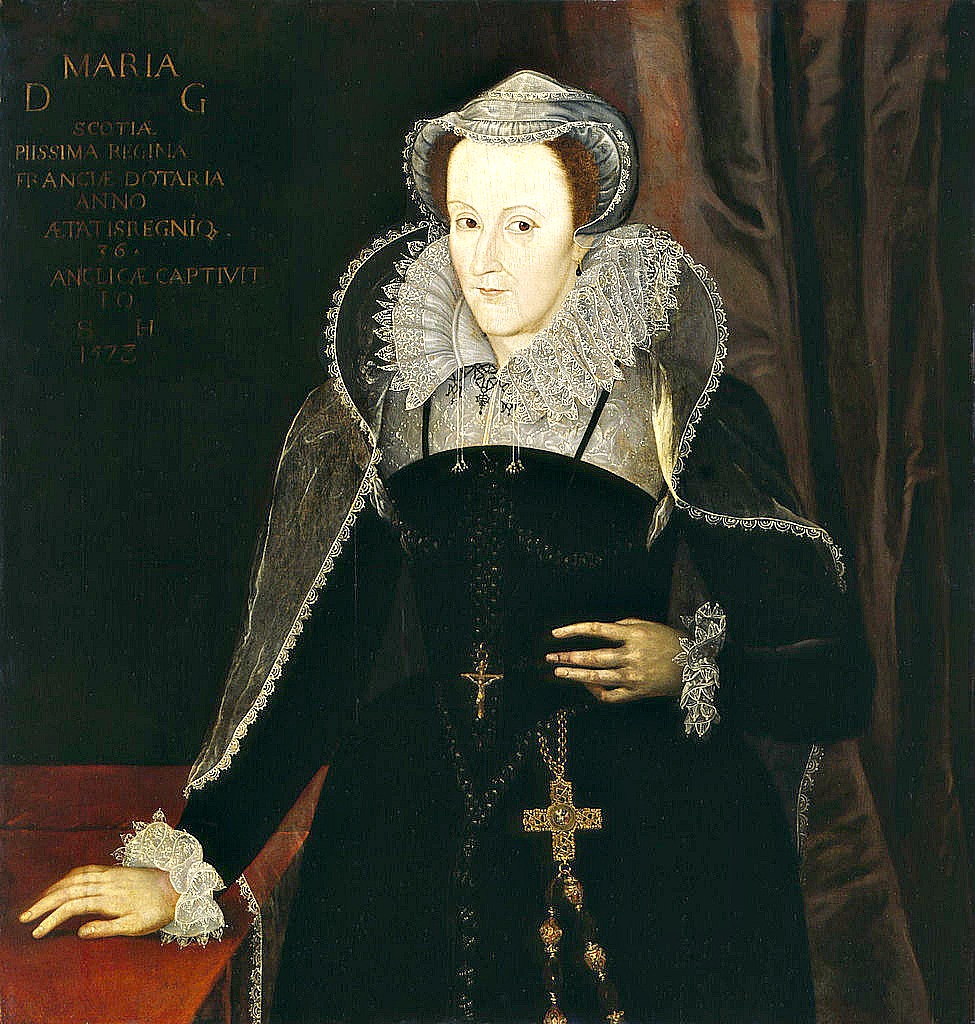
A fter mounting the scaffold, Mary sat upon a chair while the Clerk of the Council read aloud the Commission against her, followed by a prayer said by the Dean of Peterborough Cathedral. Mary paid little heed to either, refusing to accept the invitation to renounce her religion – and expressing her willingness to ‘die therein’. She managed even a ‘smiling countenance’ when her ladies, and the executioner, helped her disrobe of her outer garments, saying that ‘she was never served by such grooms before’. Perhaps still clutching in her hand the crucifix which she had brought into the hall, Mary, Queen of Scots knelt down on a cushion, her face and eyes being covered by a ‘Corpus Christi cloth wrapped up three corner wise’.
‘S he groped for the block, whereon she laid her head, crying out ‘In manus tuas, Domine, commendo spiritum meum’ or ‘Into thy hands, O Lord, I commend my spirit.’ ‘At ten o’clock afore noone’, Mary was executed, thus bringing her sorry story and her ‘troubles’ to an end. After her death, Mary’s entrails were buried secretly at Fotheringhay Castle, while the body was conveyed to the ‘great chamber’ (in the privy lodgings), where the surgeon embalmed the corpse. There, Mary’s body remained until it was conveyed to Peterborough Cathedral for burial.

T oday, Fotheringhay Castle is a haunting spot. As I stood upon the ground once occupied by the great hall, reliving this sad scene in my mind’s eye, only a few sheep stood by to watch my odyssey with a good deal of suspicious curiosity. Just a small fraction of the keep survives, now relocated next to the River Nene, adjacent to the site; plaques commemorating this event and the birth of Richard III speak of the immense historic significance of this now-lost palace-fortress.
Visitor Information
When visiting Fotheringhay Castle, make sure you also visit the nearby church of St Mary and All Saints , once the collegiate church of the House of York. Although much reduced in size, having lost the choir, Lady Chapel, monks’ house and cloisters at the Dissolution of the Monasteries, there is fine mid-fifteenth-century architecture to be seen, including a fan-vaulted ceiling, with the York falcon and fetterlock emblem at its centre; a font and a painted pulpit, gifted to the church by Edward IV.
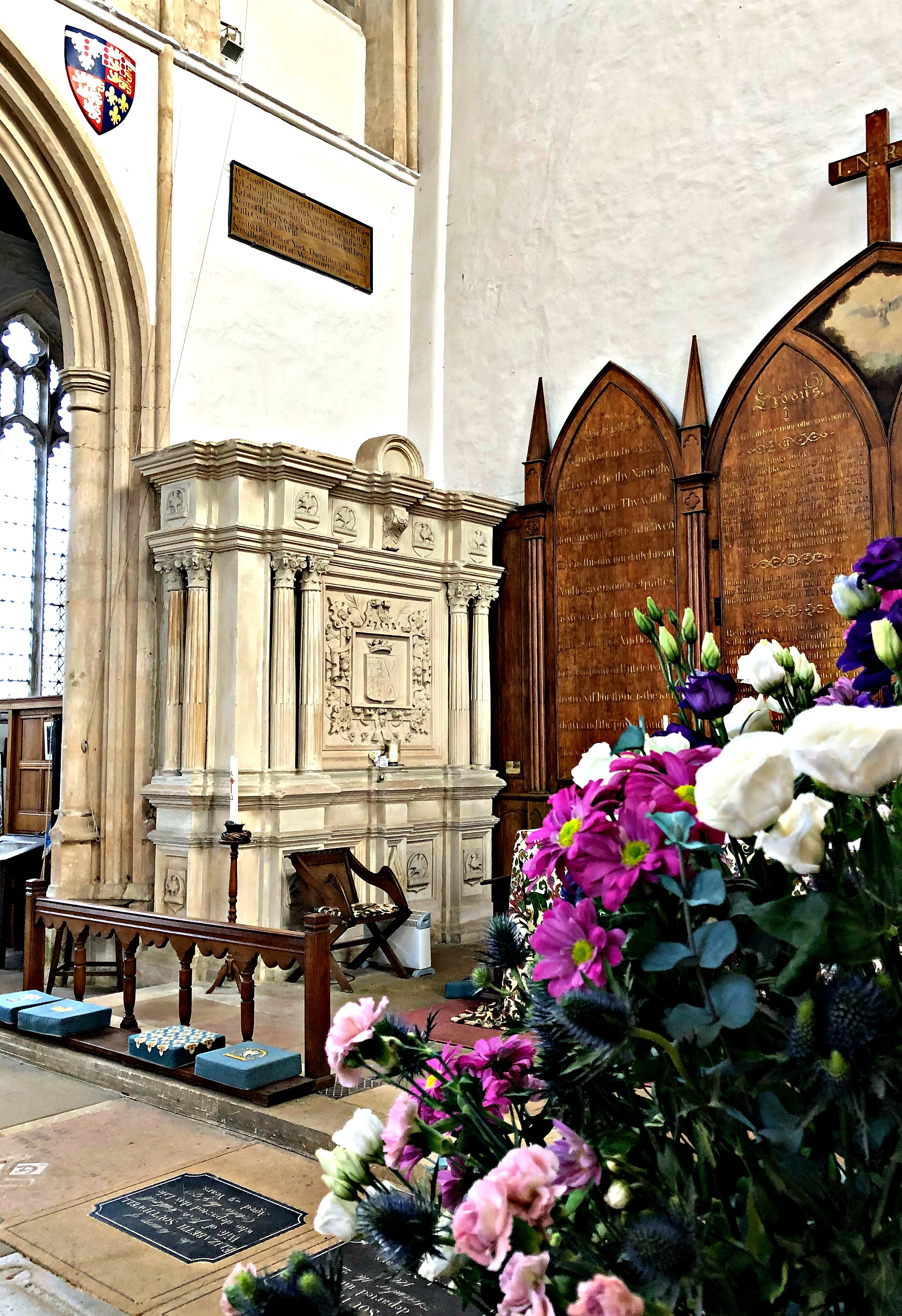
T he tombs of Edward IV and Richard III’s mother and father, Cecily Neville and the 3rd Duke, and that of the 2nd Duke (the only nobleman killed at Agincourt), can be seen on either side of the high altar. These are Elizabethan reconstructions of the earlier lost tombs, desecrated and left to crumble post Dissolution. They were built on the orders of Elizabeth I herself. She commissioned them after visiting the church during her visit to Fotheringhay and witnessing first-hand the sorry state of the tombs of her royal forefathers.
A lso, look out for scars on the south side of the church walls where doorways once connected the main church building with the monks’ house and cloisters.
F or the past 3-4 years, a commemorative service has been held in Mary’s honour, with readings in French, Latin and English. I was assured by one of the churchwardens I met on my visit that re-enactors are also present.
H aving worked up an appetite, you might consider lunch at The Talbot Inn , in nearby Oundle, just a couple of miles down the road. After the castle at Fotheringhay was dismantled, stone from the site was used to construct the inn. The dark oak staircase and a large window that lights it was also brought from the castle.

T here is a legend that this staircase once led up to the lodgings of the Queen of Scots at Fotheringhay Castle and that a small gate, still visible at the top, marked the boundary of her confines. Thus, it is said that it was down this staircase that Mary walked to her execution in the great hall and that it is haunted by her ghost today. As far as I am concerned, this is doubtful for two reasons.
Firstly, this is just not the kind of grand processional stair that would lead down from a ‘Great Chamber’. It’s possible, I suppose, but it doesn’t feel right. However, more importantly, ‘experts’ have dated the staircase to the early 1600s; a very good reason to suppose this tale, sadly, is just that, made up by someone to tell a good yarn. Oh well, we love a good ghost story too!
Similar Posts

An Audience with Henry VIII: Behind the Mask
What if you could meet King Henry VIII of England? What questions would you be dying to ask him? How…
Leicester Abbey: The Mystery of the Lost Tomb of Cardinal Wolsey
Thomas Wolsey was a lucky man. Accused of treason, he narrowly avoided Henry VIII’s ‘justice’ on the scaffold and instead…
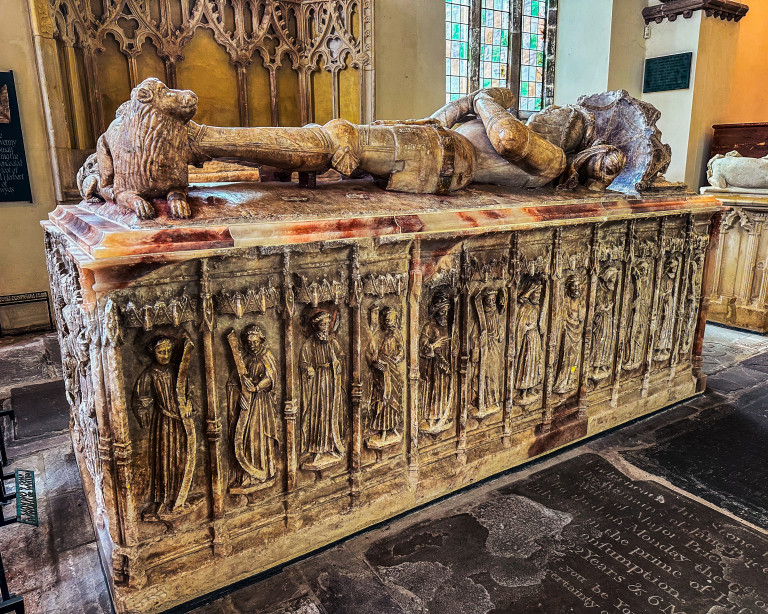
Sir William ap Thomas of Raglan Castle, Monmouthshire
Medieval Tomb:
Name and Title: Sir William ap Thomas
Born: Sometime in the 1380s.
Died: 3 May 1445, London.
Buried: St Mary’s Priory, Abergavenny, Wales.
Read more and see images of the tomb here…
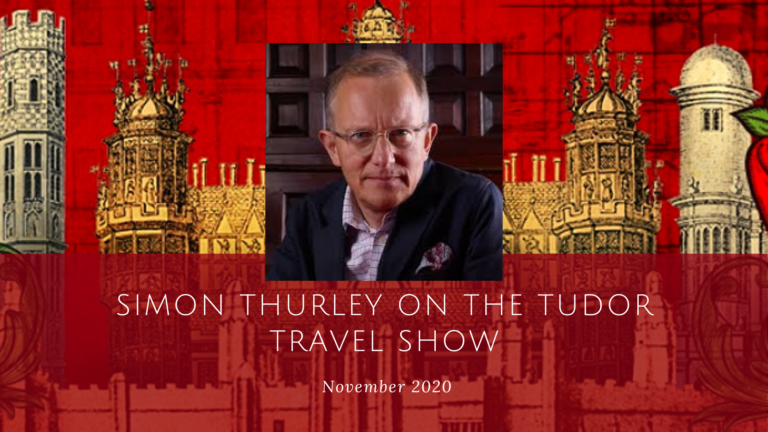
Tudor ‘Houses of Power’ with Prof Simon Thurley
In this month’s episode of The Tudor Travel Show: Extra! Sarah is in conversation with Professor Simon Thurley, a pre-eminent architectural…
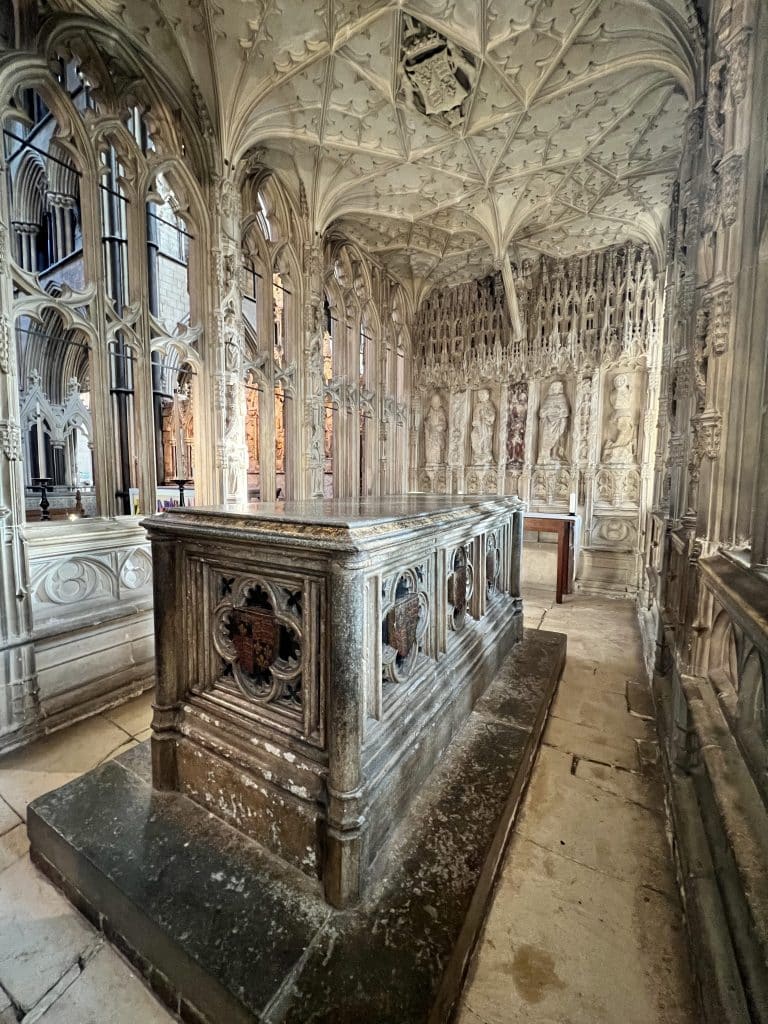
Arthur Tudor, Prince of Wales
Dear Time Traveller, This content is restricted to paid members of my membership site: The Ultimate Guide to Exploring Tudor England….
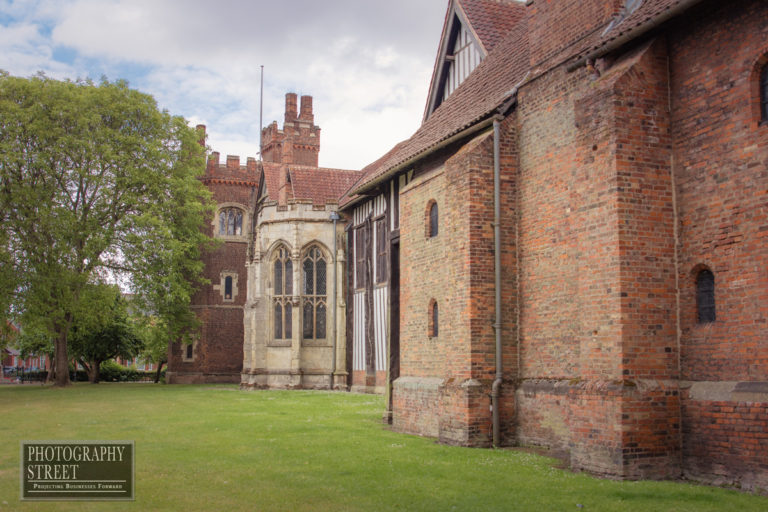
Gainsborough Old Hall: The Most Complete Tudor Courtier House in England
Gainsborough Old Hall, in Lincolnshire, has been described by the renowned architectural historian, Anthony Emery, as the most complete courtier…
16 Comments
I was overwhelmed when I visited Fotheringhay. Something momentous happened there and I could sense it. The church is great too. Wonderful article.
I love it when that happens when visiting a Tudor site – or any historic site for that matter. That felt sense of connection, the energy that hangs around a place is beyond logic. Thanks for your kind words!
- Pingback: Tudor Pancakes Galore!: The Great Tudor Bake Off - Week 2 | The Tudor Travel Guide
- Pingback: Linlithgow Palace: The Renaissance Birthplace of Mary, Queen of Scots | The Tudor Travel Guide
- Pingback: Jedburgh and the Mysterious Near-Death of Mary, Queen of Scots | The Tudor Travel Guide
Fotheringhay is one of my favourite places, being a fan of both the York dynasty and the Tudors. And one can be a fan of both I assure you! There is an atmosphere around the castle area, quite difficult to describe but to me, there is an air of sadness about the place even on a sunny day. I live not far from Fotheringhay so its somewhere I have visited many times, there is definitely an emotional pull. And I can recommend The Falcon, fabulous food! Very interesting article as always Sarah! Carol
- Pingback: The Memorialisation of Mary Queen of Scots: The Making of an Icon | The Tudor Travel Guide
- Pingback: Mary Queen of Scots: A Glittering Future at the French Court | The Tudor Travel Guide
- Pingback: Tudor Places to Visit Outside of London: Travel Essentials | The Tudor Travel Guide
- Pingback: Loch Leven Castle: The Prison of a Beleaguered Queen | The Tudor Travel Guide
- Pingback: William Cecil And Elizabeth I: The Power Couple of the Tudor Age. | The Tudor Travel Guide
- Pingback: Mary Queen of Scots: A Glittering future at the French Court (Article for the Tudor Travel Guide Feb 2021) – Katie's Chronicles
Thank you for your his beautiful essay about my favorite historical character. I’ve been researching Mary Stuart for most of my life. We are American, Scottish descendents of the Campbell clan. My Great Grandma was a Kennedy & is related to Janet Kennedy who attended the Queen. I do have a question that I hope you can answer definitively. Did one of her ladies stay with her body while it lay in Fotheringhay until her burial? Do you know which one stayed? I’m writing an historical, fictional story focusing on the betrayals she endured. It’s written from the point of view of one of her maids. Any help or guidance is appreciated, especially since I have only viewed these locations through a screen & my Grandparents stories. It makes the project more difficult but no less important a project for my Grandpa’s memory. “Never Forget” our family history & tell our story. Thanks again for this fabulous information.
Hi Shan, Thanks so much for your comment. I am so glad you liked the article. There were ladies who attended Mary; I think Mary Seaton was first among her oldest of companions and friends who stayed with her during her imprisonment. I don’t know for sure without spending time researching the answer but it would not surprise me if she wasn’t the prime candidate. I tend to focus on the places and do my research there, weaving the story into the narrative as I go, which means I often know more about the place than the people. You might try Melita Thomas from Tudor Times who wrote an article about the fate of the Four Mary’s or the Marie Stuart Society. Sorry,I can’t be of more help. Best wishes, Sarah
Just returned to the states a few days ago after my second visit to Fotheringhay. It is a magical place indeed. Loved your article and, I too suspected that the “staircase story” was just that. “Legend has it…”, but The Talbot Inn is a wonderful place for tea and musing over history, true, or otherwise.
Hi Karen! I agree…I love a good legend!
Leave a Reply Cancel reply
Your email address will not be published. Required fields are marked *
Fotheringhay Castle & Mary, Queen of Scots
History, tourist information, and nearby accommodation.
- Nearby attractions
Accommodation
HERITAGE HIGHLIGHTS: Birthplace of Richard III, Mary, Queen of Scots was executed here
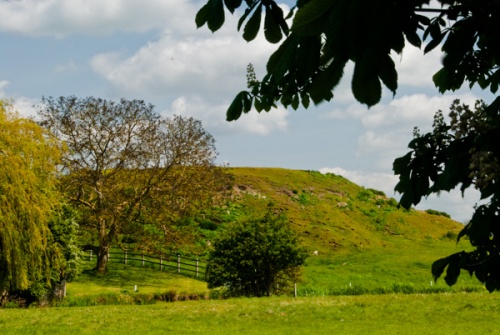
Only the earthworks and the conical motte remain of Fotheringhay Castle, standing on level ground above the peaceful River Nene. The castle was founded around 1100AD by Simon de St Liz (Senlis), Earl of Northampton and Huntingdon. St Liz chose the site carefully to control an important river crossing.
The castle was a typical Norman motte and bailey, with a conical mound protected by a bank and ditches, and topped by a timber keep. The site would have been approached through a wide enclosure (the bailey) where secondary buildings such as stables and workshops stood.
When St Liz died his widow Margaret married King David of Scotland and Fotheringhay passed to the Scottish crown. It was besieged and captured in 1221 by Wiliam de Fortibus, Earl of Abermarle, who took the garrison by surprise after crossing the frozen moat in winter.
It was forfeited to the English crown in 1294, which is a politically correct way of saying that Edward I seized it. Around 1340 the timber keep was replaced with a massive stone keep dubbed 'The Fetterlock'.
A survey at this time describes the castle as containing the keep, two chapels, a great hall, kitchens, and a number of secondary buildings. The site was defended by a moat and drawbridge, leading to a gatehouse.
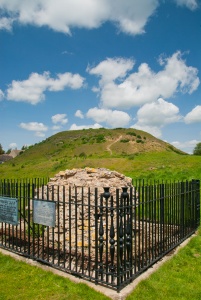
By 1377 the castle was in a poor state, but it was granted to Edmund Langley, son of Edward III, who repaired the keep and transformed it from a military stronghold into a comfortable palace and centre of administration.
Edmund Langley's son Edward founded a college of priests at the castle to say prayers for the House of York. Around 1415 the college was moved east and attached to an old Norman church. The church was rebuilt in Perpendicular style, and the nave set aside for use by the villagers. The college was dissolved in the Reformation, and the nave of the collegiate church forms the current parish church.
Richard III was born here on 2 October 1452, and though tradition says he was baptised at Fotheringhay church, he might equally well have been baptised at the castle chapel. Richard only lived here for six years until he was moved for safety to Ludlow Castle.
After Richard lost his life at the Battle of Bosworth in 1485 the castle was allowed to decay. Henry VIII granted Fotheringhay to Catherine of Aragon, and Catherine lavished money returning the castle to its former glory.
Unfortunately, her tenure as queen did not last, and Henry granted the castle in turn to each of his subsequent wives. It was used primarily as a prison, and it is in this role that it saw its most famous moment in history.
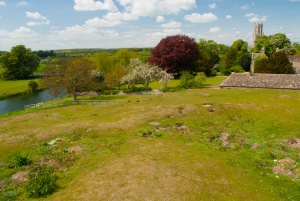
Mary, Queen of Scots Trial and Execution
In 1586 Mary, Queen of Scots was brought to Fotheringhay from Chartley in Staffordshire to stand trial for treason. Why Fotheringhay? Because the castle was set in a marshy landscape, where access was difficult, especially during the winter months.
It was felt by the authorities that the unfortunate Scottish queen would be more secure at Fotheringhay, and the location would discourage any rash attempt to free her by force.
Mary was tried at the castle on 14 and 15 October 1587 in a show trial and predictably found guilty on 25 October - a foregone conclusion.
She was not executed immediately, for Elizabeth I was reluctant to sign the death warrant, but finally on 8 February 1588 Mary was executed in the great hall. She carefully dressed for the occasion in black with a scarlet bodice and petticoat; the colours carefully chosen because they represented martyrdom.
Accounts of the execution vary, and may be inaccurate, but tradition says that the executioner was nervous and made a poor job of his work, taking two or three blows to sever the queen's head.
One version says that when the head rolled from the body the executioner went to pick it up by the hair only to have the 'hair' prove to be a wig and come off in his hand. Another version says that Mary's little dog hid in her skirts and refused to leave her corpse.
Mary's body was left on view at Fotheringhay until July when it was carried at night to Peterborough Cathedral for burial. When Mary's son James too the throne as James I of England he had his mother's body transferred to Westminster Abbey and buried in Henry II's chapel, in a tomb slightly larger than Elizabeth I's.
After Mary's execution the castle was allowed to decay completely. It was eventually sold, and local people began to rob the site of building stone. The castle was finally dismantled completely in 1628, and stone used to build an inn in Oundle.
The great hall was purchased by Sir Richard Cotton, who had the interior stripped and the furnishings transferred to Connington, in Huntingdonshire.
Tradition, probably inaccurately, suggests that James VI of Scotland, Mary's son, ordered the castle destroyed after he took the throne of England as James I. The more plausible explanation is that it was simply falling apart anyway. Bits of the castle were incorporated into nearby Castle Farm, and sections of the moat were filled in during the 19th century.
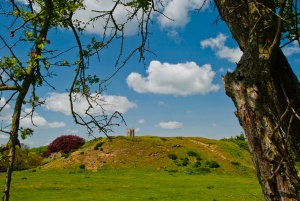
Visiting Fotheringhay Castle
The castle today consists of a low mound, flattened on top, surrounded by a ditch, with an outer bailey earthwork. Close to the river is a small section of masonry wall protected by an iron railing.
There are three commemorative plaques on the railing; the first simply says that this section of masonry is from the castle keep, the second was set up by the Stuart History Society and commemorates the death of Mary, Queen of Scots, and the third plaque was set up by the Riichard III Society and commemorates the birth of Richard at Fotheringhay Castle.
Three plaques for one bit of masonry seems a bit over the top, but in truth there's little enough of the castle remaining otherwise.
For a place that witnessed historical drama, the birth of kings and the death of queens, Fotheringhay offers pretty sparse remains to enjoy. So it is the association of the castle with royalty that will bring visitors here, not any great standing walls or dank and dismal dungeons.
The mound is easy to climb and even easier to enjoy as a good example of a motte and bailey site, but aside from that there's not much to see!
A stone carving of a lion thought to have been made during renovations by Catherine of Aragon can be seen inside the church porch, and the tombs of Richard, 1st Duke of York, and his son Edward, Earl of Rutland, stand on either side of the altar.
On the main road through the village is Garden Farm, once called New Inn, built by Edward IV to house overflow guests of Fotheringhay Castle. Over the entry are heraldic shields bearing traditional Yorkist symbols.
The castle site is open access, and a footpath runs directly past the northern edge of the mound. You can also get good views from the bridge across the River Nene.
About Fotheringhay Address: Castle Farm Cottage, Fotheringhay, Northamptonshire, England, PE8 5HZ Attraction Type: Castle Location: No dedicated parking area; park on the main Fotheringhay road. The castle is on a footpath beside Castle Farm, off the main road. The village is four miles north of Oundle. off the A605. Open access site. Location map OS: TL061930 Photo Credit: David Ross and Britain Express
POPULAR POSTS
- 10 Fairytale Scottish Castles
- 25 Haunted Historic Houses and Castles to Visit in England
NEARBY HISTORIC ATTRACTIONS
Heritage Rated from 1- 5 (low to exceptional) on historic interest
Nearest Holiday Cottages to Fotheringhay:

More self catering near Fotheringhay
Northamptonshire
Attractions.
- All attractions
- Attractions map
- Historic Buildings
- Historic Churches
- Historic Houses
- Towns & Villages
- Althorp House
- Fotheringhay Castle
- Rockingham Castle
- Self Catering
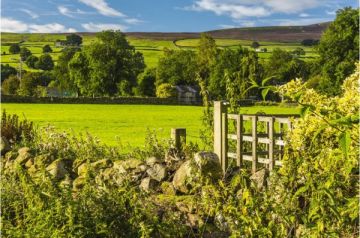
Stunning UK prints for sale by award-winning photographer David Ross, editor of Britain Express, the UK Travel and Heritage Guide.
Top Historic Attractions in Northamptonshire
Towns / villages.
Glapthorn Manor Oundle Sleeps 16, from £2631.00 Kite Cottage Syresham Sleeps 4, from £395.00 Manor Farm House Cottage Thrapston Sleeps 4, from £639.00 More self catering in Northamptonshire
Fotheringhay Castle: Richard III & Mary Queen Of Scots
Fotheringhay Castle may not be much to look at now, but it was the locations of several important historical events, especially the birthplace of Richard III and where Mary Queen Of Scots was executed.
Here is our guide.
Table of Contents
Where Is Fotheringhay Castle?

Fotheringhay Castle is located in the village of Fotheringhay, Northamptonshire, England .
It’s just to the west of Peterborough, about 85 miles north of London.
History of Fotheringhay Castle
Construction and early history.
The castle was originally built in the 12th century by Simon de Senlis, Earl of Northampton and was used for centuries as a royal residence.
The castle served as the seat of power for many years following its construction and drew visitors from all over Europe, who came to witness its grandeur.
The original structure was built with an oval-shaped motte surrounded by two baileys – one inner bailey which housed a great hall and chapel, and an outer bailey containing other buildings such as stables and warehouses. The castle also had an impressive stone keep that stood at the top of the motte.
Changes Over Time
Throughout its history, Fotheringhay Castle underwent several changes due to various events that occurred in England during this time period. During King John’s reign (1207-1216), he added more defensive features such as towers around the perimeter walls.
Additionally, King Edward III (1327-77) remodeled the keep into a more luxurious form when he used it for hunting trips.
In 1537, Henry VIII annexed it to his kingdom after giving it to Queen Elizabeth I as a gift; she made some improvements including adding gardens with trees along with building new lodgings within her private apartments.
Despite the castle’s size and importance, it was allowed to fall into disrepair during the 17th century and was demolished in the mid 1600s.
Historical Significance
Fotheringhay is known for a couple of major events:
Birthplace Of Richard III
The first event was the birth of one of history’s most (in)famous monarchs: Richard III .
In 1385 Edward III gave the castle to an Edmund Langley, who he also made the Duke of York. From the next few centuriries the castle was the principal residence of the Duke of York and his family.
In 1452 the most famous ‘Yorkist’ was born in the castle: the future Richard III. He would wage war over the crown with the rival Lancaster family, eventually losing to Henry Tudor at he Battle of Bosworth Field.
Execution Of Mary Queen Of Scots
In the late 1500s Mary Stuart, Queen of Scots and potential rival to Elizabeth I for the English crown, was executed in the castle’s Great Hall.
She had spent the previous 18 years imprisoned in various locations across the land, but was finally tried for treason and executed on 7 February 1587.
Visiting Fotheringhay Castle
Unlike many of the castles on this site, Fotheringhay isn’t much to look at now. It is mostly a ruin.
However, although much of the original structure has been destroyed or lost over time, there are still some parts that have survived such as sections of walls and towers which provide insight into how impressive this medieval fortress once looked.
Visitors can also view artifacts found at the site including coins dating back to before 1066 when William I invaded Britain as well as pottery shards discovered during archaeological excavations conducted around 1979-80s.
Other English Castles
Castle howard | brideshead revisited’s yorkshire gem.
Set in the rolling countryside of North Yorkshire, magnificent Castle Howard’s roots date back to the 18th century. Here’s our…
Lindisfarne Castle: A Rugged Northumberland Gem
Lindisfarne Castle sits atop Beblowe Craig’s volcanic mound, on Holy Island off the Northumberland Coast. In this guide, we delve…
Oxford Castle | History, Architecture & How To Visit
Oxford Castle, located in the historic city of Oxford, England, is a great example of the rich history of the…
Barnard Castle: Imposing Fortress On The River Tees
Here’s our guide to Barnard Castle, an ancient fortress on the River Tees, in County Durham, in the north of…
Amberley Castle | Now A Luxurious West Sussex Hotel
Ever wanted to stay in a castle? Well, you can by staying in Amberley Castle in West Sussex – on…
5 Castles That Make A Great Day Trip From London
Here are five great great castles that you can visit easily in a day from London. Perfect for a trip…
Discover The Charm Of Belvoir Castle: A Faux Historical Castle In Eastern England
Belvoir Castle is a ‘faux historical’ castle in England’s East Midlands, overlooking several English counties in the picturesque Vale of…
Hever Castle | Anne Boleyn’s Childhood Home
Hever Castle is a beautiful medieval castle located in England and has been called one of the most romantic and picturesque buildings in…
Tamworth Castle: A Norman Castle With A Saxon History
A little over 900 years ago, the first Tamworth castle was built overlooking the River Anker where it flows into…
Highclere Castle | Downton Abbey Meets Ancient Egypt
Highclere Castle is home to Crawleys on Downton Abbey & the Earls of Canarvon (one of whom funded finding Tutankhamun’s…
Bolsover Castle | Peak District Fairytale Castle
Hidden away in the Peak District of Derbyshire, Bolsover Castle is a fairytale castle perfect for exploring, or combining a…
Arundel Castle | Ancestral Home of The Dukes Of Norfolk
Arundel Castle, which was built in the 11th century, is the historic home of the Dukes of Norfolk and has…
Durham Castle | Norman Castle Now Part Of Durham University
Durham Castle is a wonderful Norman castle in the centre of the North East England city of Durham, itself a…
The Secrets of Pontefract Castle, England
Pontefract Castle: History, Significance and Visiting Guide Pontefract Castle, located in West Yorkshire, is now a ruin but in its…
Norwich Castle | East Anglian Norman Castle & Museum
If you’re looking for a fascinating day trip from London, Norwich Castle in England is the perfect place to explore.…
Lincoln Castle | Home To The Magna Carta
Lincoln Castle in England is one of the best preserved Norman castles in existence. It was built by William the…
Ludlow Castle – The Shrophire Home Of The Kingmaker
Ludlow Castle is a ruined medieval fortification in the town of Ludlow in the English county of Shropshire. It was…
Totnes Castle: An Architectural Gem In The Heart Of Devon
Totnes Castle is the only castle in Devon (a county in the south west of England) that still has its…
Scarborough Castle | Stronghold Overlooking North Sea
Scarborough Castle is a medieval castle located in the town of Scarborough, North Yorkshire, England. The castle sits high above…
Bodiam Castle | 14th Century Moated Castle
Bodiam Castle, a beautiful and historic castle located in the South East of England, was built in 1385 by Sir…
Raby Castle: A Fine Royal Day Out in England
Raby Castle is one of the most beautiful and historic castles in England. Situated in County Durham, Raby Castle has…
Skipton Castle | Well Preserved Yorkshire Castle
There are some incredible castles across England, each with its own story to tell, and Skipton Castle in Yorkshire is…
Yorkshire Castles | Great Castles In The Northern County Of Yorkshire
Yorkshire Castles: Yorkshire in northern England is a rugged county known for its warm non-nonsense people and gorgeous countryside. It has lots…
Windsor Castle | The Late Queen’s Favourite Home
Windsor Castle spans hundreds of years, starting with the original structure from the 11th century. From royal weddings to christenings,…
Carisbrooke Castle | Magnificent Fortress On The Isle Of Wight, England
There are some incredible castles across the UK, and Carisbrooke Castle is one of them. This is a historic motte-and-bailey…
Corfe Castle | Wild Dorset Ruin
Corfe Castle sits of one of the steepest hills in Dorset, England, overlooking the village of Corfe on the Isle…
Tintagel: King Arthur’s Cornwall Castle?
Tintagel in Cornwall is mainly a ruin now – but many years ago it may have been the home of…
Bamburgh Castle | Magnificent Northumberland fortress
Bamburgh Castle in Northumberland is one of its largest inhabited castles, spanning over nine acres of land on its rocky…
Alnwick Castle | The Real Hogwarts In Northumberland
(NB This post was originally published at https://british-castles.com/alnwick-castle/) Alnwick Castle – or the exterior of Hogwarts to Harry Potter fans…
Maiden Castle
Maiden Castle in Dorset is one of the largest and most complex Iron Age hillforts in Europe – the size…
Dover Castle: Its History From William The Conqueror To The Modern Day
Dover Castle is one of the most iconic castles in England. It also has the distinction of being among the…
Leeds Castle, Kent
Claiming to be the “loveliest castle in the world”, Leeds Castle in Kent (and, confusingly, nowhere near the city of…
Warwick Castle – Its History & Owners. Plus How To Stay There
Warwick Castle has been through a lot over the years. A few notable moments include when it was attacked in…
Remember To Check Out Our Most Popular Posts:
The Cotswolds: The 20 Best Places To Visit
English Villages | What Makes The Perfect Village In England (With Examples)
Visit Yorkshire, England: York, The Dales & More
English Cathedrals: The 20 Best Cathedrals In England
The Best 20 Castles To Visit In England
London Travel: The Ultimate Guide. Tips, Attraction Reviews & More
The Kings And Queens of England: From William the Conqueror To Charles III
British Insults, Slang & Phrases: The Ultimate Guide
10 Fun Facts About England: Weird English Traditions
The Yorkshire Dales | The Best Places To Visit
Gorgeous Images Of The English Countryside
Visit Somerset, England: Cider, Bath, Glastonbury & More
20 Gorgeous English Thatched Cottages
Take our London Quiz: How Well Do You Really Know London?
Click Here For More Castles > British Castles
Leave a Comment Cancel reply
Save my name, email, and website in this browser for the next time I comment.
Terms and Conditions - Privacy Policy
Stand where Mary, Queen of Scots was executed
Fotheringhay, northamptonshire.
Now only the earthworks and the conical motte remain of Fotheringhay Castle, standing above the peaceful River Nene.
Wandering among the ruins, with a little imagination you can delve into Fotheringhay’s chequered past. On a gloomy morning just over 400 years ago the scene was set for the execution of Mary, Queen of Scots in the Great Hall on 8 February 1587.
She was brought here to stand trial for treason because the castle was set in a marshy landscape where it was felt by the authorities that the condemned Scottish queen would be more securely imprisoned. After Mary's execution the castle was abandoned, with its stones reused to build an inn in Oundle and incorporated into the nearby Castle Farm.
Today you can climb the mound and admire this great example of a motte and bailey site. Look out for the remaining masonry wall where a commemorative plaque commemorates the death of Mary, Queen of Scots.
- Find out about Fotheringhay Castle
- Find accommodation and things to do in Northamptonshire
Refine your search:
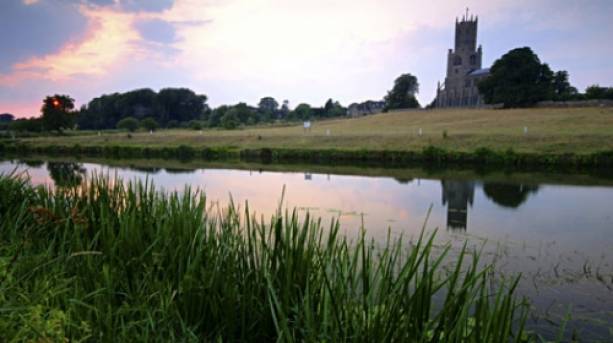
You may be interested in...
Explore the beautiful and curious Rushton Triangular Lodge
This place is proof that in England you'll find architectural treasures in the most unlikely places.
Location: Kettering, Northamptonshire
Explore a living canal village
The Grand Union Canal at Stoke Bruerne is like an outdoor museum with historic canal features to explore.
Location: Stoke Bruerne, Northamptonshire
Wander a tranquil 1920s garden
The 10-acre gardens of Coton Manor sit in peaceful Northamptonshire countryside.
Location: Coton, Northamptonshire
We've something we want to share
Want to receive travel tips and ideas by email?
VisitEngland would like to invite you to take part in a short survey about our website, it should take no more than a couple of minutes.
Go to the survey
To add items to favourites …
… you need to be logged in.
If you already have an account, log in.
Or register a new account
Access your account

- Where to Stay Homepage
- Bed & Breakfast
- Hotels & Guest Houses
- Self Catering
- Farm Accommodation
- Camping & Caravanning
- Holiday Parks
- Groups and Occasions
- Canals & Waterways
- Serviced Apartments
- Useful Links
- Accommodation Directory
- Food & Drink Homepage
- Restaurants
- Pubs & Bars
- Coffee Shops & Tea Rooms
- Cafés & Snack Bars
- Fast Food & Takeaway
- Farm Shops & Markets
- Local Producers
- Shops & Delicatessens
- Cookery & Nutrition
- Food & Drink Directory
- Shopping Homepage
- Retail Parks & Shopping Centres
- Shopping Villages
- Supermarkets
- Markets & Car Boot Sales
- Food & Drink
- Home & Garden
- Antiques & Vintage
- Clothing & Fashion
- Health & Beauty
- Sport, Leisure & Outdoors
- Hobbies, Crafts & Gifts
- Games, Toys & Books
- Technology & Electrical
- Online Shopping
- Shopping Directory
- Out & About Homepage
- Family Attractions
- Children's Activities
- Youth Activities
- Parks and Open Spaces
- Gardens and Habitats
- Houses & Stately Homes
- Historic Landmarks
- Historic Churches
- Museums & Galleries
- Craft & Creative Arts
- Music, Theatre & Entertainment
- Sport & Leisure
- Outdoor Activities
- Rivers and Waterways
- Motorsport & Aviation
- Experiences
- Out and About Directory
- What's On Homepage
- Events This Month
- Events Next Month
- Today's Events
- Music, Theatre & Arts
- Shows, Fairs & Festivals
- Community & Wellbeing
- Families & Children
- Countryside & Rural
- History & Heritage
- Business & Training
- Entertainment Directory
- About Northamptonshire
- Getting Here
- Getting Around
- A County of Spires
- A County of Squires
- A Grand Day Out
- Glorious Countryside
- Meandering Waterways
- The Home of Motorsport
- Boots & Shoes
- Explore Places
- Northamptonshire Towns
- Northamptonshire Villages
- Explore The Nene Valley
- Directory Homepage
- Accommodation
- Agriculture & Farming
- Animals & Pets
- Arts, Music, Theatre & Culture
- Attractions & Activities
- Building, Construction & Maintenance
- Business & Office Services
- Education, Learning & Training
- Entertainment
- Finance, Insurance & Legal
- Health & Social Care
- Hobbies & Pastimes
- Holidays & Travel
- Industry & Manufacturing
- IT, Media & Communications
- Logistics & Storage
- Nature & Wildlife
- Out & About
- Public Services & Amenities
- Recruitment & Careers
- Shopping & Retail
- Weddings & Celebrations
- A to Z of Categories
Fotheringhay Castle

Fotheringhay Castle is the remains of a large, medieval motte-and-bailey castle.
The castle was built in the early 12th century by Simon de Senlis I, the Earl of Northampton who also built Northampton Castle.
It strategically overlooks a crossing point on the River Nene and it also acted as a royal palace and a prison from the 13th century.
Richard III was born at Fotheringhay in 1452.
Mary, Queen of Scots was imprisoned in the castle in 1586 and executed there the following year.
Fotheringhay Rd Fotheringhay Northamptonshire PE8 5JF
- England Travel Tips
- England Books
- Luxury Hotels
- Adult Only Hotels
- Castle Hotels
- Boutique Hotels
- Romantic Hideaways
- Country House Hotels
- Shropshire Hotels
- England Holiday Cottages
- Derbyshire Cottages
- Devon Cottages
- Gloucestershire Cottages
- Kent Cottages
- Norfolk Coast Cottages
- Norfolk Broads Cottages
- South Norfolk Cottages
- Northumberland Cottages
- Northumberland Coastal Cottages
- Matlock Cottages
- Shropshire Cottages
- Suffolk Cottages
- Sussex Cottages
- Wiltshire Cottages
- Bed and Breakfast
- Holiday Parks in England
- Caravan Holiday Parks
- Glamping in England
- Glamping in East Sussex
- Glamping on a Working Farm
- England Holidays
- Things to do in England
- Northumberland
- Northamptonshire
- Gloucestershire
- Prehistoric England
Norman England
- Patron Saint of England
- English Monarchs
- Coronation of King Charles III
- Books about King Charles III
- King Charles III Coronation T-Shirts
- Coronation Decorations
- Coronation Gifts: Glasses
- Coronation Gifts: Mugs
- Coronation Cake Toppers
- Coronation Cookie Cutters and Embossers
- Watch the Coronation in a Royal Location!
- Royal Weddings
- English Food 101
- How to Make...
- Food Festivals
- Buy English Food Abroad
- Traditional English Recipes
- Breakfast Treats
- Brussels Sprouts
- Dinner & Supper
- English Desserts
- Jams & Pickles
- Mincemeat Recipes
- Sandwiches & Picnic Food
- Soups & Salads
- Teatime Treats
- England Gifts
- Gifts for Beatrix Potter Fans
- Cadbury Chocolate
- Denby Dinnerware and China
- Jane Austen Gifts
- Lucky Sixpence Gifts
- Portmeirion A Welsh-English Success Story
- Royal Albert Bone China
- Gifts for Tolkien Fans
- The Best Gifts for Sherlock Holmes Fans
Fotheringhay Castle Birthplace of a King and Execution Site of a Queen
The small Northamptonshire village of Fotheringhay sits peacefully next to the River Nene. It’s pretty much just one road with some lovely stone houses, many of which are thatched, an elegant church that appears too big for its parishioners, and a pub surrounded by rural farming landscape. Most people who find themselves travelling along this road will pass through and comment “that was a nice village”. But if you take the time to stop, you’ll be in for a pleasant surprise as this “nice village” is steeped in history centred around Fotheringhay Castle.
There's little left of Fotheringhay Castle, just the earthworks and one lump of stone masonry from the castle keep, so you may be excused for missing it. Though the earthworks are impressive and a quick climb up onto the motte gives grand views across the River Nene and surrounding countryside. What the earthworks don't reveal is that the castle was once the preferred residence of the dukes of York, and this sleepy village would have been a much busier place than it is today. In the church you can find signs of the royal connection including the tombs of Richard, 3rd Duke of York, the father of King Edward IV, and of Edward's brother, Edmund, Earl of Rutland, who were killed at the Battle of Wakefield. Also, on the wall of the church porch is a stone lion from a family coat of arms that was originally from the castle. And from the road, parts of the New Inn, a hostel for royal guests, are still visible.
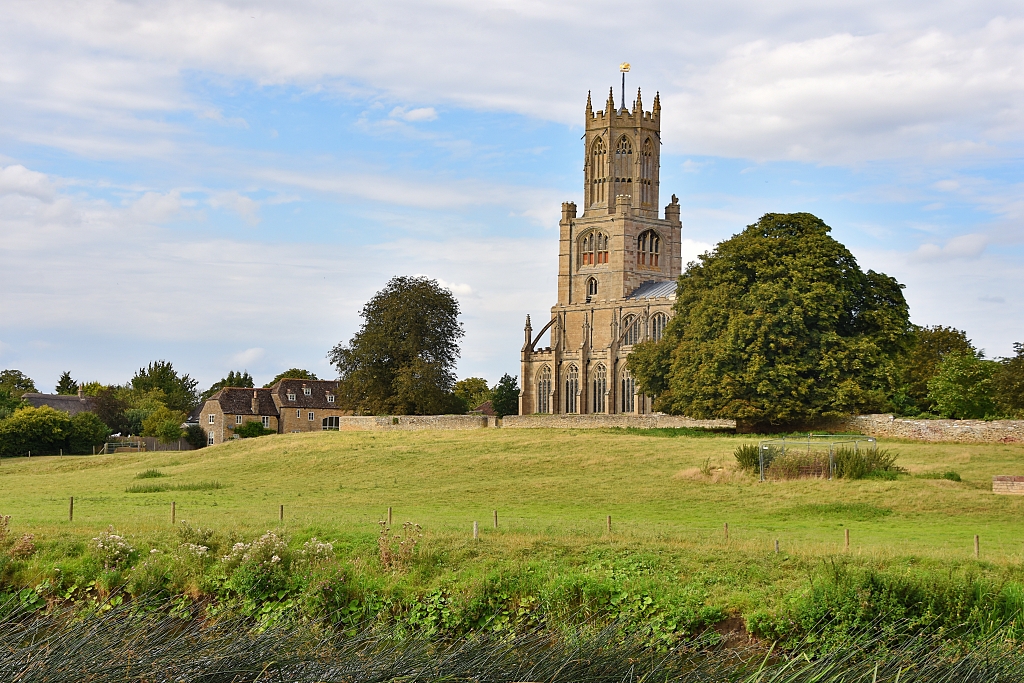
History of Fotheringhay Castle
After the Norman Conquest of 1066, William the Conqueror gave the land around Fotheringhay to his niece, Judith of Lens, who was the wife of Waltheof, Earl of Northumbria. Their eldest daughter, Maud, inherited the Fotheringhay estate and married Simon de Senlis, Duke of Northampton, around 1090. He also became the Earl of Huntingdon and in about 1100 built the first Norman castle at Fotheringhay to defend the river crossing.
Simon died in 1113 and Maud went on to marry Prince David of Scotland. David became King of Scotland and gained Fotheringhay Castle along with other property across Huntingdonshire. Ownership then descended through the Scottish princes until 1219 when King John of England seized the castle.
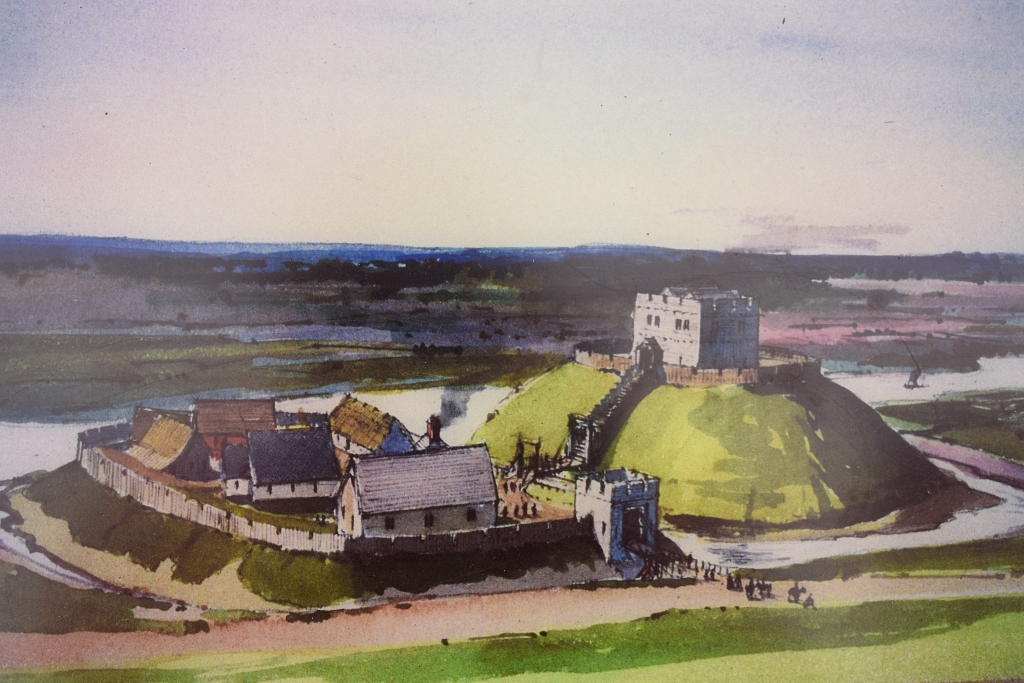
Over the next 150 years, Fotheringhay Castle changed hands many times and was home to several barons. In 1377, the castle came back under royal control when the countess of Pembroke died and King Edward III then gifted Fotheringhay Castle to his son, Edmund Langley. In 1385, Edmund was created the 1st Duke of York and the castle became his primary residence, establishing the powerful House of York.
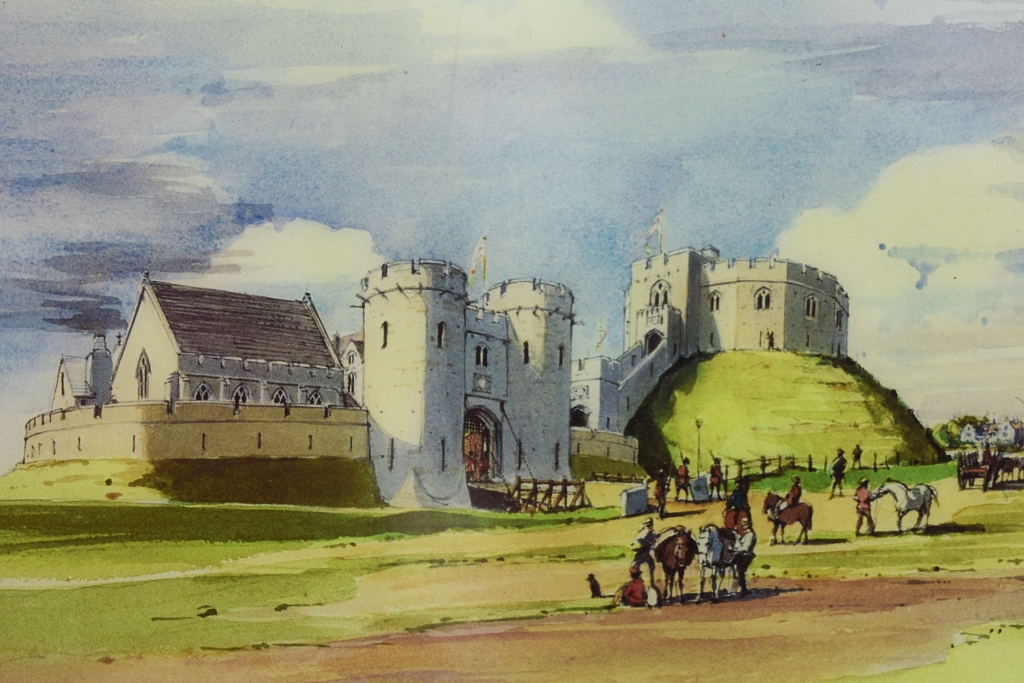
Edmund spent a lot of money on strengthening and improving the living conditions of his castle, making it a comfortable residence and administration centre. When he died in 1402, his eldest son, Edward, inherited the castle and title. Edward founded a small monastery at the castle for a group of monks to say prayers for the York family. In 1411, a cloister, choir, and chapel were added to the existing Norman church on the site of the present Church of St. Mary and All Saints. The monks left the castle and moved into the church. Edward died in 1415 and as he was childless Fotheringhay Castle passed to his nephew Richard who was three years old at the time.
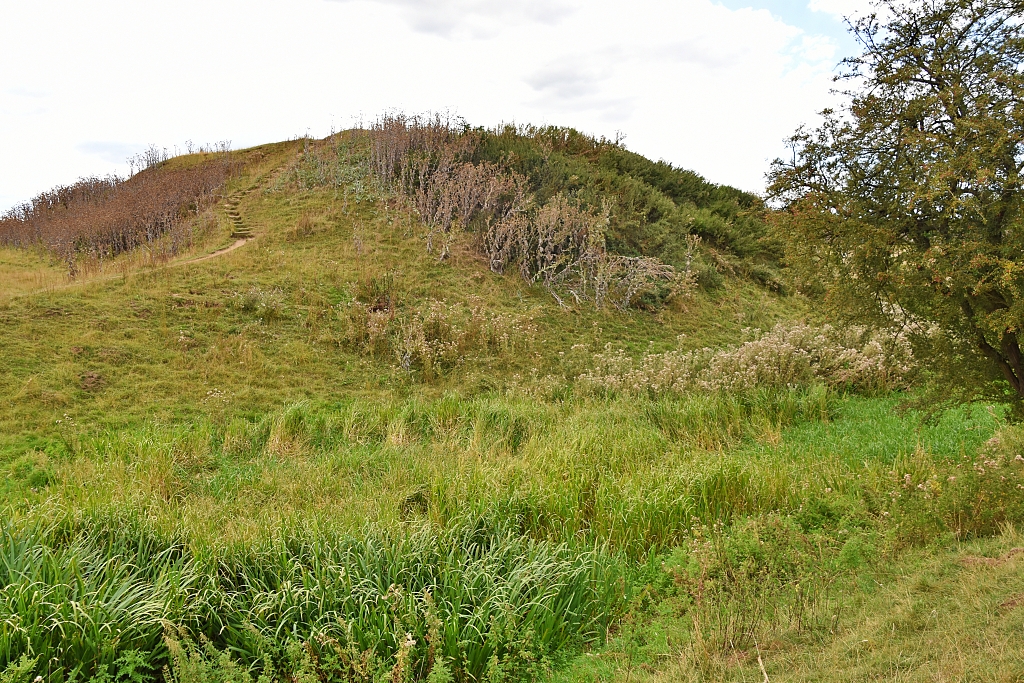
Ralph Neville, the Earl of Westmorland, and head of the influential northern Neville family, was approved as Richard’s guardian, and eventually married the young man to his daughter, Cecily.
Despite the itinerant lifestyle of most noble families of the time, Richard, the 3rd Duke of York, and his wife kept Fotheringhay Castle as a favoured residence and in 1434 started to rebuild the Parish Church. It was a much larger building than we see today and the complex housed around 30 monks.
The couple went on to have twelve children. Five died very young and two would become Kings of England.
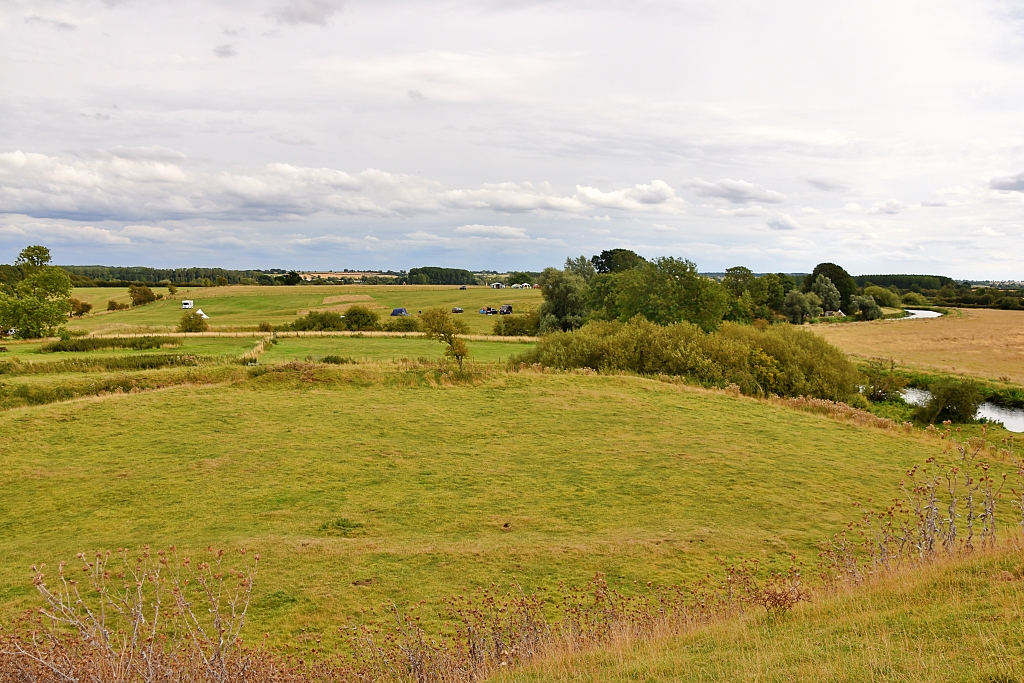
King Edward IV was the first son to be crowned King. Born in 1442 whilst the family was living in Rouen in France, he succeeded King Henry VI in 1461 and reigned, apart from a short spell of exile in Flanders, until his death in 1483. He enjoyed Fotheringhay Castle and commissioned many changes around 1465.
Richard and Cecily's youngest son Richard - destined to rule England as King Richard III - was born at Fotheringhay Castle in 1452. He reigned from 1483 until his death at the Battle of Bosworth in August 1485, which ended the Wars of the Roses and the rule of the House of York.
Richard of York died alongside his second son, Edmund, at the Battle of Wakefield in 1460. His wife, Cecily, continued living in Fotheringhay Castle and benefitted from the changes her eldest son, King Edward IV, made to the castle which included building the New Inn, just outside of the castle’s defences, to accommodate visitors. Part of the New Inn is called the “Queen of Scots Archway” and may have been where Mary Queen of Scots was held prisoner in 1586.
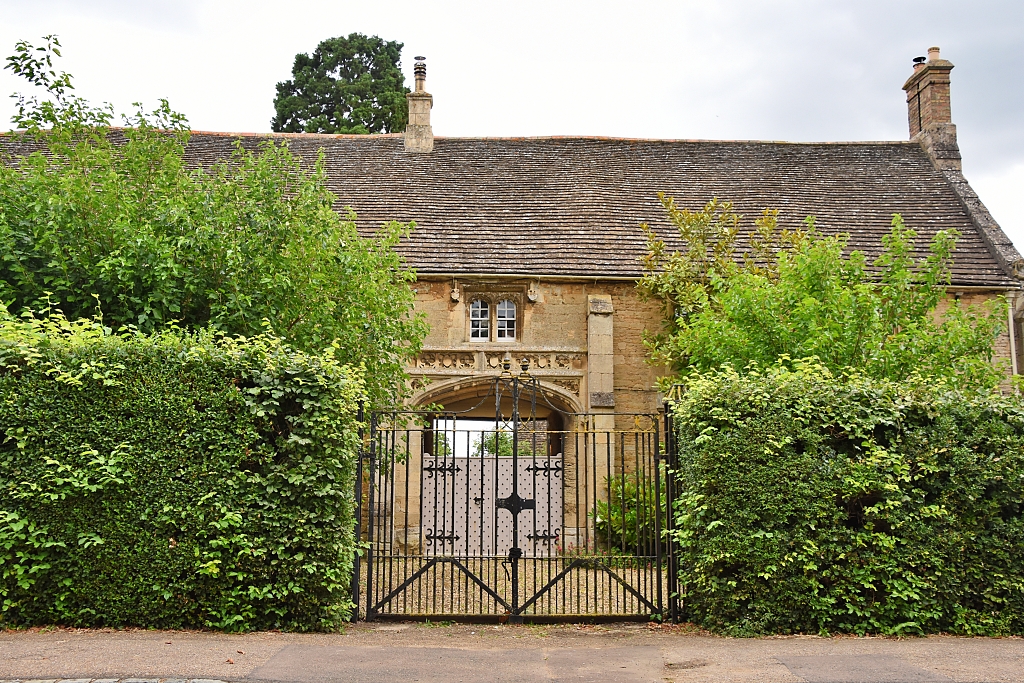
After the death of King Richard III in 1485, King Henry VII bestowed Fotheringhay Castle to his wife Elizabeth of York. She stayed there many times along with his mother, Lady Margaret Beaufort, who had around forty rooms renovated for her household in 1505.
After the death of King Henry VII, the castle passed on to the new King of England, King Henry VIII, in 1509. The castle was little used and started to slowly fall into decline. Henry VIII presented the castle to his successive wives, the first being Catherine of Aragon in 1533. She liked the castle and started refurbishments.
By the time Queen Elizabeth I was crowned in 1558 Fotheringhay Castle was in decline once more. Elizabeth I never stayed at the castle, and instead started to use it as a state prison. Its most famous prisoner was Mary, Queen of Scots who was moved from Sheffield after 18 years of imprisonment to a more secure environment at Fotheringhay in 1586. She was convicted of treason, and after two months of waiting was beheaded in the castle’s great hall on the 8th of February 1587.
Within fifty years of the execution of Mary Queen of Scots, the castle was in a state of disrepair and demolished.
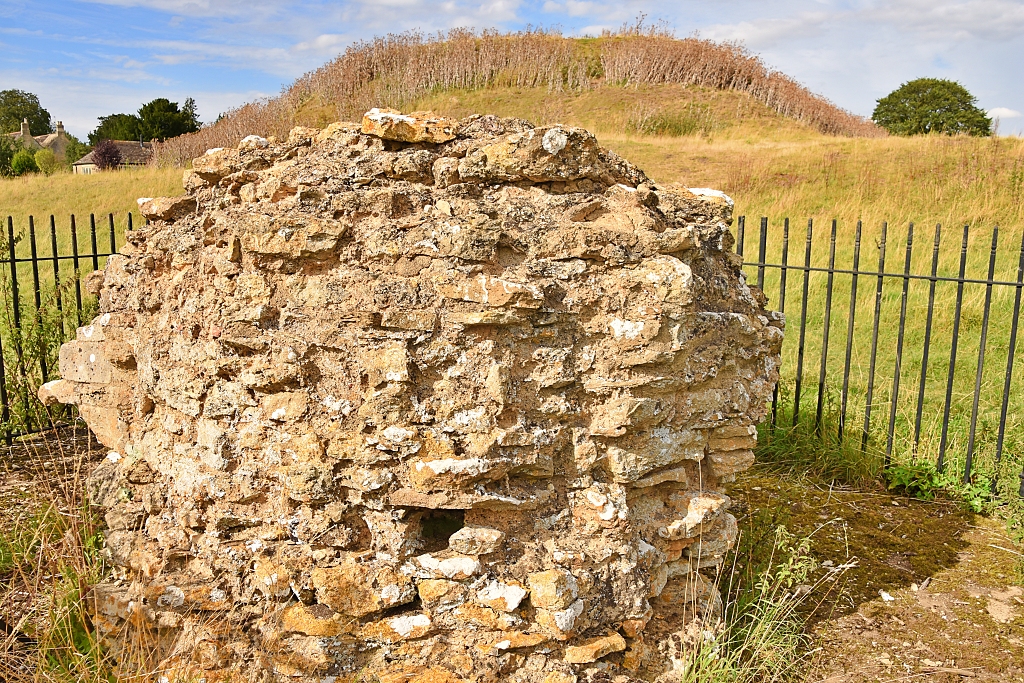
Visiting Fotheringhay Castle
The castle can be found down a signposted footpath between Castle Farm Guest House and the “New Inn”, now a private home, on the sharp bend as the road goes through the village. The site is free to enter and open during day light hours. Use the postcode PE8 5HZ in your SatNav and park carefully along the street.
To get the best out of your visit make sure you walk through the village to St. Mary and All Saints Church, and possibly add a pub lunch at the very popular Falcon Inn .
Or you could try our 5-mile circular Fortheringhay walk to discover more about this pretty part of the Nene Valley.
Northamptonshire Holiday Cottages
Northamptonshire is a largely rural county in the centre of England, renowned for shoemaking, stunning countryside, and very pretty villages. It makes a great place for walking and cycling and is ideal for a relaxing holiday or short break.
Below, we've collected some holiday cottage ideas. Personally, I would love to stay in Stoke Bruerne, right next to the canal. Stoke Bruerne is a friendly, pretty village with a couple of pubs, an Indian restaurant, and easy walking from the door.
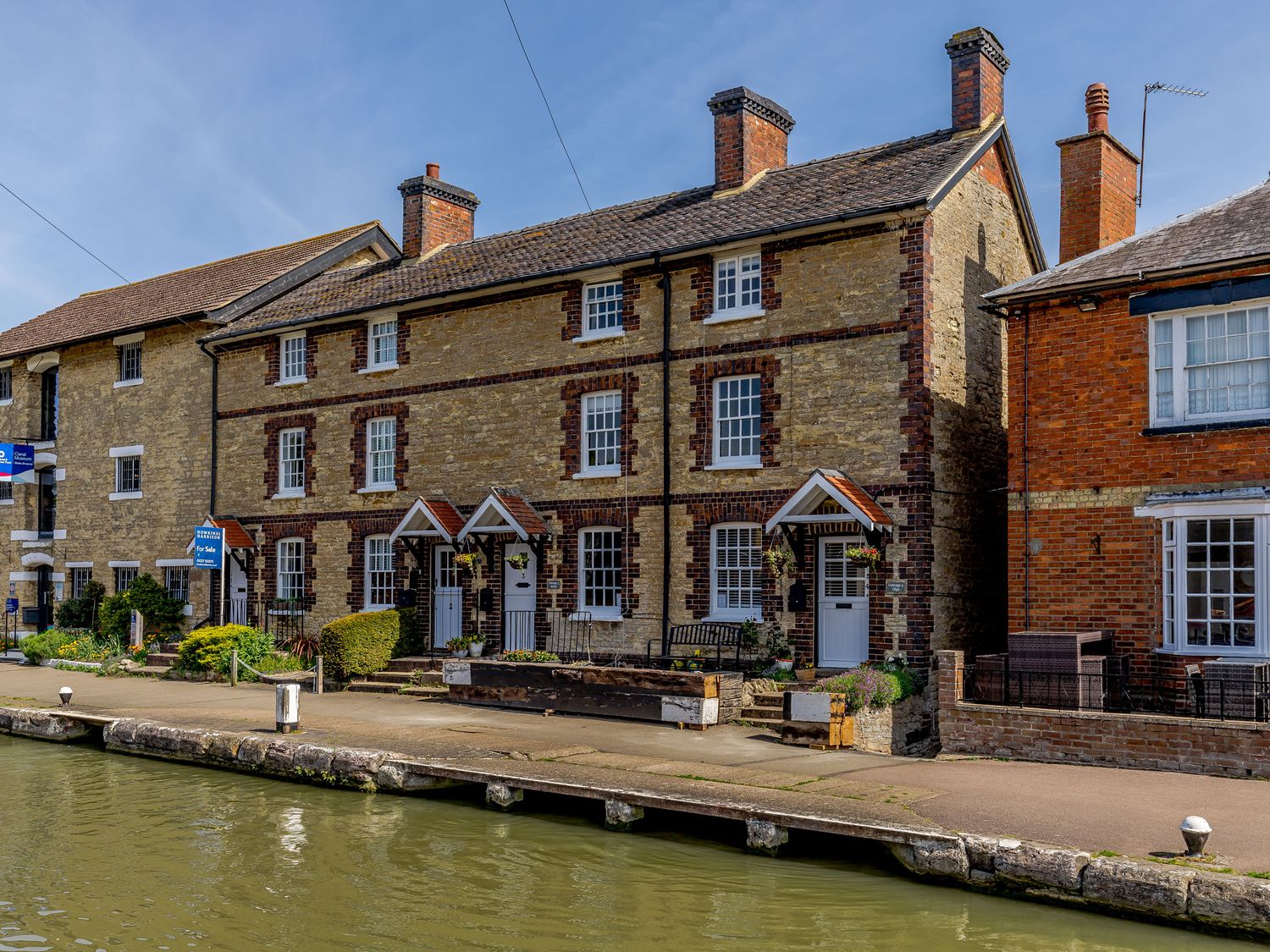
3 Canalside Cottages Stoke Bruerne Sleeps 4
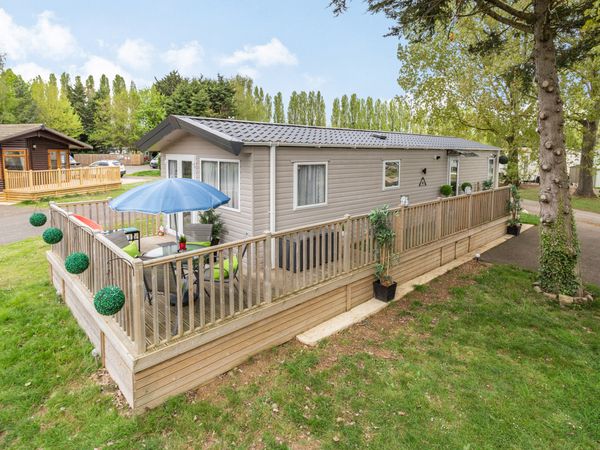
9 Kingfisher Lake Northampton Sleeps 5
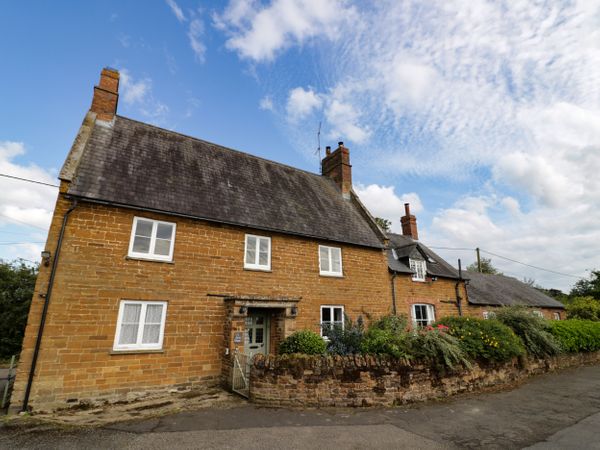
Hill House Farm Nether Heyford Sleeps 10
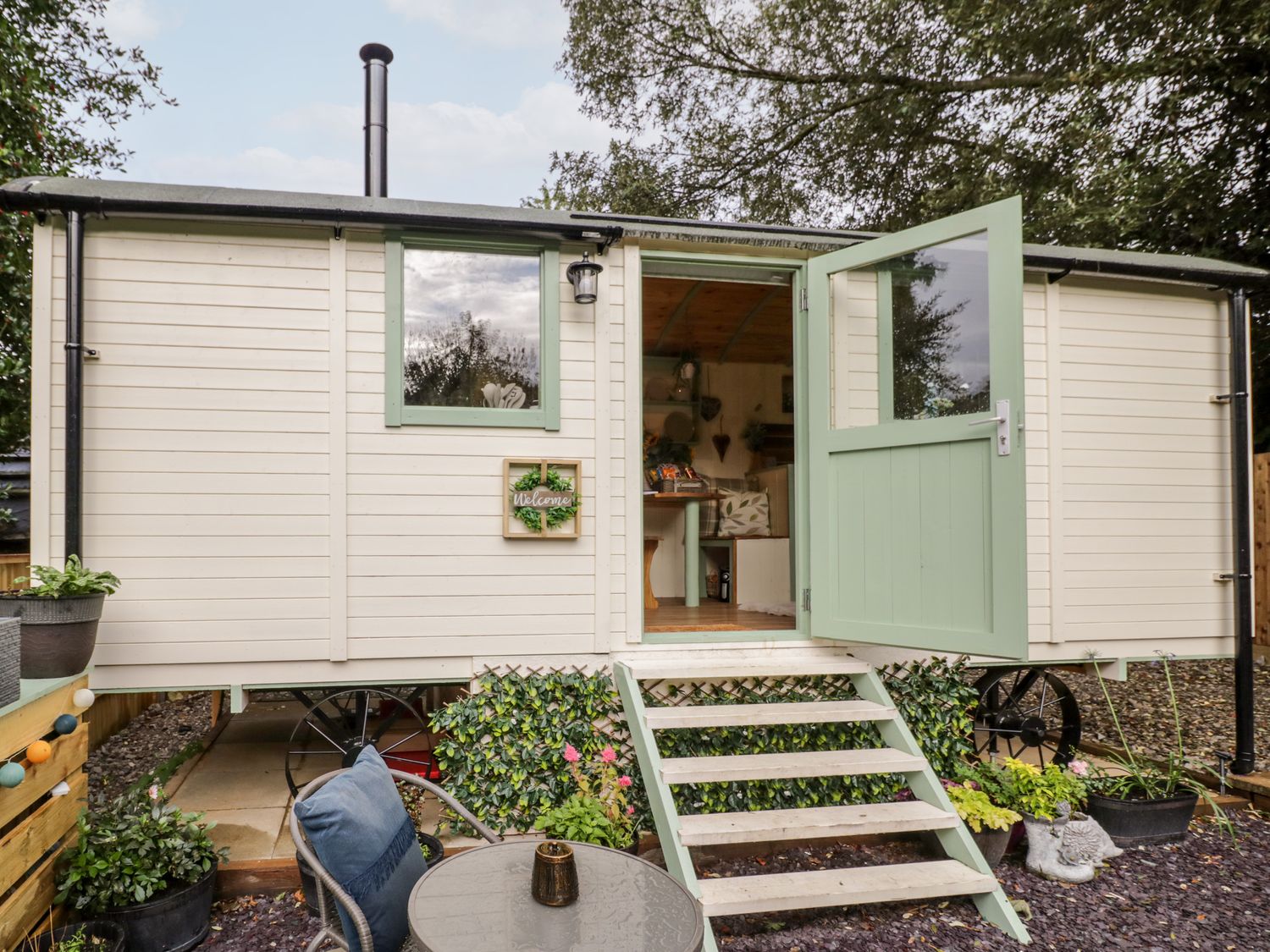
Cobblers Cabin Northampton Sleeps 2
Deerpark barn near daventry sleeps 4, carpenters barn staverton sleeps 6.
To browse holiday cottages in other parts of England click here , or you could use our Booking.com search box.
For more things to do in Northamptonshire return from our Fotheringhay Castle page to our Northamptonshire page .

Essentially England uses affiliate links. This means that if you purchase something through a link on this site, we may earn a commission (at no extra cost to you).
You May Also Like

Secret Northamptonshire

50 Gems of Northamptonshire
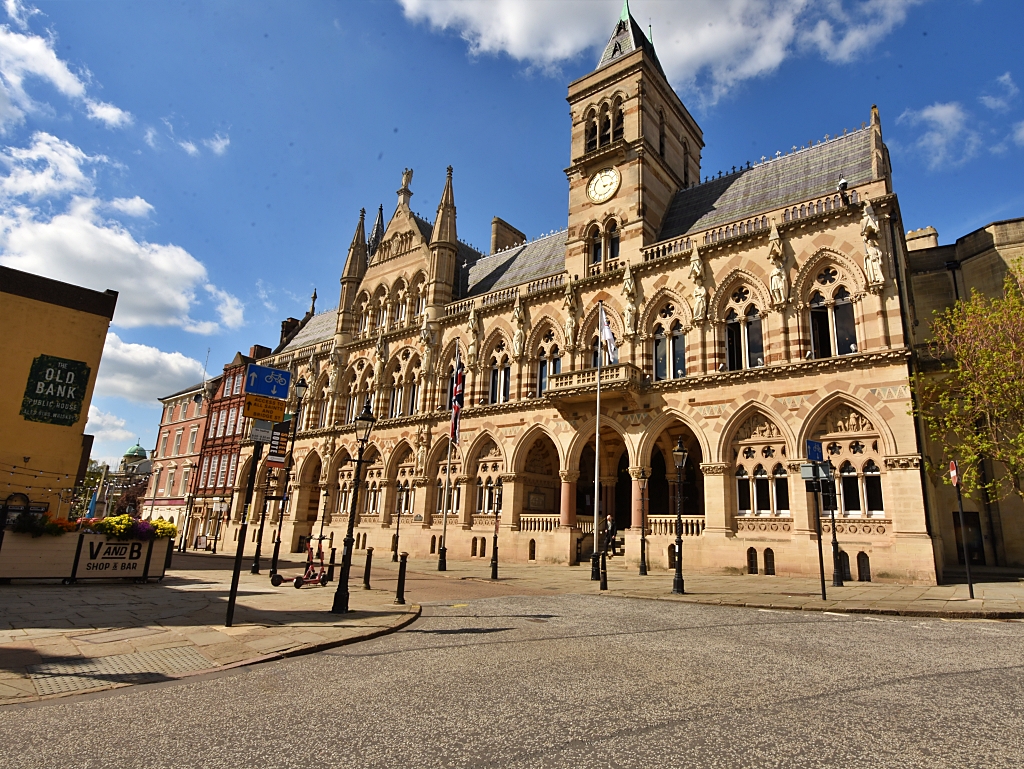
Discover Northamptonshire with Essentially England
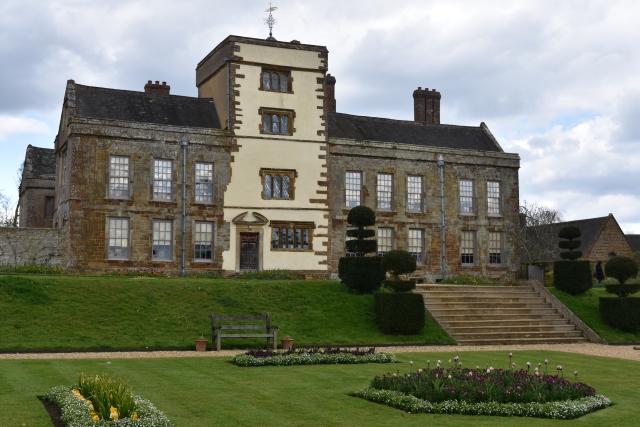
Tripadvisor: Explore Northamptonshire

Northamptonshire Trig Bagger

1066: Year of the Conquest

The 1066 Country Walk

The Godwins

The Norman Conquest

The Anglo-Saxon World
Home | Blog | About Us | Contact Us Terms of Use | Acceptable Use | Privacy and Cookies | General Advertising Policy | Advertise on Essentially England © Copyright Essentially England 2007-2024. All Rights Reserved.

- Information
Fotheringhay
Fotheringhay is a sleepy Northamptonshire riverside village with a magnificent stone church and the earthworks of an ancient castle, which have long since been forgotten.

The village and its demolished castle hide a grim secret. It was here on 8th February 1587 that Mary Queen of Scots was executed, on the orders of Elizabeth I. The Queen’s body was initially buried in Peterborough Cathedral but was later exhumed by her son James l, and laid to rest in Westminster Abbey next to her cousins Elizabeth l and Mary Tudor.
Just fifty years later the castle was totally dismantled and all that remains today is a low grassy mound by the river. The castle stonework was sold off for local building material and parts of it can be found in buildings all around the county, including the Talbot Inn at Oundle .

The original fortification was established in the 12th-c by Simon de Senlis, Earl of Northampton. It was rebuilt and extended in the 14th-c by the son of Edward III. Richard III, the last Plantagenet and Yorkist king of England, was born there in 1452. So little of the castle remains today that unless you know where to look you would be hard pressed to believe that it ever stood here. The thistles that grow on the mound are said to have sprung from seeds scattered by Mary Queen of Scots during her stay.
The road to village runs through the beautiful rolling Northamptonshire countryside and crosses an 18th-c stone bridge, spanning the River Nene near the castle mound. The main village street is lined with quaint stone and thatch cottages. Many of the dwellings have very low doorways, indicating their antiquity. Several old inns still remain, including the old Falcon Inn, just behind the church.
The jewel in Fotheringhay's crown is the magnificent church of St Mary and All Saints. Founded as part of a college in 1411, it was partially demolished after the Dissolution of the Monasteries. All that now remains is the nave, aisles and the west tower. Despite its reduction the church is still an impressive sight with massive arc flying buttresses. The octagonal lantern tower is topped by a golden falcon, the emblem of the House of York.
Map of Fotheringhay
The Midlands

Towns and Villages in Northamptonshire
Attractions in Northamptonshire
Travel About Britain © 2024 All Rights Reserved About Us | Privacy & Cookies | Website Terms
Fotheringhay Castle
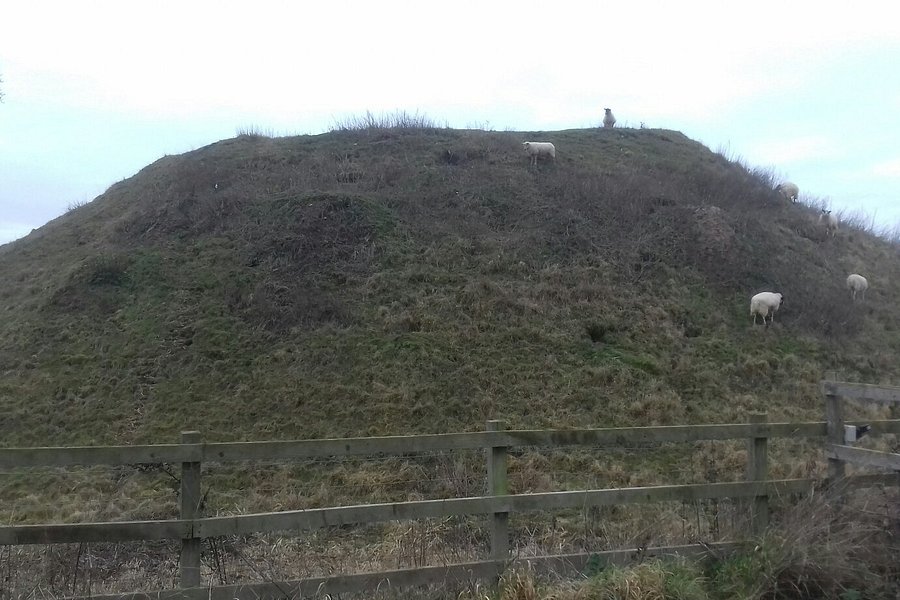
Top ways to experience nearby attractions

Most Recent: Reviews ordered by most recent publish date in descending order.
Detailed Reviews: Reviews ordered by recency and descriptiveness of user-identified themes such as wait time, length of visit, general tips, and location information.
Fotheringhay Castle - All You Need to Know BEFORE You Go (2024)
- (0.16 mi) Fotheringhay Castle Farm Campsite
- (1.60 mi) The Crown Inn Elton
- (3.32 mi) The Talbot Hotel, Oundle
- (3.73 mi) Landal Rockingham Forest
- (7.74 mi) Rowan House
- (0.26 mi) The Falcon Inn
- (1.31 mi) The Red Lion
- (1.69 mi) The Black Horse
- (1.73 mi) Mulberry Cafe
- (3.30 mi) Rose & Crown
- (0.04 mi) Fotheringhay Village
- (0.29 mi) Fotheringhay To Warmington Nene Way Walk
- (2.64 mi) UK Parachuting
- (2.72 mi) Adventure Nene
- (7.70 mi) Aerospace Experience Flight Simulators

The History of England
Great history podcasts from the shed, fotheringhay.
- 13/14 Centuries
- Lancastrians
- Plantagenets 1216 - 1485
- Richard III
- Wars of the Roses

Home to the Dukes of York
It is a lovely place to visit if you are near the area, a beautiful; stone village by the banks of the river Nene in Northamptonshire. There’s what remains of the castle, a quite magnificent church, a pretty stone bridge, views across the green fields and river, and a good pub for afters. And if you can’t see half a billion falcon images you are not trying hard enough.

Trial and execution of Mary, Queen of Scots

But in 1586, Elizabeth’s spy master Walsingham caught Mary in a an exchange in incriminating letters. Mary was rushed to Fotheringhay, and there in the Great hall of this relatively small castle, she was put on trial in front of 36 noblemen – and convicted. Still it took months to persuade Elizabeth to sign a warrant for her execution, but finally she gave way. Before she could change her mind, the order was rushed to Fotheringhay and arrived on the morning of 7th February where an astonished Mary was told to prepare herself – for she would die the following morning.

“One of the women then tied the handkerchief over her eyes. The Queen quickly, and with great courage, knelt dawn, showing no signs of faltering. So great was her bravery that all present were moved, and there were few among them that could refrain from tears. In their hearts they condemned themselves far the injustice that was being done.”

Fotheringhay’s great days were largely over. The Chancel of the massive church was pulled down in 1553 during the dissolution of the monasteries. The castle was levelled in the 1630’s. What’s left is a beautiful echo of it’s former glories – the lovely stone church across the river, and signs of grand stones and carvings in the village houses.
10 thoughts on “ Fotheringhay ”
Sensitively written. Thank you.
Very nice and I do like this new website.
Excellent, thanks David. It is a little more shiny than the last one…
thanks, David. Gorgeous and historic place.
Yes, it was a nice day out with the aged M, nice views across the River Nene
Excellent little article, keep ’em coming! Can I offer a tiny bit of improvement for us poor uneducated foreigners; a thumbnail map at the top of the article to show where Fotheringhay is located might be of use to us. Being geographically challenged I must admit that in spite of having spent a good deal of time in Britain from time to time I really can’t locate Fotheringhay (or The Nene) from memory. Of course ten seconds with Google maps or something will show me where it is, but that’s ten seconds away from your article. Just a thought. Also, Merry Christmas!
Hi Jan…and yes, good idea! I’ll do for the next one
I recently became a member and I want to take this opportunity to tell you how much I am enjoying and learning from your podcast. You rock! I love your wit, enthusiasm and incredible (hi)story telling ability.
I am in a Shakespeare reading group (current project Richard III), so I am devouring anything I can find on the Cousins’ War (I now call it this because of you). In this article on Fotheringhay, you say that the church was built by the “2nd Duke of York, Edmund of Langley, who was killed at Agincourt in 1415, and continued by his son Richard who’s sons Edward and Richard would both be kings” If I am reading my family tree right, The 2nd Duke of York was Edward of Norwich, Edmund’s son. Richard, 3rd Duke of York and father of the future kings was Edward’s nephew by his brother Richard, Earl of Cambridge not his sons, as he did not have any. I am working so hard on trying to keep everyone straight. Am I correct, or should I just go jump in a lake? Thanks for all you are doing!
Darn you are quite right. The 2nd Duke of York died childless at Agincourt. It was the 1st Duke’s son Richard of Coninsborough, Earl of Cambridge, who was executed by Henry V for treason in 1415, who was father to Richard of York, father to Edward and Richard. I shall change the text…which will make this exchange look a little odd, but people will understand! And thanks for the kind words, and especially for being a member!
Hi David please email me I have a few questions I’d like to ask about Yorkshire History. thank you
Leave a Reply Cancel reply
Save my name, email, and website in this browser for the next time I comment.

Fotheringhay Village

Top ways to experience nearby attractions

Most Recent: Reviews ordered by most recent publish date in descending order.
Detailed Reviews: Reviews ordered by recency and descriptiveness of user-identified themes such as waiting time, length of visit, general tips, and location information.
FOTHERINGHAY VILLAGE: All You Need to Know BEFORE You Go (with Photos)
- (0.16 mi) Fotheringhay Castle Farm Campsite
- (1.64 mi) The Crown Inn Elton
- (3.28 mi) The Talbot Hotel, Oundle
- (3.74 mi) Landal Rockingham Forest
- (7.77 mi) Rowan House
- (0.26 mi) The Falcon Inn
- (1.31 mi) The Red Lion
- (1.72 mi) The Black Horse
- (1.76 mi) Mulberry Cafe
- (3.26 mi) Rose & Crown

Sign Up Today
Start your 14 day free trial today
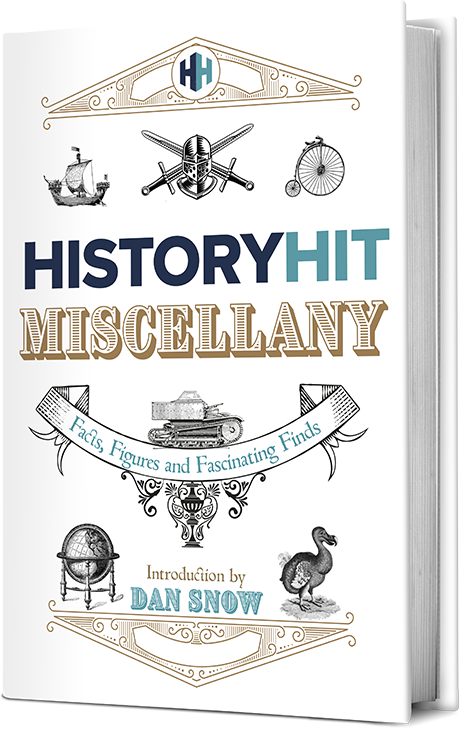
The History Hit Miscellany of Facts, Figures and Fascinating Finds
- United Kingdom
Historic Sites Associated with Mary Queen of Scots
Discover the historical places relating to mary queen of scots, from fotheringhay castle, lochleven castle, and more..

Lucy Davidson
27 dec 2022, @lucejuiceluce.
If you’ve ever wondered ’where did Mary Queen of Scots live?’ or, ‘where did Mary Queen of Scots spend her time?’, then we’re here to help.
Visit the places that Mary Queen of Scots called home, those that became her prison, and a number of other historic sites that relate to her famous life. There’s a host of popular historical places which relate to Mary Queen of Scots, and among the very best are Fotheringhay Castle, Edinburgh Castle, and Stirling Castle.
We’ve put together an expert’s guide to historical sites linked to Mary Queen of Scots, including our top places to visit as well as a full list of sites which you should check out if you’ve got time.
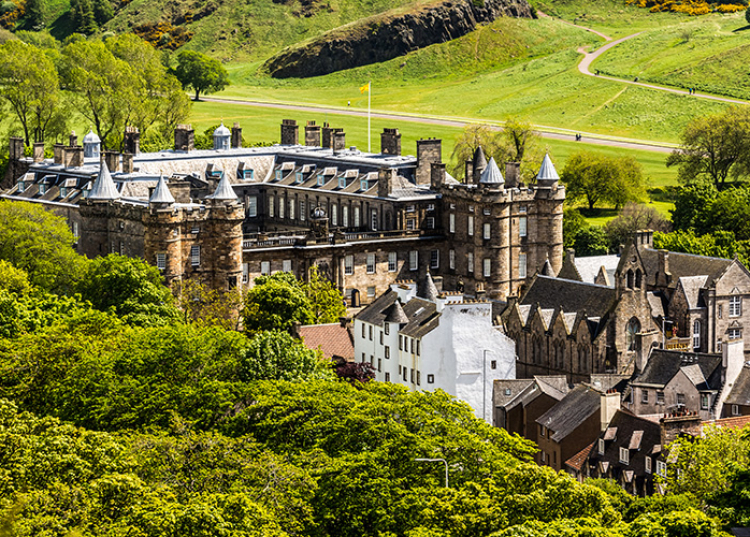
1. Holyroodhouse Palace
Holyroodhouse Palace is the Scottish royal residence famed as having been home to Mary Queen of Scots. Not only was the palace Mary’s main home between 1561 and 1567, it was where she married two of her husbands. It was also at Holyroodhouse Palace that she was witness to the murder of her private secretary by her husband.
Today, visitors can see the ruins of the abbey of Holyroodhouse as well as touring the palace and the royal apartments. A visit to the site usually lasts around an hour to an hour and a half.
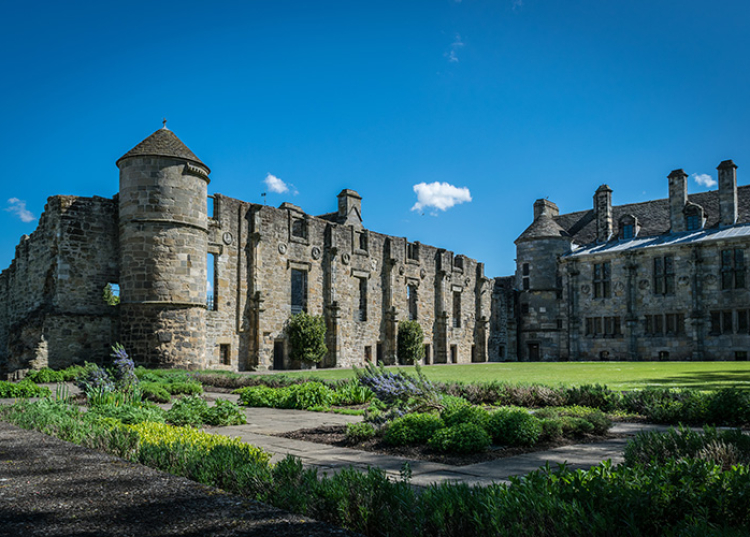
2. Falkland Palace
Falkland Palace was the country retreat and hunting lodge of the royal Stuart dynasty and a favourite home of Mary Queen of Scots.
Begun in 1450 and completed in 1541, Falkland Palace was the work of kings James IV and James V and was very much a regular retreat of Mary Queen of Scots. The highlights of Falkland Palace today are its gardens and portraits of the Stuarts.
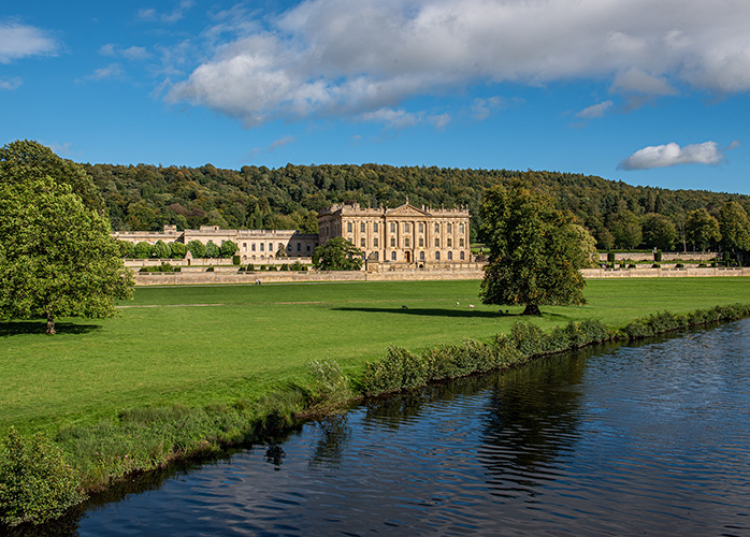
3. Chatsworth House
Chatsworth House is an English country estate that once served as the prison of Mary Queen of Scots. Today Chatsworth is open to the public and boasts a wealth of interesting art, furniture and antiques as well as exceptional architecture.
Visitors can explore a number of stunning rooms and displays as well as taking an audio tour.
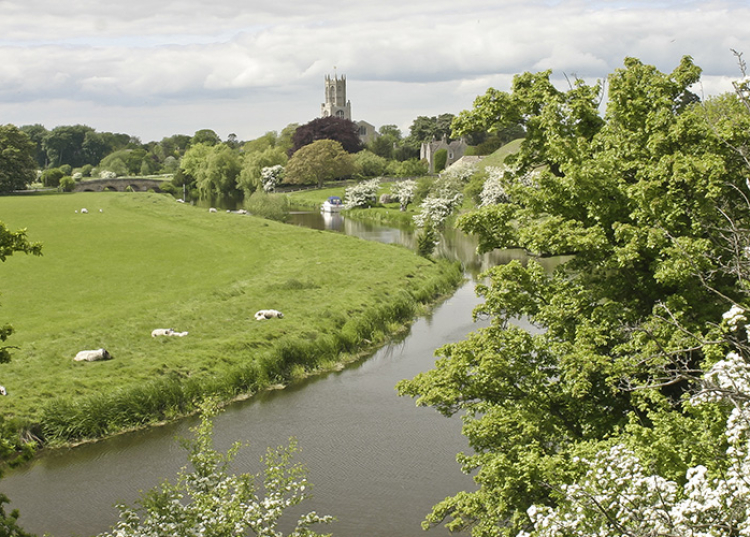
4. Fotheringhay Castle
Birthplace of Richard III and site of the trial and execution of Mary Queen of Scots, this Norman motte and bailey castle is now a ruin – in fact very little is left of it today.
Fortheringhay Castle is easily accessable during daylight hours, and should delight those interested in medieval history, the Wars of the Roses and Elizabethan politics
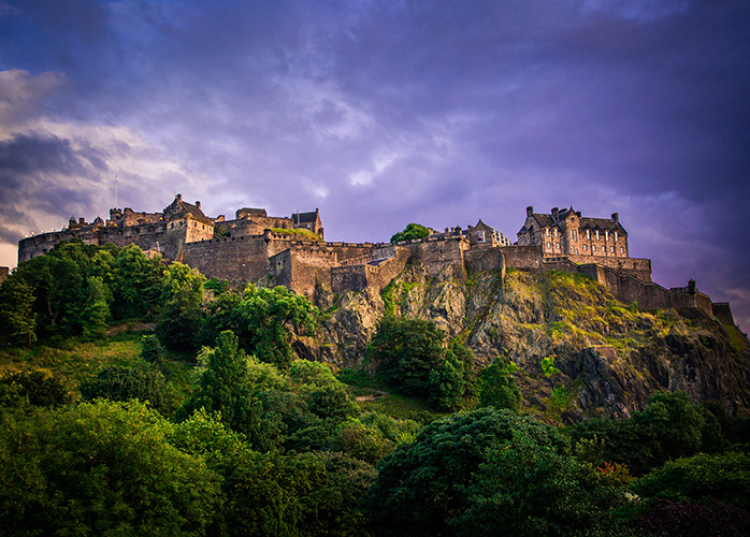
5. Edinburgh Castle
A royal residence, a vital stronghold and an iconic structure, Edinburgh Castle is one of the most famous castles in the world. The castle was the site of the birth of King James VI, also James I of England from 1603, to Mary Queen of Scots in 1566. Visitors can still see the small room where this monarch was born.
Today, visitors to Edinburgh Castle can explore the history through a series of guided tours and exhibitions. Amongst its many attractions are the Scottish National War Memorial and National War Museum, the Mons Meg and the Great Hall.
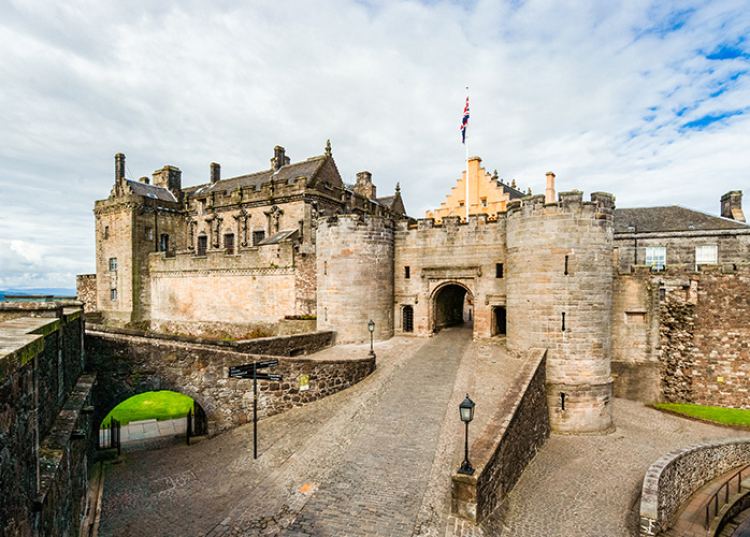
6. Stirling Castle
Stirling Castle is an iconic royal palace which was the location of the coronation of Mary Queen of Scots in 1543.
Today, Stirling Castle offers tours around its buildings and grounds. Visitors can tour with an audio guide or with a tour guide and there are a range of exhibitions to see. Not least of these is the Regimental Museum, a military museum dedicated to the Argyll
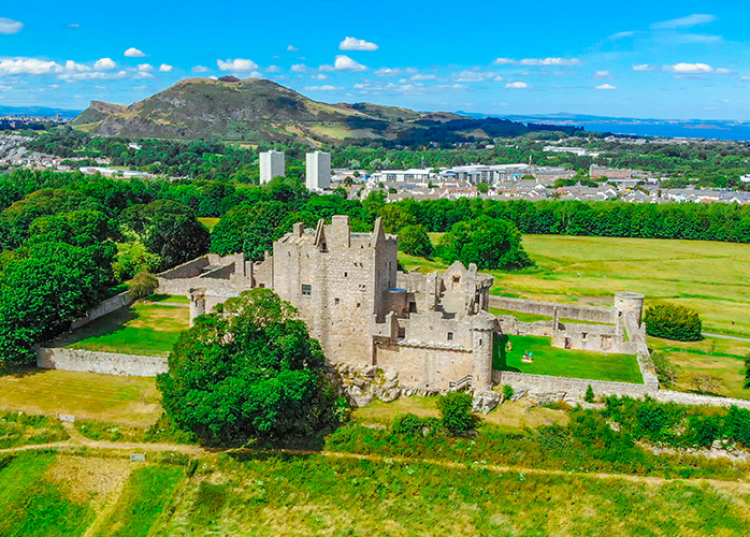
7. Craigmillar Castle
Craigmillar Castle was built from the fourteenth century and is now a pretty and well-preserved medieval ruin. The most famed aspect of Craigmillar Castle was that it played host to Mary Queen of Scots when she was recovering from an illness. It is also the namesake of a pact between several noblemen to murder her husband, Lord Darnley.
Today, several aspects of the fourteenth century structure of Craigmillar Castle remain, including an impressive tower. There is also a maze of medieval tunnels.
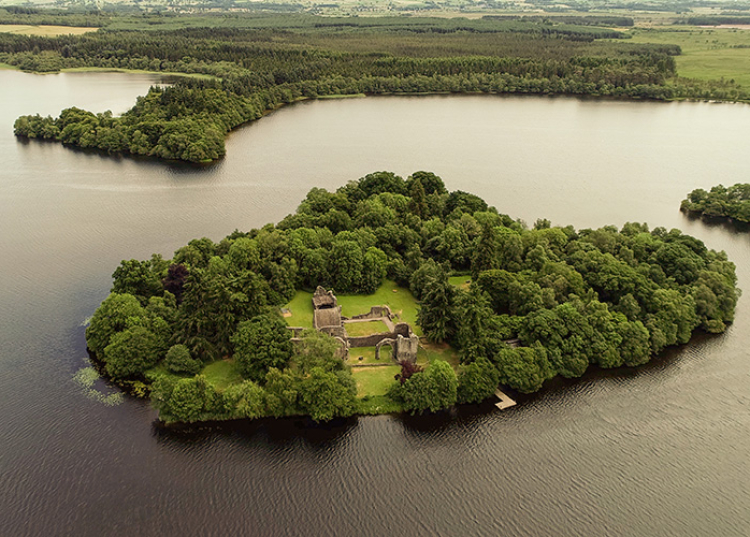
8. Inchmahome Priory
Inchmahome Priory was first founded as an Augustinian monastery in approximately 1238 under the instructions of the Earl of Menteith. Over the centuries, Inchmahome Priory’s secluded location made it an ideal refuge.
Even royals saw Inchmahome Priory as a sanctuary, including King Robert Bruce. However, it is more famous for the time when a young Mary Queen of Scots sheltered there in 1547 following the Scottish defeat at the Battle of Pinkie. Today, its picturesque ruins are a major tourist attraction.
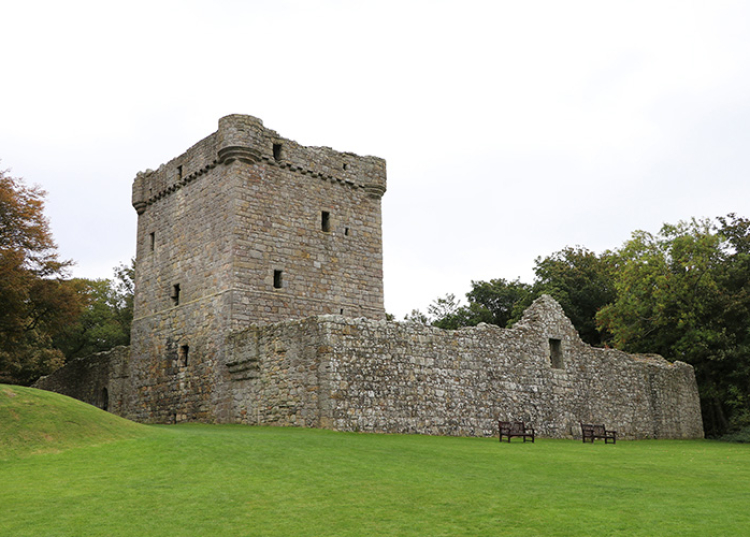
9. Lochleven Castle
Lochleven Castle was a medieval island stronghold, the dramatic ruins of which can be reached by boat. Whilst being most well known for being the prison of Mary Queen of Scots, Lochleven Castle’s role within Scottish royal history extends far further.
Many royals were guests – as opposed to prisoners – at Lochleven Castle, including King Robert Bruce and even Mary herself. What’s more, other royals were imprisoned at Lochleven Castle other than Mary Queen of Scots, particularly the (then future) Robert II. Mary was imprisoned at Lochleven Castle by Sir William Douglas from 1567 and forced to abdicate her throne in favour of James VI, her own infant son. She would escape within a year.
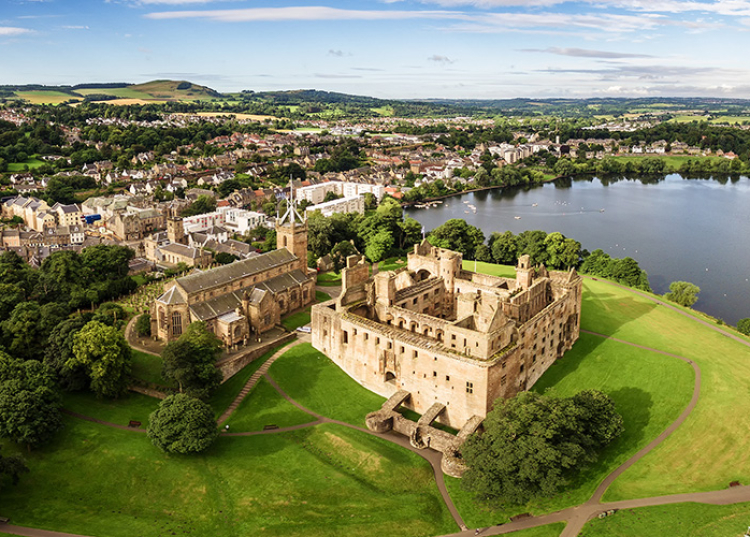
10. Linlithgow Palace
Linlithgow Palace was built in the fifteenth century on a site with a history dating back thousands of years.
It was James I who began building Linlithgow Palace in 1424. In 1542, Linlithgow Palace also became the birthplace of Mary Queen of Scots, although the room in which she was born no longer exists. From 1603, Linlithgow Palace’s era as a royal pit stop began to deteriorate as the royal court moved to London under James VI. The palace’s decline was confirmed when it was destroyed by a fire in 1745.
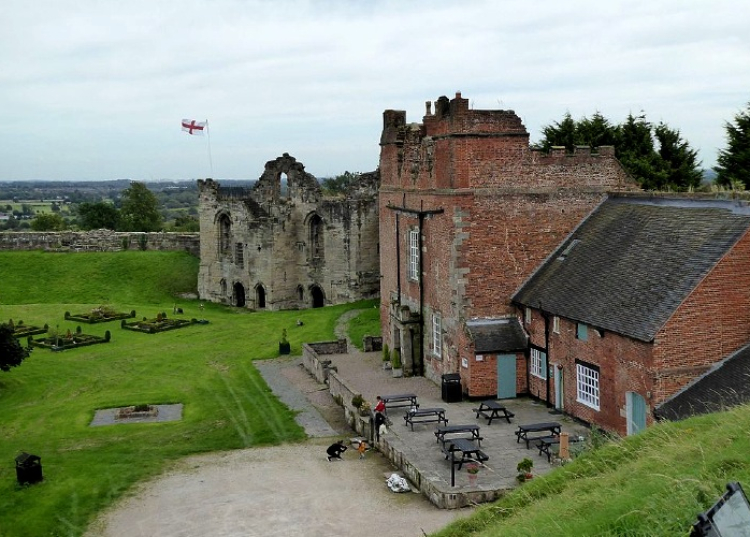
11. Tutbury Castle
Tutbury Castle is an imposing medieval site in Staffordshire which had one very famous prisoner, Mary Queen of Scots. Whilst its history is said to date back to the 11th century, most of the ruins of Tutbury Castle seen today originate from the 14th and 15th centuries, under the remit of the Lancastrian kings such as Henry IV and Henry VI.
Yet, the historic heyday of Tutbury was soon to come, not as a prized royal residence but rather as a majestic prison where Elizabeth I kept Mary Queen of Scots captive. First arriving at Tutbury Castle on 4 February 1569, Mary would spend much time in her regal jail, a place she disliked both because of its function and due to its rundown state. Mary would be moved several times over the coming years, with her final sojourn there being for almost a year in 1585.
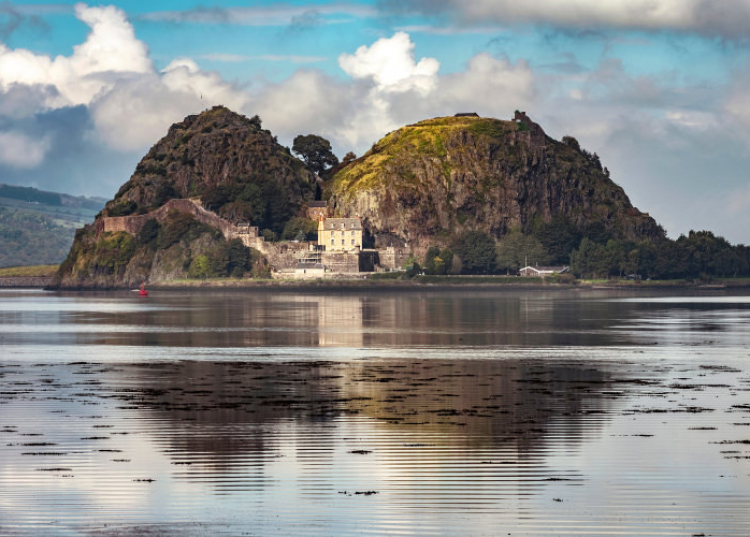
12. Dumbarton Castle
Dumbarton Castle was a medieval stronghold which served as a wartime prison, a royal shelter and a defence against both foreign and national threats.
The building of the medieval Dumbarton Castle began in the 1220, amidst the danger of attacks from Norway. It was constructed under Alexander II of Scotland and was intended to protect the border. With its slightly more remote location, one other important function of Dumbarton Castle was as a royal escape route. In the fourteenth century, David II sailed from Dumbarton and, in 1548, this was where a young Mary Queen of Scots sought refuge before travelling to France.
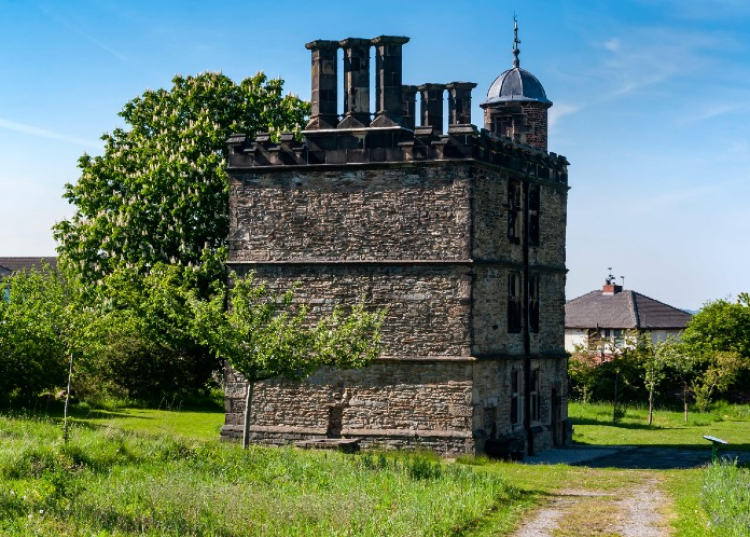
13. Sheffield Manor Lodge
Originally a fine Tudor country estate, the remains of Sheffield Manor Lodge are now an important visitor attraction and give a glimpse into medieval history. In the early 16th century the Earl of Shrewsbury considerably updated this medieval structure and it became more manor house than hunting lodge. Further renovations were carried out in the 1570s, completing the transformation of the site into an impressive Tudor estate.
Notable figures to have spent time at the Lodge include the infamous Cardinal Wolsey, who resided here for a few days after falling from favour with Henry VIII, and Mary Queen of Scots, who spent 14 of her 19 years of captivity in Sheffield and was brought to the Manor Lodge on several occasions.

Fotheringhay Castle and the execution of Mary, Queen of Scots

Some stone with a fence around it is now all that remains of Fotheringhay Castle. Three signs tell part of its story; one states the name of the former castle, a second that King Richard III was born there in 1452 and the third reminds the visitor that Mary, Queen of Scots was executed there on 8 February 1587.
Mary had fled to England in hopes of receiving England’s help with regaining her crown. However, Queen Elizabeth perceived her as a threat as Mary had once claimed England’s throne as her own (through her descent from Margaret Tudor, the sister of King Henry VIII). She became Elizabeth’s prisoner for many years, and she was kept in many different castles and manors over the years.
On 5 September 1586, a special tribunal was set up to hear the evidence against Mary, in yet another plot against Elizabeth. Mary herself was not informed of where she was going, and she arrived at Fotheringhay Castle on 25 September. She was accompanied by five or six servants. Mary refused to confess her guilt, and on 12 October a letter arrived from Elizabeth.
“You have in various ways, and manners attempted to take my life and to bring my kingdom to destruction by bloodshed. I have never proceeded so harshly against you but have, on the contrary, protected and maintained you like myself. These treasons will be proved to you, and all made manifest. Yet it is my will, that you answer the nobles and peers of the kingdom as if I were myself present. I therefore require, charge, and command that you make answer for I have been well informed of your arrogance. Act plainly and without reserve, and you will sooner be able to obtain favour of me. Elizabeth R.”
The following trial took place in a room above the Great Hall but her statement was not of her guilt. She said, “I am an absolute Queen, and will do nothing which will prejudice either mine own royal majesty, or other princes of my place and rank or my son. My mind is not yet dejected nor will I sink under my calamity… The laws and statutes of England are to me most unknown; I am destitute of counsellors, and who shall be my peers, I am utterly ignored. My papers and notes are taken from me, and no man dareth step forth as my advocate. I am clear of all crimes against the Queen. I have excited no man against her, and I am not to be charged but by mine own word or writing, which cannot be produced against me. Yet can I not deny but I have commended myself and my cause to foreign princes.”
On 19 November, the news arrived that parliament had passed the sentence of death on her. Mary was stripped of her honours and cloth of state. She was now “but a dead woman, without the honours and dignity of a Queen.” Mary replaced her cloth of state with pictures of the Passion of the Christ, and the building of a scaffold was begun in the Great Hall. Mary wrote to Elizabeth asking to be buried with the “other Queens of France” or near her mother. Yet Elizabeth waited to confirm the order of execution. She finally signed the order in early February.
Mary was told on 7 February that she was to die the following morning. She began to settle her affairs and wrote to her brother-in-law, King Henry III of France. At six in the morning, Mary dressed for her final performance. She wore a skirt and bodice of black satin over a russet brown petticoat and an overmantle of black satin embroidered with gold and trimmed with fur. She wore a white crepe headdress and a long lace veil. A gold rosary hung from her waist. She spent some time at prayer.
She walked down to the Great Hall, where the scaffold was now complete. Over 300 people had come to watch her die. She climbed the scaffold and took the pins out of her hair herself. Her outer clothes were removed, and she received fresh sleeves in russet, and so she was now dressed in red – signifying a Catholic martyr. She bade farewell to her weeping servants and forgave the executioner. A silk handkerchief was then tied over her eyes, and she laid her head down on the block. She spoke the words, “In manus tuas, domine, commendo spiritum meum” (Into your hands I commend my spirit) several times before the axe fell. It took two strikes to decapitate her except for a small part of sinew, which the executioner sawed through. He then lifted her head and declared, “God save the Queen.” Her head then fell from his grasp, leaving him holding her auburn wig.
Mary’s body was removed to another room while the scaffold, block and her clothes were burned. Her head was put on a velvet cushion and put on display in one of the windows so that the crowds outside could see it. Her body was hastily embalmed the following morning before being placed in a double coffin of oak and lead.
This slideshow requires JavaScript.
It wasn’t until 30 July 1587 that Mary’s body was moved to Peterborough. She was buried in a grave opposite of that of Catherine of Aragon. She was moved to Westminster Abbey on 28 October 1612. Fotheringhay Castle was abandoned after Mary’s execution, and it was mostly gone by the end of the 18th century.
The site is open for visitors. 1
Share this:
- Click to share on Twitter (Opens in new window)
- Click to share on Facebook (Opens in new window)
- Click to share on WhatsApp (Opens in new window)
- Click to share on LinkedIn (Opens in new window)
- Click to share on Reddit (Opens in new window)
- Click to share on Tumblr (Opens in new window)
- Click to share on Pinterest (Opens in new window)
- Click to share on Pocket (Opens in new window)
- Click to email a link to a friend (Opens in new window)
- Click to print (Opens in new window)
- Read more: The life of Mary, Queen of Scots: an accidental tragedy by Roderick Graham
- fotheringhay castle
- mary queen of scots
- peterborough
- peterborough cathedral
- places to visit
- Queen Elizabeth I
Be the first to comment
Leave a reply cancel reply.
Your email address will not be published.
Yes, add me to your mailing list
Notify me of follow-up comments by email.
This site uses Akismet to reduce spam. Learn how your comment data is processed .
Copyright © 2024 | MH Magazine WordPress Theme by MH Themes
To provide the best experiences, we and our partners use technologies like cookies to store and/or access device information. Consenting to these technologies will allow us and our partners to process personal data such as browsing behavior or unique IDs on this site and show (non-) personalized ads. Not consenting or withdrawing consent, may adversely affect certain features and functions.
Click below to consent to the above or make granular choices. Your choices will be applied to this site only. You can change your settings at any time, including withdrawing your consent, by using the toggles on the Cookie Policy, or by clicking on the manage consent button at the bottom of the screen.
Subscribe to our free weekly newsletter and stay up to date on History of Royal Women's articles!
Not interested? Simply click 'close' in the top right corner to continue reading!
Check your inbox or spam folder to confirm your subscription.

- Squires & Spires
- Northamptonshire’s heroes
- Summary of walks by distance & time
- Walk 1: Castle Ashby Circular (6.5 miles, 2hrs): A fantastic walk including a stately home, great tea rooms, rivers, wildlife, spooky graveyards & a secret place…shhh!
- Walk 2: Collingtree Circular: A golf course, open fields, villages, a canal, pocket parks
- Walk 3: Braunston Circular: An ancient footpath, a gunpowder plot, a tale of woes, fab jams & marmalades & a canal finish
- Walk 4: Delapre Abbey Circular: A 10 mile walk from an ancient Abbey, along the Nene way, through the washlands & beyond!
- Walk 6: Great & Little Brington Circular: A wave to Diana..
- Walk 7: Yardley Gobian Circular: Stepping back in time across the fields to ‘The Deserted Village’
- Walk 8: Old Village Circular: 8 miles across the fields with great views & big trees on a boiling hot day. Mind the sheep poo though!!
- Walk 9: Oundle Water Meadows Circular: Wonderful water, wildlife & willows
- Walk 10: Stoke Bruerne Circular: A lovely walk for all the family around Northamptonshire’s jewel in the canal network
- Walk 11: Salcey Forest Circular: We followed an Elephant looking for an Owl but saw neither today…
- Walk 12: Abthorpe Circular: Picturesque South Northamptonshire villages (1) in the Tove valley
- Walk 13: Weston Circular: Picturesque South Northamptonshire villages (2) in the Tove valley
- Walk 14: Bugbrooke Circular: Back to the flats of the canals, but with fantastic views over our beautiful county
- Walk 15: Northampton: A brief walk around the historic town centre
- Walk 16: Wellingborough town centre heritage trail
- Walk 17: Thrapston & Titchmarsh Nature Reserves Circular: A ‘twitchers’ paradise
- Walk 18: Stony Stratford Circular: Crossing the border twice….a walk in the Great Ouse valley
- Walk 19: Sywell Country Park Circular
- Walk 20: The Bramptons & the Brampton Valley Way Circular
- Walk 21: Harringworth Circular: Wonderful structures & wildlife in the Welland Valley
- Walk 22: Summer Leys Circular: What a beautiful little nature reserve
- Walk 23: Towcester Town & Watermeadows Walk
- Walk 24: Rothwell town centre…”the place of the red well”
- Walk 25: Abington Park, Northampton: Ever walked in one of the UK’s top 5 parks?
- Walk 26: Sulgrave Village Circular Walk…full of Stars & Stripes
- Walk 27: King’s Sutton village walk…a must see southern Northants village
- Walk 28: Higham Ferrers town centre
- Walk 29: Raunds town centre…memories of times gone by
- Walk 30: Harlestone Firs Circular
- Walk 31: Wadenhoe Circular: Kingfishers & just a stunning walk
- Walk 32: Litchborough & Farthingstone Circular – a little cardio exercise!
- Walk 33: Eastcote Circular
- Walk 34: Flore Circular: This one’s flawless
- Walk 35: Grendon & Easton Maudit Circular: ‘Larking around’
- Walk 36: Badby Circular: Strolling amongst the bluebells
- Walk 37: Ravensthorpe Circular: Water, wildlife & waiting for a bite
- Walk 38: Twywell Circular: ‘Up Hill & down Dale’
- Walk 39: Aynho Circular: ‘I know, I know…(apricot anyone?)
- Walk 40: Cransley Reservoir Circular…who knew about that?
- Walk 41: Welford Circular…views across 3 counties, & also known as the “Happy Whale Walk”!…
- Walk 42: Cosgrove Circular: watch out for a ‘stampede’
- Walk 43: Great Addington Circular: The 3 ‘Ws’ – Water, Wildlife & Walking
- Walk 44: Fermyn Woods Circular: Flip-Flop Frenzy
- Walk 45: Kings Cliffe Circular: Bouncing dogs & unusual libraries…
- Walk 46: Whilton Circular: more stampeding
- Walk 47: Irchester & Chester House Circular
- Walk 48: Canons Ashby Circular: Round & round the Mulberry Bush…
- Walk 49: Kingsthorpe Circular: Kings, Dallies, Firs & a couple of Chapels…
- Walk 50: The Northampton Round Long Distance Footpath
- Walk 51: Whittlebury Circular: Golf balls & fast cars…
- Walk 52: Marston Trussell Circular: Historical Battlefields & a Big Rock
- Walk 53: Arthingworth Circular: A walk through a railway tunnel? No ‘Bull’
- Walk 54: Oundle Heritage Trail…Back to School
- Walk 55: Titchmarsh Village Heritage Trail: Do you dig it Alan?…
- Walk 56: Thrapston Town Centre: The Star Spangled Banner
- Walk 57: Boddington Reservoir Circular: You wanna a flake with that luv?
Walk 58: Fotheringhay Circular: Off with her head!!
- Walk 59: Kislingbury Circular: Why not combine it with Sunday Lunch…
- Walk 60: Sudborough Circular: Living it up around Lyvedon New Bield
- Walk 61: Bugbrooke & Nether Heyford Circular: No need to ‘flour’ this one up…
- Walk 62: Middleton & East Carlton Circular: ‘Steel yourself’…
- Walk 63: Warkton & Weekley Circular: Ise spies a tea shop…
- Walk 64: Winwick Circular: Views to die for from Honey Hill
- Walk 65: Wansford Circular: Watermeadows & Dick Whittington
- Walk 66: Polebrook Circular: “Frankly my dear…I don’t give a damn”
- Walk 67: Brackley Town Centre: Elvis is alive & well…
- Walk 68: Greens Norton Circular: Catherine Parr lived here? Maybe not…
- Walk 69: Hellidon Circular: The ‘Peaks’ of our stunning County…
- Walk 71: Great Doddington Circular: Pubs & birds
- Walk 72: Earls Barton Circular: Tea & Kinky Boots Vicar?
- Walk 73: Wicken Circular: Solitude & a rather damp climate
- Walk 74: Easton on the Hill Circular: Got your passport ready?
- Walk 75: Kettering’s Industrial Trail..plus a couple of other bits!
- Walk 76: Daventry Town Centre: “Daventry calling…Daventry calling”
- Walk 77: Middleton Cheney Circular: No Bull
- Walk 78: Crick Village Walk: Everybody knew everybody…
- Walk 79: Rushden Town Centre: Not feeling ‘blue’…a look at Rushden’s notoriety
- Walk 80: Wollaston Village Walk: “Who are you…”
- Walk 81: Northampton’s Shoe Quarter
- Walk 82: Rothersthorpe Circular: Bull or No Bull
- Walk 83: Braunston Circular: Canals & Floating breakfasts
- Walk 84: Geddington Circular: In the Willows…
- Walk 85: Rockingham Village: Up the hill & back down again…
- Walk 86: East Haddon Circular: Get away from it all…
- Walk 87: The Harlestones Circular: Inspiring Jane Austen
- Walk 88: Syresham Village Walk: Know your heritage…
- Walk 89: Burton Latimer Circular: Have you had your daily wheat? “Ise” hope so!
- Walk 90: Weedon Bec Village Walk: Did Napoleon leave a bomb?
- Walk 91: Helmdon Village Walk: Lovely village, lovely people
- Walk 92: Middleton Village Walk: On yer bike!
- Walk 93: Cottingham Village Walk: Possibly the oldest inn in England…
- Walk 94: Kinewell Lake Circular Walk: Kinda a kindly stroll
- Walk 95: Upton Circular: Guided by the ‘Light’
- Walk 96: Brockhall Circular: The CIA are watching you!…
- Walk 97: Northampton Washlands Circular
- Walk 98: Kings Cliffe & Blatherwyke Circular: Red Kites & bizarre statues…
- Walk 99: Collingtree & Milton Malser Circular: Max’s Morning Walk
- Walk 100: The Nene Way Long Distance Footpath
- Walk 101: Brigstock & Fermyn Woods Circular: Wear your green tights for this one…
- Walk 102: Yelvertoft & Crick Circular: Well…more a figure of 8
- Walk 103: Harrington Circular: Time for a Gin anyone?
- Walk 104: Maidwell Circular: A short afternoon stroll
- Walk 105: Greatworth Circular: A great little stroll
- Walk 106: Welton Circular: Up the Junction
- Walk 107 – Delapre Abbey Inner Grounds
- Walk 108: Naseby Village & Battlefield Walk: The most important Battle in the English Civil War
- Walk 109: Hollowell Circular: Our most beautiful reservoir – Permit required
- Walk 110: Gayton Circular: A classic Shire stroll around Four Churches
- Walk 111: Bugbrooke & Stowe Circular: “Nine Churches”, Catherine Parr & a Tea Room
- Walk 112: Silverstone Circular: A great ‘Formula’ & an Ancient Wood
- Walk 113: Rushden Lakes Circular (1)…strolls, ski jumps & sculptures
- Walk 114: Rushden Lakes Circular (2): Beautiful frosty mornings…
- Walk 115: Whitfield Circular…”Mind that Stile!!”
- Walk 116: Welford Reservoir Circular – two hidden gems
- Walk 117: Chipping Warden & Edgcote Circular. Northamptonshire at its best!
- Walk 118: Lamport Circular Walk: Spot the mushroom!
- Walk 119: The Lyveden Way…stepping back in history
- Walk 120: Collyweston Circular…searching for the lost palace
- Walk 121: Blisworth Circular
- Walk 122: Nassington Circular… this one will get you “In the Mood!”
- Walk 123: Charlton Circular Walk: A stunning short stroll
- Walk 124: Gretton & Kirby Hall circular walk
- Walk 125: Roade & Stoke Bruerne Circular
- Walk 126: Grafton Underwood & Warkton Circular
- Walk 127: Piddington Circular Walk
- Walk 128: The Ecton Circular
- Walk 129: Pitsford Reservoir Circular Walk
- Walk 130: Yardley Hastings & Castle Ashby Circular
- Walk 131: Everdon – Fawsley – Preston Capes Circular (Get ready to roll!)
- Walk 132: Cottesbrooke to Haselbech Hill Circular Walk
- Walk 133: Rushton & Pipewell Circular
- Walk 134: Little Harrowden, Orlingbury, Pytchley & Isham…an inter-village circular & a boot scraper in a field
- Walk 135: Boughton Circular: Obelisks, Follies, Grottos & Northamptonshire’s most haunted place!! Beware…
- Walk 136: A short stroll around Spratton
- Walk 137: Moulton Village Walk – how beautiful!
- Walk 138: Overstone Circular
- Walk 139: Moulton Circular
- Walk 140: Barton Seagrave & Wicksteed Park
- Walk 141: Little Harrowden & Hardwick Circular Walk
- Walk 142: Ringstead & Denford Circular Walk
- Walk 143: Bulwick Circular Walk: A ‘pickled’ village & a ‘Tea Pot’ Monument in Red Kite Country
- Walk 144: Annie & Nina’s Cotton End, Northampton Circular Walk
- Walk 145: Grafton Regis Circular Walk
- Walk 146: Walgrave Circular
- Walk 147: Little Irchester & Wellingborough Circular
- Walk 148: Brackmills Country Park (1) The Hard Path Short Circuit
- Walk 149: Brackmills Woods Country Park (2): The ‘Alpine’ Perimeter Circular Walk
- Walk 150: St Crispins, Marina Park & Old Duston Circular Walk
- Walk 151: Clipston Circular Walk
- Walk 152: Quinton, Preston Deanery, Wootton, & Grange Park Circular
- Walk 153: Northampton’s Riverside Meadows Circular Walk
- Walk 154: Holcot Circular Walk
- Walk 155: Collingtree, Milton Malser, Blisworth & Courteenhall Circular
- Walk 156: Chelveston Circular…a short walk around an old airfield with big sky views
- Walk 157: Hulcote Circular
- Walk 158: Stanwick Circular Walk
- Walk 159: Deanshanger, Wicken & ‘Farm of the Goblin’ Circular
- Walk 160: Quinton, Piddington, Horton & Hackleton Circular
- Walk 161: Roade – Cosgrove Circular: canals, fields & a ford
- Walk 162: Lowick Circular including the Drayton Estate (Saltburn)
- Walk 163: Adstone & Woodend Circular
- Walk 164: Brixworth & Pitsford Circular
- Walk 165: Harpole, Harlestone & Nobottle Circular
- Walk 166: Eydon Circular…stunning scenery & just the sound of the birds
- Walk 167: Brixworth Village Walk
- Walk 168: Bozeat & Strixton Circular
- Walk 169: Brixworth & Holcot Circular
- Walk 170: Tiffield, Shutlanger, Alderton, Heathencote, Towcester & Caldecote Circular
- Walk 171: Alderton, Grafton Regis, Pury End & Paulerspury Circular
- Walk 172: Wollaston Saxby’s Cider Circular
- Walk 173: Delapre Abbey Signposted Walk
- Walk 174: Sulgrave & Culworth Circular
- Walk 175: Thorpe Mandeville & Thenford Circular
- Walk 176: Middleton Cheney, Chacombe, Overthorpe & Warkworth Circular
- Walk 177: Cottingham, East Carlton, Wilbarston & Stoke Albany Circular
- Walk 178: The Parks & Woodlands of Corby
- Walk 179: Great Oakley, Newton, Geddington Circular
- Walk 180: Stanion, Geddington Chase & Brigstock Circular
- Walk 181: Daventry Country Park
- Walk 182: Barnwell…a short, yet beautiful stroll
- Walk 183: Hinton in the Hedges circular walk
- Walk 184: Croughton Circular
- Walk 185: Stanwick Lakes: Hidden Gems Sculpture Trail
- Walk 186: Stanwick Lakes: Nature Ramble Trail
- Walk 187: Helmdon & Astwell Circular
- Walk 188: Hunsbury Pocket Parks & Bluebell Walk
- Walk 189: Everdon Stubbs
- Walk 190: West Haddon Circular
- Walk 191: Lutton & Folksworth Circular
- Walk 192: Long Buckby Duck Pond Walk
- Walk 193: The ‘Binty Bint’ Graffiti Walk
- Walk 194: Creaton: “The one with the Wild Flower Field” Circular
- Walk 195: Cransley & Loddington Circular
- Walk 196: Greens Norton, Bradden & Blakesley Circular
- Walk 197: Barby Circular
- Walk 198: Brafield on the Green Circular…the Best Duck Pond in Northamptonshire!
- Walk 199: Foxfield Country Park: Accessible for All & in All weathers
- Walk 201: Hardingstone Pocket Park…a short, accessible for all, stroll in ‘Narnia’
- Walk 202: Paulerspury & Pury End Circular
- Walk 203: Sutton Bassett & Ashley Circular
- Walk 204: Draughton Circular
- Walk 205: Crick Deer Park Circular
- Walk 206: Blisworth & Stoke Bruerne Circular – Missing out that awful road!
- Walk 207: Dodford & Borough Hill (our 2nd highest)…plus a Hobbit(ty) House!
- Walk 208: Watford Village & ‘Pulpit Bridge’
- Walk 209: Glapthorn & the Cow Pastures
- Walk 210: Stanford on Avon & the Hemplow Hills
- Walk 211: Newnham & ‘The Nuttery’
- Walk 212: Maidford & Canons Ashby Circular
- Walk 213: Glendon: Prologis Park Walk
- Walk 214: Syresham Circular Walk
- Walk 215: Norton Circular…the best Fish ‘n’ Chips in Northamptonshire?
- Walk 216: A stroll around Burton Latimer
- Walk 217: Litchborough Circular Walk: The birthplace of Radar (who knew!). And…a Tea Room
- Walk 218: The Ancient Oaks of Salcey Forest
- Walk 219: A Knight’s Tale…a Circular Stroll from Delapre Abbey
- Walk 67: Brackley Town Centre: Elvis is alive & well…
- Walk 1: London’s East End Circular: In search of Jack the Ripper & the Twins!!
- Walk 2: Dorchester Circular Walk: Far from the Maddening Crowd
- Walk 3: Lincoln City Circular Walk: Back to our birthplace
- Walk 4: Bedford Circular Walk: Tales from the riverbank
- Walk 5: Dublin City Centre Walk
- Walk 6: Stowe Gardens, Buckinghamshire
- Walk 7: Cambridge City Centre Circular Walk: Colleges & Culture
- Walk 8: Blickling Estate, Norfolk Circular Walk: ‘It’s bootiful’
- Walk 9: Newmarket Town Circular Walk: An early morning ‘Gallop’
- Walk 10: Flatford Mill: It’s a picture (you’ve seen before)…
- Walk 11: Colchester Town Circular Walk: ‘Roman’ing’ around
- Walk 12: Lavenham Town Walk: It’s all a bit ‘Wonky’
- Walk 13: Odell Circular: Take it on….The 7 Churches Challenge
- Walk 14: Poole Town Centre: Cockles & Mussels alive a live oh!
- Walk 15: Hengistbury Head Circular Walk: Life’s a beach!
- Walk 16: Three Cliffs Bay, The Gower Circular: Cerdded o gwmpas Y Gŵyr
- Walk 17: St Davids Circular: A Pembrokeshire Pilgrimage from the UK’s smallest city
- Walk 18: Greenwich: From the London Eye on a Fast Boat
- Walk 19: Aberdeen City Circular Walk: “Any port in a storm”
- Walk 20: Cardiff City Circular Walk: “Sittin’ on the Dock of the Bay”
- Walk 21: Penarth to Lavernock Point Linear Walk: “Can You Hear Me”…”Yes Loud & Clear”
- Walk 22: Bath City Walk: Bathing with your Beau
- Walk 23: Pisa City Walk: A ‘leaning’ towards piazzas & pizzas
- Walk 24: Antrim Town Walk: Irish eyes are smiling
- Walk 25: Florence City Walk: Does it live up to the hype?
- Walk 26: Prague City Walk: Good King Wenceslas last looked out in
- Walk 27: Milton Keynes, Willen Lakes Circular: So much more than just water
- Walk 28: Paris, Montmartre Area: A quick ‘Can-Can’ around the streets
- Walk 29: Foxton Locks: Slowly up or down…
- Walk 30: Buckingham Town Walk: Get out of Gaol free
- Walk 31: Llantrisant Town Walk: It’s a real ‘Mint’
- Walk 32: Pontypridd Town Walk: In the “Land of My Fathers”
- Walk 33: Rhondda Heritage Park Circular: In the valley of black gold…Cwm Hafod
- Walk 34: Aberdare Town Walk: Memories of days gone by…
- Walk 35: Woburn Circular: Getting ‘wild’ with the locals
- Walk 36: Leicester City Centre: King Richard III Walking Trail
- Walk 37: Leicester City Centre: A multi-cultural stroll
- Walk 38: Edinburgh City Centre: This one’s not around the ‘Fringe’
- Walk 39: Leith: Plenty of sunshine on it (plus good food)
- Walk 40: Warwick Town Circular: A Town & Country stroll
- Walk 41: Westport Town Centre: Never expected to see an Elephant in Ireland
- Walk 42: Galway City Centre: What a city!
- Walk 43: Dingle Town Centre: Where’s Dick Mack’s?
- Walk 44: Oxford Circular: A Perch & The Trout – sounds like a case for Inspector Morse…
- Walk 45: Killarney Town Centre: The Key to the Kingdom
- Walk 46: Fenny Stratford Circular: Parks, canals & lakes – a bit of everything
- Walk 47: City of London: Apples ‘n Pears
- Walk 48: Chepstow Town Walk: A Christmas stroll
- Walk 49: Weymouth Town Walk: Beware the Black Death
- Walk 50: Oakham Town Walk: The traditional English town is still alive
- Walk 51: Uppingham Town Walk: Back to school
- Walk 52: Olney Town Walk: Keep running & tossing as fast as you can
- Walk 52: Pontefract Town Walk: The ‘sweet’ smell of sugar
- Walk 53: Newport Pagnell Town Walk: It’s as keen as mustard
- Walk 54: Seven Sisters & Beachy Head Circular: Watch your step…
- Walk 55: Hastings Old Town Walk: Hang onto your Winkle!
- Walk 56: Melton Mowbray Town Walk: Everyone loves a Pork Pie
- Walk 57: St Andrews Linear Walk: The ‘Home of Golf’
- Walk 58: Dundee City Walk: One City, Many Discoveries…
- Walk 59: Rhossili Circular: ‘The supermodel of British beaches’
- Walk 60: Grantham Town Walk: This walk’s not for turning
- Walk 61: Beverley Town Walk: Down the rabbit hole
- Walk 62: Worcester City Walk: Full of Pomp & Ceremony
- Walk 63: Newcastle City Walk: Wae’aye man!
- Walk 64: Stirling City Walk: Gateway to the Highlands
- Walk 65: Falkirk Town Walk: A really, wheelie great walk
- Walk 66: Troon Circular: The home of the 2016 Open
- Walk 67: Dean Village, Edinburgh, Town Walk: An Oasis in the middle of a bustling city
- Walk 68: Holme Pierrepoint Circular: Wet ‘n’ Wild near Nottingham
- Walk 69: Thaxted Village Walk: Morris Men & Highway Men
- Walk 70: Braintree Town Walk: Shaaaattttaaaapppp…a quick walk round the centre of Essex
- Walk 71: Little Dunmow Circular: Bringing home the bacon & an otter surprise too
- Walk 72: York City Walk: The Bars & Walls
- Walk 73: Horncastle Town Walk: Present & the Past in our home town
- Walk 74: Canterbury City Walk: Watch your backs!
- Walk 75: Herne Bay Town Walk: Bouncing Bombs & Records
- Walk 76: Bushy Park Circular: A right royal stroll…
- Walk 77: Castleton Circular: To ‘the Edge’ & back…the Great Ridge
- Walk 78: Rochdale Heritage Trail: Wot you skennin’ at & stop mithering’…
- Walk 79: Chelmsford City Walk: Judas, a thermos flask & sandwiches
- Walk 80: Soho to Westminster Linear Walk: Sex, noodles, drama & politics
- Walk 81: Broadstairs Town Walk: A Dickens of a lovely place
- Walk 82. Hambleton Peninsula Circular: ‘Ambling on’ the shores of Rutland Water
- Walk 83: Mayfair: Get me to the church on time
- Walk 84: Stratford upon Avon Town Walk: To walk or not to walk…that is the question…
- Walk 85: Kings Cross & Camden Circular: Harry meets Amy & back (to black)
- Walk 86: Bradford City Walk: Tikka moment to (Aloo) Go(bi) & have a look Bradford
- Walk 87: Covent Garden Circular: Any ‘Venezuelan Beaver Cheese’ my good man?
- Walk 88: The Mumbles Circular: Surf’s Up!
- Walk 89: Swansea City Walk: Does it deliver a knockout punch?
- Walk 90: Paddington & Marylebone Linear: Following in the steps of a Virgin
- Walk 91: La Roche-Canillac Circular: A French beauty
- Walk 92: Belgravia Linear: “Lucky or not…”
- Walk 93: London Southwark & Bankside Linear
- Walk 94: St James Linear: Fancy going ‘clubbing’ gentlemen (& occasionally ladies)?
- Walk 95: Highgate Linear: Hitler, George Michael & “a very naughty boy”
- Walk 96: Haworth Circular: The Railway Children Walk – Don’t upset the “bloomin’ missus!”
- Walk 97: Southwold Circular: “We’re Ladies you know!”
- Walk 98: Thorpeness Circular: Walking with our heads (house) in the clouds
- Walk 99: Storms River Mouth Circular: A South African ‘wobble’
- Walk 100: The London Circle Line: 21 miles around the stations
- Walk 101: Knysna, South Africa Town Walk: A place of contrast
- Walk 102: Cambridge City Walk: The Art Trail
- Walk 103: Historic Cape Town & Bo Kaap
- Walk 104: Wigan City Walk: The Road to Wigan Pie(r)
- Walk 105: Burnley Town Walk: Memories of a time gone by…
- Walk 106: Abergavenny Town Walk: Gateway to the Brecons
- Walk 107: St Ives Town Walk: Worth ‘The Wait’
- Walk 108: Palermo City Walk: A foodie & cultural stroll
- Walk 109: Birmingham Centre Walk: Traditional Markets & Canals
- Walk 110: Creswell Crags Circular: Home of the Ice Age Hunter
- Walk 111: Clondalkin Town Walk: An amazing tower but no Rumpelstiltskin!
- Walk 112: Hull City Centre Circular: Exploring the Land of Green Ginger…a city of culture
- Walk 113: Tenbury Wells: A beautiful town
- Walk 114: Sherwood Forest Circular: “Robin Hood, Robin Hood”
- Walk 115: Lambeth Linear: Did James Bond do the ‘Lambeth Walk’..Oii!!??
- Walk 116: Trafalgar Square to St Paul’s Cathedral Linear
- Walk 117: Shrewsbury Town Centre: 660+ listed buildings to discover
- Walk 118 / 118: The City of London (1): The Eastern part
- Walk 119: The City of London (2): The fascinating Western part
- Walk 120: Eton Town Centre: Up against the ‘Wall’…Eton & its college
- Walk 121: Spitalfields Circular: A melting pot of history
- Walk 122: Ludlow Town Centre: ” The loveliest town in England”?
- Walk 123: Market Harborough Town Walk: A wander around a lovely little gem
- Walk 124: Sydney city centre – G’Day!
- Walk 125: Epping Forest circular…Did we find the body?
- Walk 126: Melbourne City Centre linear walk – we loved you!
- Walk 127: Brisbane, Australia, Circular Walk
- Walk 128: Cairns, Australia Circular Walk
- Walk 129: Chester City Circular: “What have the Romans done for us?”
- Walk 130: Rotorua New Zealand. It’s smelly but you’ll get a great welcome
- Walk 131: Ravenna…Just incredible mosaics
- Walk 132: Bologna…food, history & fab!
- Walk 133: Turville circular…”Come in if you’re sexy & love Jesus”
- Walk 134: Henley on Thames Circular…Beatles, Pudding Stones & Princess Anne
- Walk 135: Tarr Steps, Exmoor, Circular Walk…give it a ‘Clap(per)’
- Walk 136: Curry Rivel Circular…a monument to Cider
- Walk 137: ‘The Broomway’ Linear Walk…”One of the most dangerous paths in the UK”
- Walk 138: Polperro Village & Headlands…Pasty or Clotted Cream Fudge anyone?
- Walk 139: Tintagel Circular: It’s a legend
- Walk 140: London, Tower Hill to Canary Wharf
- Walk 141: Digbeth (Birmingham) Art Trail: It’s a (Peaky) Blinder!
- Walk 142: Boscastle & the Valency Valley
- Walk 143: Padstow Town Trail
- Walk 144: Grasmere & Rydal Waters & the ‘Coffin Route’ Circular walk
- Walk 145: Stamford Town Trail Circular Walk…Worth a weekend away!
- Walk 146: Silverdale Circular Walk (1)…a beautiful unknown corner of Britain
- Walk 147: St Neots town circular walk
- Walk 148: The Isle of Wight…A stroll around the Yarmouth estuary
- Walk 149: Painshill Park circular walk
- Walk 150: Bembridge, Isle of Wight Circular Walk
- Walk 151: Burford Town Walk
- Walk 152: Bradgate Park & Swithland Wood Circular
- Walk 153: Barnack & Ufford Circular (Rowdy Rectors & Sequoia Safari)
- Walk 154: Baildon – Escholt Circular (Emmerdale Walk)
- Walk 155: Saltaire & Salts Mill
- Walk 156: Marlow & Hurley Lock Circular Walk
- Walk 157: Marlow Town Walk
- Walk 158: St Albans City Walk
- Walk 159: Sudbury Town Walk…in the footsteps of Thomas Gainsborough
- Walk 160: The Ashridge Estate….an avoid the usual crowds walk
- Walk 161: The Huntingdon Town Trail
- Walk 162: Milton Keynes Lake to Lake Circular
- Walk 163: Pickering Town Walk
- Walk 164: Levisham…a hamlet in the North Yorkshire Moors
- Walk 165: Malham Cove, Gordale Scar & Janet’s Foss Circular Walk (Voted No.3 in ‘Britain’s Best 100 Walks)
- Walk 166: Aysgarth Falls & Woods…just a stunning walk
- Walk 167: West Burton in the Yorkshire Dales. Wow…what a short walk!
- Walk 168: A Circular Walk from ‘The Bear’ in Long Lawford
- Walk 169: Monaco: A lap of the Grand Prix circuit
- Walk 170: Cromer & Overstrand Circular
- Walk 171: Lynton…The Valley of the Rocks
- Walk 172: Heddon’s Mouth (North Devon)
- Walk 173: Robin Hood’s Bay Circular
- Walk 174: Watersmeet Trail (North Devon)
- Walk 175: Ilfracombe ‘Madonna’s Bra’ Town Trail
- Walk 176: Gloucester City Centre Walk
- Walk 177: Wittering & Thornhaugh Circular…Cecils & Russells, Harriers & Saxons
- 178: Harcourt Arboretum…beautiful autumn colours
- Walk 179: Milton Keynes Ancient & Modern Cultural Walk
- Walk 180: Turvey Circular…only just over the border
- Walk 181: Napton on the Hill
- Walk 182: Lockton (Yorkshire Moors) Circular
- Walk 183: Nunnington (Yorkshire Moors) Circular
- Walk 184: Silverdale Walk 2: Arnside Knott Circular aka ‘Marilyn’
- Walk 185: Silverdale Walk 3: Jack Scout & Jenny Brown’s Point Circular Walk
- Walk 186: Newport Pagnell & Bury Field
- Walk 187: Goathland aka ‘Heartbeat’
- Interactive Maps
- Group Walks
- The route & history…
- Stage 1: Brixworth to Holcot
- Stage 2: Holcot to Sywell
- Stage 3: Sywell to Cogenhoe
- Stage 4: Cogenhoe to Yardley Hastings
- Stage 5: Yardley Hastings to Piddington
- Stage 6: Piddington – Stoke Bruerne
- Stage 7: Stoke Bruerne to Blisworth
- Stage 8: Blisworth – Bugbrooke
- Stage 9: Bugbrooke to Nobottle
- Stage 10: Nobottle to Church Brampton
- Stage 11: Church Brampton to Brixworth
- Background & route
- Stage 1: Badby to Kislingbury
- Stage 2: Kislingbury to Cogenhoe
- Stage 3: Cogenhoe to Irthlingborough
- Stage 4: Irthlingborough to Thrapston
- Section 1: Banbury to Chipping Warden
- Section 2: Chipping Warden to Charwelton
- Section 3: Charwelton to Braunston
- Section 4: Braunston to Winwick
- Section 5: Winwick to Sibbertoft
- Section 6: Sibbertoft to Braybrooke
- Section 7: Braybrooke to Cottingham
- Walk 21: St Crispins, Marina Park & Old Duston Circular Walk
- Merchandise
- Local Radio Recordings…Click on the links below
- News Articles – Click on each to read
- Walk 1: Obelisk & Boughton Fields, Northampton
- Walk 2: Duston, Northampton
- Walk 3: Lossiemouth…Beaches & Typhoons
- Walk 4: Long Buckby
- Walk 5: The Daventry Circular
- Walk 6: Faith & David’s Daily Walk
- Walk 7: Pete’s stroll through the Pocket Parks of East Hunsbury
- Walk 8: The Circle Line: Broughton – Great Cransley – Mawsley – Broughton Common – Broughton
- Walk 9: Kathryn’s birdsong in Warmington churchyard
- Walk 10: Broughton – Great Cransley – Cransley Wood – Mawsley – Hockley Lodge – Broughton
- Walk 11: Broughton’s Orphan
- Walk 12: Spring / early summer colours around Abington Park
- Walk 13: Rob & Karen’s stroll across the fields near Geddington
- Walk 14: Old route to Walgrave via Mawsley
- Walk 15: Isham to Pytchley
- Walk 16: Staverton to Badby
- Walk 17: A Wollaston Loop (just watch out for the Headless Horseman!)
- Walk 18: Four Spires: Broughton – Great Cransley – Thorpe Malsor – Loddington – Cransley Wood – Broughton
- Walk 19: Walgrave & back via Cransley:
- Walk 20: Braybrooke & Arthingworth Circular
- Walk 21: St Crispins, Marina Park & Old Duston Circular Walk
- Walk 22: Selena’s Wymington Walk
- Walk 23: Annie & Nina’s Cotton End, Northampton Circular Walk
- Walk 24: Tina’s Flore Circular via Brockhall
- Northamptonshire Walks Walking Playlist
- Social Media
- Disclaimer & Copyright
The ‘Needs to Know’
Distance: 6 miles (9.7 km)
Time to walk: On a good day this one’s about 2.5 hours
Difficulty: Pretty much all off road across well marked paths – well done the farmers of East Northamptonshire
Parking: On road in Fotheringhay. We’ve done this walk several times & always park outside The Falcon for ‘convenience’ at the end…
Public toilets: The Falcon in Fotheringhay or The Red Lion, Warmington
Map of the route:

We’ve done this walk at different times of the year & it’s always a cracker with a good mix of field, water & woods walking so you’re always likely to see varied wildlife etc
There’s also a lot of history attached to it, especially in Fotheringhay, our start & finish point
Fotheringhay lays about 4 miles north east of Oundle & 10 miles west of Peterborough . It’s most noted for being the site of Fotheringhay (or Fotheringay) Castle. Today all that’s left is the motte on which it was built which provides excellent views of the River Nene
The castle was the birth place of Richard III & the execution place of Mary Queen of Scots. We’ll look at the historical links when we come across the castle site later
In the meantime we’ve got a great walk (early March 2015) to do so…
Let’s Walk!
1. We parked outside The Falcon which has always been one of our our favourite pubs, especially in the summer when you can sit in the garden…

The Falcon Inn was named after the House of York, ( Richard lll) whose heraldic shield depicts a Falcon. Richard III was the last king of the House of York & the last of the Plantagenet dynasty. He’s also been in the news recently as his remains were discovered in Leicester – click on this link
Check out the website on the link above – it really is well worth a visit
2. Facing the pub turn left & walk along the main street…

3. On the right’s the Church of St Mary’s & All Saints …note the weathervane…a Falcon!

The present church was begun by Edward III who also built a college as a cloister on the church’s southern side. After completion in around 1430, a parish church of similar style was added to the western end of the collegiate church with work beginning in 1434. It’s the parish church which still remains
The large present church is named in honour of St Mary & All Saints & has a distinctive tall tower which dominates the local skyline
We’ll have a look at the ‘classic view’ at the end
4. Opposite the church turn left down the Nassington road…

5. Keep following the road towards the bridge, but be careful as there’s no paths & the cars move quickly along here

There’s a shell on a tree with the initials ‘OP’ – what’s that about then?

6. Be careful crossing the bridge as it’s only wide enough for one car at a time & it’s like a jousting competition to see who gets across first. The stream here’s very clean…

7. After about 50 yards on the right there’s a fingerpost & old farm machinery where we need to turn right across the field

When the crops are growing it’s easy to spot the path…

8. At the bridge over the ditch next to the stream is another one of those shells on the tree…

It’s marking the route of the Oundle Pilgrimage , a 43 mile route normally starting on the second Saturday in August
9. The path towards the derelict farm’s really clear…

…& upon reaching it pass between the derelict farmhouse & the barn…

…turn left at the end
10. The route from the farm’s easy to spot, diagonally right towards the next hedge…

Pass through the lovely new kissing gate…

12. To get to the village we need to cross the stream via the bridge, & then the Nene itself…

13. This is a lovely stretch of the Nene…

Head right towards Elton Lock which will take us across the main river into the village…

14. Across the river on the right’s what remains of the old Mill. A Grade II listed building, it’s the only remaining one of two that used to existing in the village…

15. The path into Elton’s past the Mill…

…& then through the gate…

16. The village green is simply stunning…

Take the first road on the right past the chapel down Chapel Lane…

17. This is a very picturesque street. Look out for the names of the houses as they give an indication of who once lived in them

The road shortly runs out into a track…

18. We’re now into the parklands of Elton Hall, which we’ll get a glimpse of shortly. In the meantime the track’s easy to follow…

19. On the left & right are lots of very ‘level’ fields that are part of a turf growing business…

20. Eventually the rough road track runs out & becomes a grass one heading down to a bridge over a stream…

21. Now there’s a short climb up the hill. Look to the left as into view comes Elton Hall

Elton Hall has been the ancestral home of the Proby family since 1660
The hall lies in an 3,800-acre (15 km2) estate through which the River Nene runs. The building incorporates 15th, 17th, 18th & 19th century parts
Elton Hall is two miles (3 km) from Fotheringhay Castle, where Mary, Queen of Scots was executed in 1587
The Victorian gardens have been skilfully restored in recent years & contain a knot garden, a new rose & herbaceous garden, fine hedges & a gothic orangery built to celebrate the Millennium
22. Exit the field through the gate below into the woods again…

23. The path is quite narrow here, but keep the edge on the left…

In the field to the left are vast numbers of poly tunnels…

The tunnels then give way to sand & gravel pits…

24. Finally the path opens up. There’s a new bridleway, but ignore this & continue to follow the original footpath (with the signs) as it & descends towards the busy Peterborough road…

Be careful along here, but turn right past more excavations on the right…

25. Follow the footpath sign on the left to reach the road. Turn right & walk to where the path ends. Carefully cross over & go up the steps on the other side…

Turn right at the top & follow the field edge past the nursery…

There’s a view across to the right of Warmington Dovecot, which we’ll pass shortly…

26. The exit onto the road looks messy, but is a simple gate when you get there…

Turn right to enter the village passing the small industrial unit on the left…

27. The old main Peterborough road used to pass through Warmington, but now it just leads to a dead end. Our route lies down Eaglethorpe on the right, but this is a good place to have a stop & some refreshment as The Red Lion is just a bit further on…

28. It’s time to head back to Fotheringhay, so retrace the last 100 yards & turn left down Eaglethorpe…

The oldest part of Warmington village is thought to be an area named Eaglethorpe, a small hamlet adjacent to the River Nene. A 1500 year old skeleton was found during an archeological dig in Eaglethorpe during the completion of the A605 bypass in 2002
There’s a really good information board on the green which says…
“Warmington’s earliest known inhabitant – who died some 4000 years ago – was buried here. The man, who was about 35-45 when he died & was 1.75 meters tall (5 feet 9 inches), was buried in a ‘crouched’ position. Crouched burials may have been to replicate a sleeping position for the dead person, or possibly the body was tied up with the knees against the chest, to stop the person coming back to walk amongst the living
He was perhaps a member of the privileged elite of local Bronze Age society – even a tribal elder – because he was buried with a perfectly formed flint arrowhead, a knife & flint for striking sparks to start fires (the perfect tool-kit to take into the afterlife), a pair of conical jet buttons used to fasten clothing & a decorated pottery beaker – hence the term ‘Beaker Burial'”

29. The oldest property here is Eaglethorpe House built in 1607…

The board also shows how Eaglethorpe looked in 1621 & 2010…

30. Carry on down the lane…

…to the gate at the bottom…

The lower part dates from the 14 or 15th century, but the top was rebuilt in the 16th or 17th. It contained 797 wooden nesting boxes. Here’s how it looked…

32. Go back through the gate & head into the underpass which contains some really good murals depicting the local points of interest in the village…

The final one’s of The Mill which we’re coming to next…

33. There it is at the top of the rise…

The water mill functioned until the mid 20th century & has been restored following a fire that destroyed the roof & quite a lot of the wooden interior in the 1990s
Head around to the right side of the building as we look at it & over one of the Mill Runs…

34. It’s all very serene on the other side…

…so pass through the gate & have a look back at the picturesque Mill from this side…

35. The path back to Fotheringhay is pretty much dead straight initially across the two bridges in the middle of a field…

The second bridge is over a tributary of the Nene…

36. Now bear left & keep the fence on your right…

At the end turn right through the gate…

& follow the fence again to the lock. Cross the lock

…& then head diagonally left across the next field – you can now see Fotheringhay Church in the distance…

37. Pass through the next gate & the grass path turns into a track which will lead us straight back to the village…

There’s some nice views along here & we get our first view of the remains of Fotheringhay Castle…

38. So let’s go & have a closer look…

Fotheringhay Castle has lots of history
It was probably built around 1100 by Simon de Senlis , Earl of Northampton. In 1113 possession passed to Prince David of Scotland when he married Simon’s widow. The castle then descended with the Scottish princes until the early 13th century when it was confiscated by King John of England
By 1220, Fotheringhay Castle was controlled by Ranulf de Blondeville , 6th Earl of Chester. In January the following year, it was briefly captured by William II de Forz , 3rd Earl of Albemarle, in his rebellion against King Henry III . Forz abandoned the castle & Henry III took it under his control. It remained in royal hands until the reign of Edward II
It was a favoured residence of the Dukes of York & King Richard III was born here in 1452
It was also the final place of imprisonment of Mary, Queen of Scots , who was tried & executed in the castle in 1587
50 years later, in the 1630s, the castle was dismantled & most of the masonry removed, leaving only the earthworks
Here’s how it would have looked…

39. To return to the village follow the track round to the right & back to the road…

…where it’s worth making a slight detour left to have a look at the river & take a photo that you see every time Fotheringhay is pictured
40. So firstly walk over the bridge to get the most amazing view

It’s also pretty from the bridge looking down the river on the other side…

41. To finish off the walk head back into the village & turn left. On the right’s an old property with a blue plaque about Richard III…

Carry on up the road back to The Falcon for some well-earned refreshment…

And that’s the end of one of our favourite walks in Northamptonshire
It’s got a bit of everything (including The Falcon) & changes with the seasons. Our next visit will be get the shot across the river with the reflection when (if) there’s snow on the ground as that would be good
It’s a treat so…
Share this:
16 responses to walk 58: fotheringhay circular: off with her head.
Thanks dude we walked this today and bloody loved it. We got slightly lost at point 9 hubby thought it meant go through the barn and house not past it but after a few stinging nettles we headed back up to the beautiful abandoned farm house and got on track. Pleasant walk , took our own beverages and took some strawberries which we ate on the Fotheringhay mound. I loved finding this site as others were trying to get us to download and pay. I am aiming to do many more walks …do you have a favourite?we are Peterborough but willing to drive a fair distance for an awesome walk. Thanks again your humour and little personal things you find are brill.
Awww thanks Donna. Isn’t it a fabulous walk! Thanks for your feedback re point 9 – we’ll update that & hope the nettle stings recover! Go & try the Oundle water meadows one or one of the ones around Kings Cliffe. Shout me & I’ll give you a recommendation
Hi Can i leave an observation or am i missing something! i was keen to do this walk but after having seen how many pages i would have to print off decided not to, i just wanted the printed directions
Thank you for your feedback. Unfortunately I’m not that technical &, as we receive no income or sponsorship, the blog is what it is. One option would be to download on your mobile & take screen shots. Thanks
Our first walk from your website (No 58) today. It was a beautiful walk – thank you. Will find another one tomorrow!
Bless you thanks Suzanne. It is a lovely walk. Do you do Facebook? If so come & join the group – lots of people doing my walks & posting their pictures etc https://www.facebook.com/groups/222661047933104/
Loved this walk today blew the cobwebs away Thank you for the help with the route
Pleasure Sally. Glad you enjoyed it
Unfortunately Northamptonshire County Council approved Ingerbourne Valley to dig up the beautiful and picturesque flood meadow from Warmington to Fotheringhay for another gravel pit! 🙁 Please join the No To Warmington Quarry page on Facebook
Lots of us on here supported the opposition 🙁
I was in touch with the lady who was on the radio & allowed her to post on my Facebook Group
Ah, thank you – it was Amy who pointed me to here.
I did this walk today on my own with two dogs. I didn’t know the area and have no sense of direction. I printed off the entire route description and followed it carefully. I didn’t get lost once and had a great walk. Than you!
Awww how fab. Glad you enjoyed it 🙂 A tip when you press “Print” go to more settings & increase the number of pages per sheet to say 4 & it’ll save you paper. On to the next one! Dave 🙂
Pingback: northamptonshirewalks
I create a pdf of the directions and save it to Books. No need to print out anything.
Leave a Reply Cancel reply
- Search for:
Click here to access Facebook Group
Twitter Updates

Fotheringhay Castle site - 4 Things to Know Before Visiting
Iconic Buildings
Things to know
About fotheringhay castle site.
- Activities and tours near by
- Attractions near by
- Discover More Attractions in Northamptonshire
- Location and Map
Fotheringhay Castle was a motte-and-bailey fortification raised in the early twelfth century by the Earl of Northampton. It was subsequently owned by various Scottish Princes before being incorporated into the Dukedom of York. In 1587 the castle was chosen to host the trial and execution of Mary, Queen of Scots. The castle was dismantled in the 1630s and most of the masonry was removed, leaving only the earthworks. The site is protected as a Scheduled Monument and is open to the public.
Add your visit
Hotels near Fotheringhay Castle site
Hotels to stay near Fotheringhay Castle site
Holiday Inn Express Peterborough

Guest rating:
Days Inn by Wyndham Peterborough

Holiday Inn Peterborough West

Orton Hall Hotel & Spa

View all hotels
Activities Around
Attractions near fotheringhay castle site.
Elton Hall and Gardens
2.65km from fotheringhay castle site.
Elton Hall was built in 1666, on the site of a medieval house, and there have been many additions. A compartment garden was made in the 1670s. The house has been the home of the Proby family since 1660, although previous generations held land at Elton from the time of Elizabeth I. The Victorian gardens have been skillfully restored in recent years and contain a knot garden, a new rose, and herbaceous garden, fine hedges, and a Gothic orangery built to celebrate the Millennium.
Apethorpe Palace
4.67km from fotheringhay castle site.
Oundle Museum
5.56km from fotheringhay castle site.
Oundle Museum is an award winning Accredited Museum located in the former Courthouse of the beautiful stone built Market Town in Northamptonshire. The history of the town is evident from many of the current houses over 300 years old yet Oundle dates back to the Iron Age and can boast a rich history throughout the ages which are reflected in the Museum.
Barnwell Country Park
6.22km from fotheringhay castle site.
Barnwell Country Park comprises 37 acres of lakes, riverbank and meadows to explore, situated close to the historic market town of Oundle.There is a range of walks around the park and you can download or pick up maps to help you find your way around. The walks are waymarked along the way. There is a nature trail and an orienteering map. Plus activity packs for kids and scavenger hunts. The park has a woodland adventure play area and a hobbit garden for toddlers.
Barnwell Castle
7.87km from fotheringhay castle site.
Barnwell Castle is a strongly fortified manorial residence built during the period of the Second Baron’s War (1264-1267), which was at the forefront of medieval military architecture in Britain; It is quadrilateral in shape with cylinder towers on the northeast, northwest and southwest corners. On the southeast corner is a twin-towered gatehouse. It has been designated by English Heritage as a Grade I listed building, and is a Scheduled Ancient Monument.
Blatherwycke Lake
8.98km from fotheringhay castle site.
A beautiful lake located in the heart of Rutland. It was surrounded by greenish woods and also It was a paradise for birds and also so many other creatures. It was one of the iconic location for a small picnic.
Discover more attractions near by
Discover More Attractions in Northamptonshire , Home of Fotheringhay Castle site
Northamptonshire
65 attractions.
Northamptonshire, archaically known as the County of Northampton, is a county in the East Midlands of England. In 2015, it had a population of 723,000. The county is administered by two unitary authorities: North Northamptonshire and West Northamptonshire. It is known as "The Rose of the Shires".
Location of Fotheringhay Castle site
For more information about Fotheringhay Castle site , visit: https://en.wikipedia.org/wiki/Fotheringhay_Castle
To view all hotels near Fotheringhay Castle site , visit: Hotels near Fotheringhay Castle site
Fotheringhay Castle

Top ways to experience nearby attractions

Most Recent: Reviews ordered by most recent publish date in descending order.
Detailed Reviews: Reviews ordered by recency and descriptiveness of user-identified themes such as waiting time, length of visit, general tips, and location information.
Fotheringhay Castle - All You Need to Know BEFORE You Go (2024) - Tripadvisor
- (0.25 km) Fotheringhay Castle Farm Campsite
- (2.57 km) The Crown Inn Elton
- (5.31 km) The Talbot Hotel, Oundle
- (5.96 km) Landal Rockingham Forest
- (12.39 km) Rowan House
- (0.42 km) The Falcon Inn
- (2.09 km) The Red Lion
- (2.71 km) The Black Horse
- (2.76 km) Mulberry Cafe
- (5.27 km) Rose & Crown
- (0.06 km) Fotheringhay Village
- (0.46 km) Fotheringhay To Warmington Nene Way Walk
- (4.22 km) UK Parachuting
- (4.36 km) Adventure Nene
- (12.32 km) Aerospace Experience Flight Simulators
The Freelance History Writer
All things history, the history of fotheringhay castle.
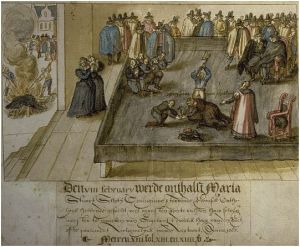
While in the UK on my Mary Queen of Scots tour, we visited many historic sites associated with her life story. This included a trip to Fotheringhay Castle, the scene of her execution on February 8, 1587. There is virtually nothing left of this significant castle but I climbed twenty three feet up to the top of the motte, looking down on the River Nene and across to the village and church and couldn’t help but feel something significant happened here. It turns out this castle has a pretty incredible history encompassing more than just Mary’s execution.
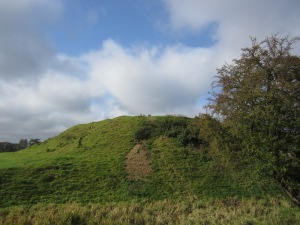
From the north, we entered the site through one of those crisscross gates. The land is a working sheep farm. To the west, there was a picturesque view of the village with the lantern tower of the church in full view. To the east, there was a field but you could tell there were some buildings existed on the spot at one time. Most likely this was the location of the Great Hall where Mary’s execution took place. And to the south the River Nene was lazily flowing by.
It is believed that in the time of the Angles and the Danes there was a ford over the river here before the bridge was built and a mound was erected to oversee and defend the crossing. Domesday Book which was commissioned by William the Conqueror indicates that Judith of Lens owned the manor at Fotheringhay. Judith was a niece of William, being the daughter of his sister Adelaide of Normandy, Countess of Aumale. In 1070, Judith married Earl Waltheof of Huntingdon and Northumbria. They had three children, their eldest daughter being named Maud.

Maud was married to Simon de St. Liz (Senlis), the Earl of Huntingdon and Northampton and he was the first to build a castle at Fotheringhay. This building was most likely made of wood and the present motte and inner bailey are possibly his work. The site was chosen to control an important river crossing but the castle probably was never considered an important military stronghold.
After Simon de St. Liz died in 1113, King Henry I of England arranged for his widow Maud to marry Prince David of Scotland. David gained domination over Maud’s vast estates in England including Fotheringhay. David became King of Scots in 1124 and Fotheringhay was passed on to his son Henry and his grandsons King Malcolm IV and King William the Lion. William gave the castle to his brother David, 8th Earl of Huntingdon who was one of the barons who rebelled against King John in 1215. King John seized Fotheringhay and it was granted to William Marshal, 2nd Earl of Pembroke. He managed to hang on to the property until December 1219 when he gave the castle to King Henry III.

At some point in the thirteenth century, the wooden castle was replaced with stone. Fotheringhay was considered to be part of the dowry of King Henry’s sister Joan when she was married to Alexander II, King of Scots although control was never actually transferred to Alexander. In 1221, custody of the castle was given to Hubert de Burgh, 1st Earl of Kent. William II de Forz, 3rd Earl of Albemarle rebelled against King Henry III and captured Fotheringhay, installing his own garrison. Henry raised a royal army which he took to Fotheringhay and Forz fled rather than meet them. King Henry retained control of the castle and it remained in royal possession until the reign of King Edward II when it was granted to John of Brittany, Earl of Richmond.
When John of Brittany died, his granddaughter Mary St. Pol inherited it. Mary was an interesting woman. In 1321 she married Aymer de Valance, the 2nd Earl of Pembroke and half-brother of King Henry III. Aymer died three years later. They had no children and Mary lived at Fotheringhay in her widowhood devoting herself to religion. In a charter from King Edward III in 1347, Marie was given the authority to found a house of scholars in Cambridge. In memory of her husband, she gave part of her fortune to the university, allowing students to study there and also gave property for them to live in. It is known as Pembroke College and it is the oldest college with an unbroken constitution from its foundation to survive on its original site.
There are historical records from 1341 indicating a stone tower stood on the motte. Also mentioned, within the inner bailey, are two chapels, a great hall, chambers and a kitchen. A group of buildings known as The Manor lay north west of the motte on the site of the Castle Farm. When Mary St. Pol died in 1377, by Royal Grant the castle was passed on to Edmund Langely, the fourth surviving son of King Edward III. Edmund was responsible for spending a great deal of money considerably enlarging and rebuilding the castle. In 1385, Edmund was granted the title of Duke of York and Fotheringhay became the principal seat of the Yorkists. Edmund died in 1402 and was succeeded by his eldest son Edward. Edward died at Agincourt in 1415 supposedly of the heat from being locked in his armor. His dying wish was to be buried in the collegiate church at Fotheringhay and he was interred there in December 1415.
Fotheringhay passed on to Edward’s brother Richard Plantagenet, Earl of Cambridge who was beheaded on suspicion of conspiracy against King Henry V. His son, Richard, Duke of York inherited the castle and it became the favored home of the Yorkist family. King Richard III was born at Fotheringhay in 1452 and Margaret of York , the future Duchess of Burgundy is believed to have been born here in 1446. During the height of the War of the Roses, Richard, Duke of York fought for the throne of England and his wife, Cecily Neville supported her husband’s efforts. Richard died at the Battle of Wakefield along with his son Edmund, Earl of Rutland in December 1460. Cecily’s eldest son did become King Edward IV and she soon received confirmation of her lands and rights. As a widow with enormous personal wealth she continued her patronage of religious houses and the college founded by her husband at Fotheringhay. She outlived her husband by thirty six years and adopted the role of Yorkist matriarch and entertained guests at the castle.
After her daughter Margaret left to marry Charles the Bold , Duke of Burgundy in June of 1468, Cecily moved to Berkhamstead Castle. Fotheringhay was granted to her son King Edward along with other estates. By 1469, King Edward IV and his wife Elizabeth Woodville would occasionally make Fotheringhay their residence. After Cecily Neville died in 1495, King Henry VII gave Fotheringhay to his wife, Elizabeth of York , King Edward IV’s daughter. King Henry VIII gave the castle to his wife Katherine of Aragon as part of her dower and she spent a great deal of money restoring the castle.
Under Queen Mary I, Fotheringhay became a state prison when Edward Courtenay was held in custody there on the charge of being implicated in the rebellion of Sir Thomas Wyatt. Queen Elizabeth I visited Fotheringhay in 1566. She may have remembered this visit when later in her reign she chose the castle as the place to hold the trial and execution of Mary Queen of Scots. The castle site was in a marshy landscape and access was difficult, especially during the heart of winter. The authorities thought it was a secure place and would discourage rash attempts to rescue her.
Execution of Mary Queen of Scots
Mary Queen of Scots was forced to abdicate her throne in July of 1567, turning it over to her infant son who became James VI, King of Scots. For unexplained reasons, after a daring escape from Lochleven Castle, she rode south to England, placing herself at the mercy of Queen Elizabeth I. Queen Elizabeth never forgave Mary for claiming the throne of England and held her in genteel custody. For the nearly twenty years of her captivity, Mary was the subject of many conspiracies and plots to kill Elizabeth and put herself on the throne. Eventually, through the efforts of a spy network orchestrated by Sir Francis Walsingham , Mary was implicated in what was called the Babington Plot. There was written confirmation that Mary was willing to kill Elizabeth and take the throne.
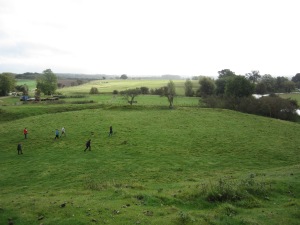
After the intercession of the English Parliament, Mary was brought to trial at Fotheringhay in the Great Hall on October 14 and 15, 1586. She was found guilty on October 25 and sentenced to death. Queen Elizabeth signed the death warrant on February 1, 1587 and her ministers hastened the execution before she changed her mind. Mary was told on February 7 that her execution was set for the next day. Mary spent the night executing her will and attending to her affairs.
There are different accounts of the execution but the tradition is that the executioner botched the job and it took several blows to sever the head. When the executioner went to pick up the head, he picked it up by the hair, only to have the hair remain in his hand and the head roll away as Mary was wearing a wig. One version of the story has one of Mary’s dogs emerging from underneath her skirts, refusing to leave her corpse. Mary’s corpse was kept at the castle until July when it was taken to Peterborough Cathedral and buried there.
A description of the castle exists from 1625. After that, Fotheringhay was abandoned and gradually all its stone masonry and walls were demolished with the materials being used to build other buildings. The Great Hall was stripped of its furnishings in 1628. The staircase Mary Queen of Scots had descended to her execution was used in the Talbot Inn in Oundle and can still be seen there today. The castle was fully gone by the eighteenth century.

A large block of limestone rubble, all that exists of the castle, sits beside the river surrounded by an iron fence. It was put there in 1913. There are three plaques on the fence. One states this is all that remains of Fotheringhay castle. One was placed there by the Stuart History Society and commemorates the death of Mary Queen of Scots. The third plaque was set up by the Richard III Society and commemorates the birth of King Richard. This is a small memento of the momentous events that occurred here. It’s a pity there isn’t more of this historic monument left.
Further reading: “Fotheringhay and Mary Queen of Scots” by Cuthbert Bede, “Cecily Neville, Mother of Kings” by Amy License
Share this:
- Click to share on Facebook (Opens in new window)
- Click to share on Twitter (Opens in new window)
- Click to share on Pinterest (Opens in new window)
- Click to share on Reddit (Opens in new window)
- Click to share on LinkedIn (Opens in new window)
- Click to share on WhatsApp (Opens in new window)
- Click to share on Tumblr (Opens in new window)
- Click to email a link to a friend (Opens in new window)
28 thoughts on “ The History of Fotheringhay Castle ”
[…] S (2015) The History of Fotheringhay Castle. Available from: https://thefreelancehistorywriter.com/2015/02/06/the-history-of-fotheringhay-castle/ [accessed […]
[…] charged Mary Queen of Scots with treason for her correspondence with the plotters. Put on trial at Fotheringhay Castle, they found her guilty and sentenced her to […]
[…] that Mary Queen of Scots was buried in Peterborough after she was executed in the Great Hall of Fotheringhay Castle. The burial site is directly across the aisle from Catherine of Aragon’s grave. When Mary’s […]
Visited the castle (field) and the church. We’re from South Yorkshire and visited nearby Sandal Castle at Wakefield where the Richard Duke of York and his son, Earl of Rutland were killed. It was nice to see their final resting place at the church. Stayed at the Talbot Inn and walked several times up and down the staircase that Mary had walked. very eerie.
Like Liked by 1 person
[…] was moved from the Tower to Fotheringhay on May 25 where he remained until April 6, 1555. The Queen believed she was pregnant and her […]
I love the castle and church, on my last visit I took some nice aerial pics which i am happy to share. They will appear here soon: http://www.yaamapping.co.uk
Excellent account, thank you. It’s on the ‘to visit’ list – undeterred by lack of buildings!
As a Fotheringham, the information posted is extremely interesting. I will definitely research further! Thank you for sharing.
Susan, Very nice writing of the castle history. Is the Fotheringay (many spellings) family noted by the surviving several glass heraldry of arms in the 1570-1580 era of Beaupre Hall, Norfolk, related to the castle?
Hi Jim, It does appear that Nicholas Beaupre married a Margaret Fodringhay in the early 16th C. but I’m not sure she had a connection to the castle at Fotheringhay. For more: https://en.wikipedia.org/wiki/Beaupr%C3%A9_Hall
[…] household and act independently. They had many castles to choose from as their personal home but Fotheringhay was their favorite and became their principal residence. Construction was begun near the castle on […]
[…] If you are keen to read more about the castle, and what it is like to visit today, I recommend The Freelance History Writer’s blog here […]
[…] Queen Elizabeth and place herself on the throne of England. She was found guilty and executed at Fotheringhay Castle on February 8, […]
[…] The History of Fotheringhay Castle […]
[…] of plotting the death of Elizabeth and putting herself on the English throne and was beheaded at Fotheringhay Castle on February 9, […]
[…] was born on May 3, 1446 either at Fotheringay Castle or Waltham Abbey during the War of the Roses. Her father was Richard, Duke of York and her mother […]
[…] visiting Fotheringhay Castle, the site of the execution of Mary Queen of Scots, we took a short walk down the road to St Mary […]
[…] While in the UK on my Mary Queen of Scots tour, we visited many historic sites associated with her life story. This included a trip to Fotheringhay Castle, the scene of her execution on February 8, 1587. There is virtually nothing left of this significant castle but I climbed twenty three feet up to the […] The Freelance History Writer […]
Other than it being the place of execution of MQoS I knew nothing of this castle. Thanks for the information.
One of my ancestors – Robert Wyatt- found Mary’s ring which is now in the V&A. He carved his name in the belfry of the church too.
Fascinating, Susan – I have never visited Fotheringhay and I didn’t realise how little of it there was left, but from your descriptions it sounds as if there is still a lot to ‘feel’ about the place. Wouldn’t it be wonderful to see it as it was? The beheading scenes fill me with horror and are part of the reason why I unfortunately cannot watch any historical dramas, no matter how good they are! I am intrigued by the story of the haunted staircase.
Yes the place did have that “feel”. Not just for Mary but for the Yorkists and the War of the Roses too. I would have loved to have seen the castle in it’s full glory. I did see the staircase in Oundle. It’s great but I didn’t see Mary! 😉
Maybe that was a blessing! 🙂
Reblogged this on History's Untold Treasures and commented: H/T The Freelance History Writer
Reblogged this on Marie Macpherson .
As always a fascinating article. Incidentally, the staircase is supposed to be haunted by Mary – so I suppose technically that means that Fotheringay was haunted by Mary and she just moved with the fitments!
I visited the Talbot Inn and saw the staircase Julia. Alas, I didn’t see Mary. It’s an interesting concept of the ghost moving to another building!
Reblogged this on Crash Course .
Leave a comment Cancel reply
This site uses Akismet to reduce spam. Learn how your comment data is processed .

- Already have a WordPress.com account? Log in now.
- Subscribe Subscribed
- Copy shortlink
- Report this content
- View post in Reader
- Manage subscriptions
- Collapse this bar
- Items for sale
Home / Visit
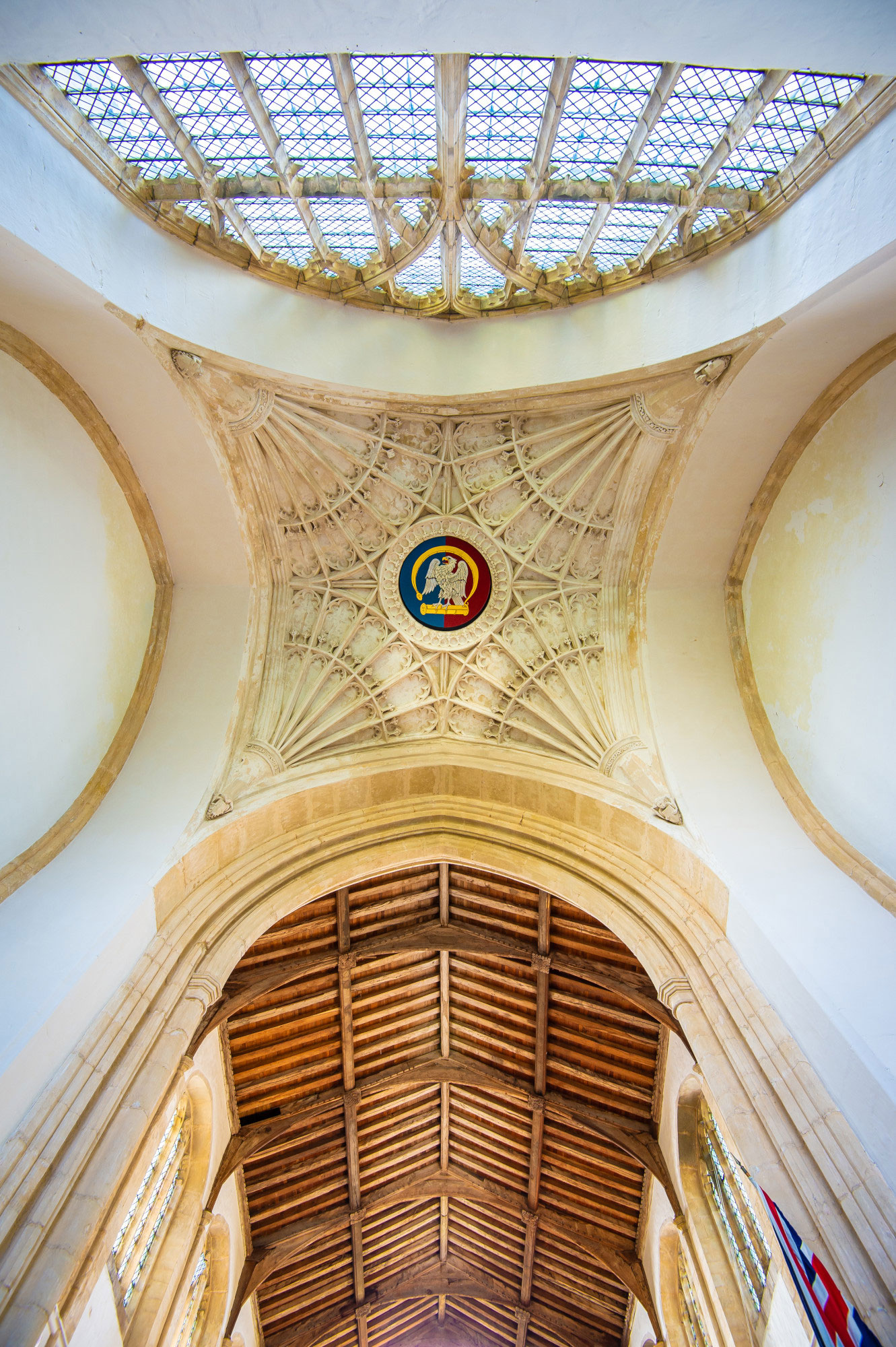
“On a warm summer’s day, Fotheringhay is a magic place. The church seems to float on its hill above the River Nene, a galleon of Perpendicular on a sea of corn.”
The Church of Saint Mary the Virgin and All Saints sits boldly at the heart of the village of Fotheringhay and is clearly visible from all approach roads.
Even the entrance gates at the start of the drive have a story to tell, having been demolished several times by errant drivers, one most recently distracted by spotting a rare bird in flight.
Entering the church through the north porch visitors are often struck not only by the size of the cavernous interior but just how light it is inside the building; a function of the ancient stained glass having been replaced centuries ago.
Prominent features to look out for include the 15th Century font, under the eastern arch of the tower, still used today, raised high on steps so that all the congregation can participate in the ceremony and topped with all that is left of the original misericords, featuring a joker’s cap.
Folklore has it that King Richard III may well have been baptised in the font, as he was born in Fotheringhay Castle in 1452.
Georgian Oak Box Pews sit either side of a wide nave area, installed in the early 19th Century at the behest of Thomas Belsey, a benefactor who purchased the territory of Fotheringhay in 1804 for the sum of £75,000; obviously a wealthy man in his day.
High above the arches and beneath the clerestory windows are the coats of arms of significant families associated with Fotheringhay and its church.
The 15th Century pulpit gifted to Fotheringhay Church by King Edward IV stands on a pedestal against the first pier of the north arcade. The pulpit is richly carved and ornamented, with emblems of Edward IV, the Duke of Clarence and Richard, Duke of Gloucester.
At the east end of the church is the Georgian Decalogue, or reredos as it forms a screen behind the altar, on which is inscribed the Apostles’ Creed, the Ten Commandments and the Lord’s Prayer.
The wooden week-day cross and candlesticks are modern and were made from bell-frame oak and the old bronze bell bearings, when the ancient bells were rehung in 1990. Either side of the altar sit the Elizabethan tombs, commissioned after Elizabeth I visited the village in 1566. The monument on the right of the altar commemorates Edward, Second Duke of York, killed at the Battle of Agincourt in 1415 and on the left, his nephew, Richard, Third Duke of York, killed with his son Edmund, Duke of Rutland, at the Battle of Wakefield in 1460 and his wife Cecily Neville, known as The Rose of Raby.
The organ was installed in 2000. It is a mechanical action, two-manual pedal organ housed within a solid oak casing.
High over the eastern tower arch at the west end of the nave, near to the porch entrance, is a hatchment of the Royal Arms dating from the reign of George III.
The windows of the church originally contained remarkable images and icons reflecting its history. Few fragments survive and some are installed in the form of three window screens in the upper room of the tower. A close look at the aisle and clerestory windows reveals they are not totally clear but coloured, most evident when the sun shines. A new window, referred to as The York Window, dedicated in 1975, was a gift to the church from The Richard III Society and incorporates the arms of Richard III, Anne Neville, the Founders of the Collegiate Church, Benefactors and their wives.
Two sets of display boards, located in the South Aisle, recount one thousand years of Fotheringhay history, punctuated by the execution in Fotheringhay Castle of Mary, Queen of Scots in 1587.
The exterior of the church has many interesting historical and architectural features giving some insight into its dimensions when at its fullest extent and prior to the dismantling and demolition of the collegiate buildings at the hands of the Duke of Northumberland in 1548.
The Church is typically open from 9:30am until 5:00pm in spring summer months and otherwise closes at dusk.
Those journeying a significant distance should refer to the Warmington Benefice website for up-to-date information on opening and service times.
The church is open again to visitors each day from 9:30am to 5:00pm. A donation on your departure towards the upkeep of the church will be greatly appreciated.
www.warmingtonbenefice.org.ok
Latest news
Find the latest news and updates from The Friends of Fotheringhay Church, including updates on the Church of Saint Mary the Virgin and All Saints, as well as the village and surrounding area.
Award for our organist.
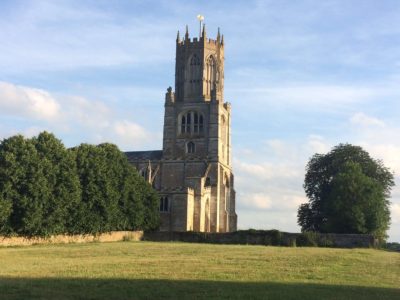
Diary 2021.
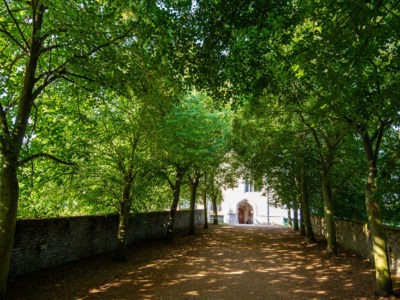
Annual General Meeting – 2020.
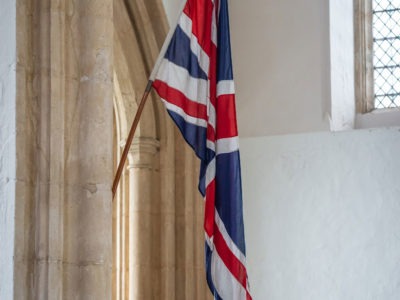
Annual General Meeting – 2019.
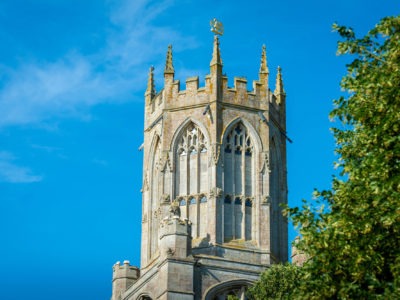
Church Repairs Completed.
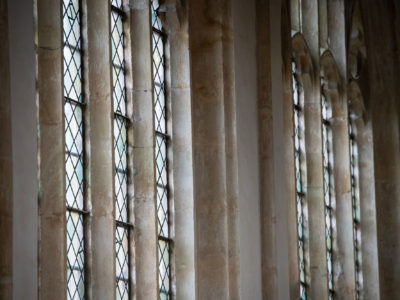
Church Appeal Update.
Plan a Visit
Experience part of history.
If you are looking to visit Fotheringhay, we can help provide you with all the information you need to plan out your visit and have the most enjoyable experience of the village, Church and surrounding areas. Learn more about the delightful landscape, sights and sounds of the local area, and the deep history of Fotheringhay village and the Church, so that when you arrive, you can truly get the most out of your visit.
Testimonials
“Whilst on a countryside walk, we stepped into this lovely church and were so glad that we did. Although a working church, there is also space for a small museum and the story of the church.”
“Glancing at the details of the church building and monuments, you know you are in King Richard III country and a place with royal historic connections.”
“A fascinating, and very old, church with useful information on the history of Fotheringhay and Mary Queen of Scots.”
“An unusual church, having lost over half its length when it's collegiate function was taken away during the reformation. The remaining building is high and wide with the seating in box pews.”
Privacy Overview

The 40 Most Beautiful Castles You Can Visit in the United States
Posted: April 11, 2024 | Last updated: April 11, 2024
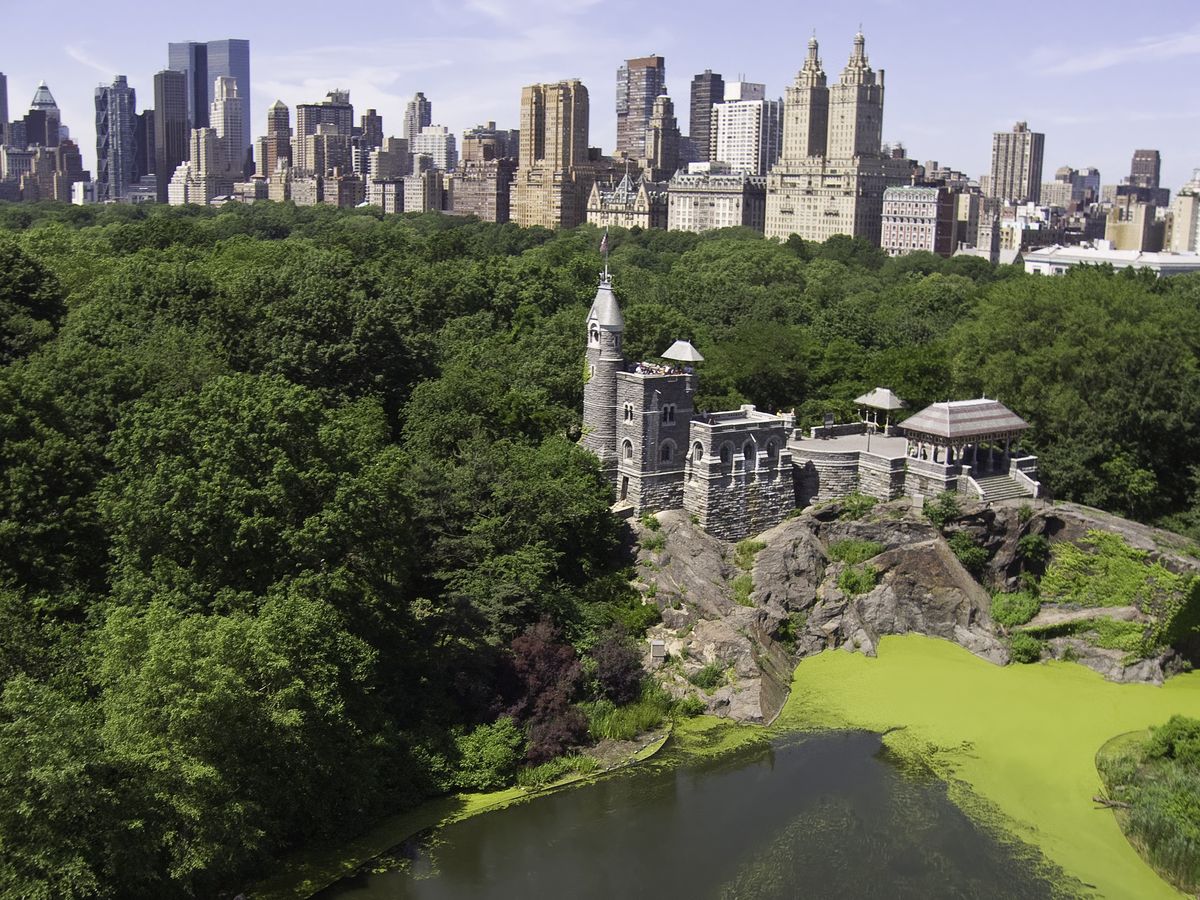
Belvedere Castle (New York)
Sitting pretty in the middle of New York City's Central Park is one of the country's most famous castles. Completed in 1872 , the park's co-designer, Calvert Vaux, wanted the Gothic structure to serve as a surprising landmark for visitors to discover on their walks.
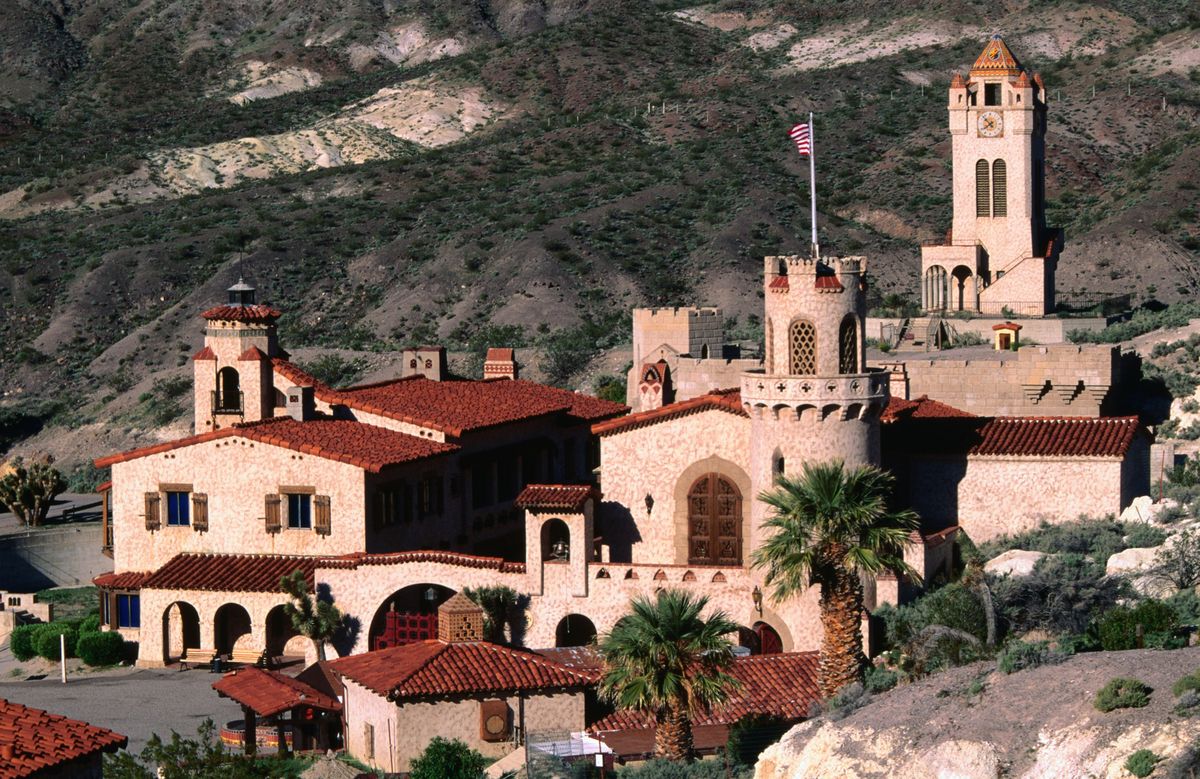
Scotty's Castle (California)
Walter E. Scott was a con man and gold prospector who convinced a Chicago couple, Albert and Bessie Johnson, to build this 1922 Spanish-style castle in Death Valley National Park, California. Though Scott never owned or lived in it, he was the inspiration behind its name.

Iolani Palace (Hawaii)
Iolani Palace is the only official royal residence located in the United States and is located in downtown Honolulu, Hawaii. The island's last two monarchs lived in it from 1882 to 1893, but it later fell into disrepair—until it was renovated and reopened in 1978.
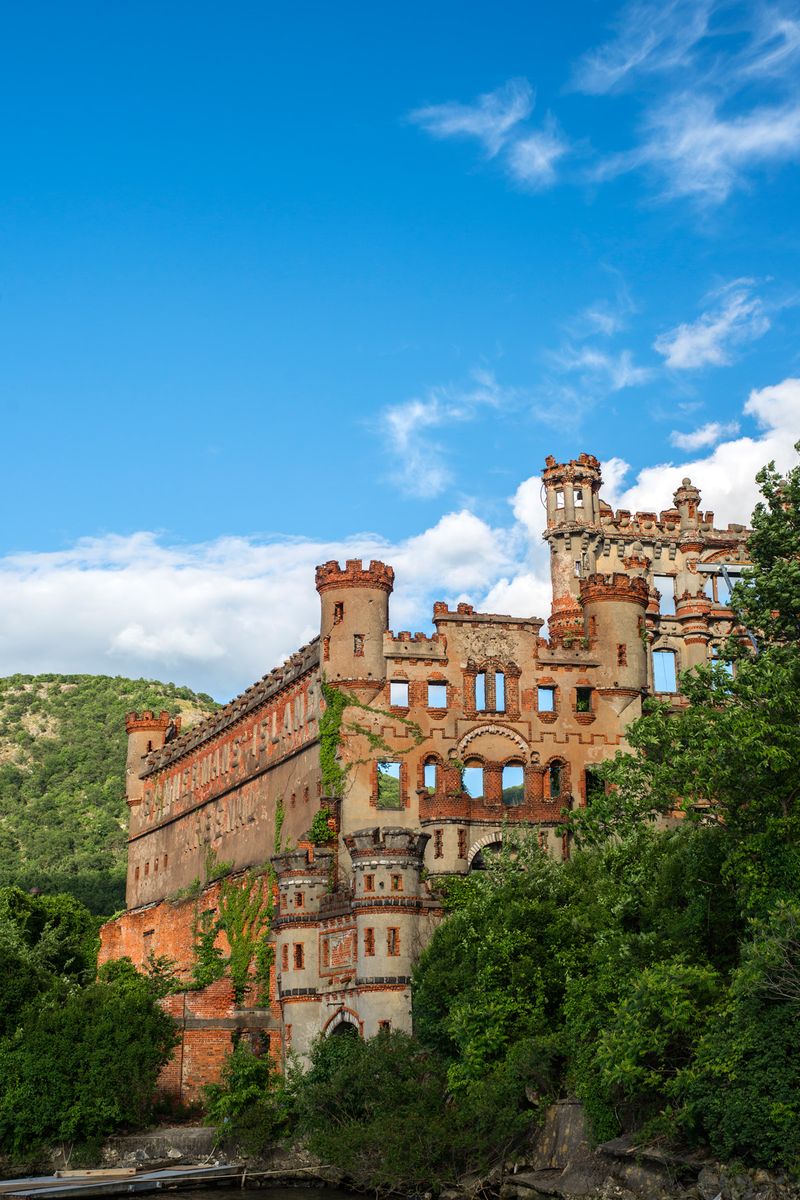
Bannerman Castle (New York)
Francis Bannerman VI , a Scottish-born owner of a military surplus supply company, built this castle in 1901. A fire destroyed it in 1969, leaving it to become the ruins you see today in the middle of the Hudson River in Beacon, New York.

Castello di Amorosa (California)
It took 15 years to build this 13th-century replica of a Tuscan castle , located in the middle of California's Napa Valley. The wait was worth it: It's a huge tourist attraction today, offering tours and wine tastings.
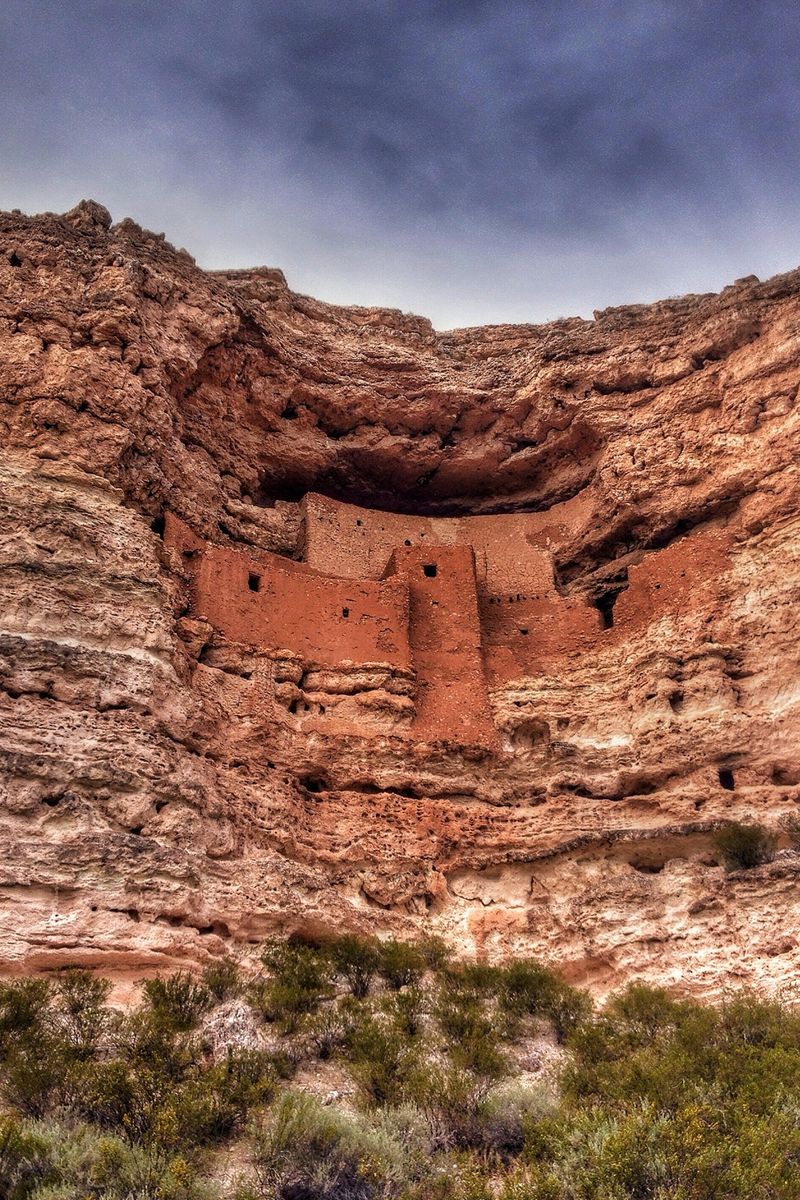
Montezuma Castle (Arizona)
The Sinagua people built this 20-room castle on a cliff approximately 800 years ago in what is known today as Camp Verde, Arizona. While it's too fragile to allow tourists inside, the view from below makes it worth visiting.

Lyndhurst Mansion (New York)
Located in Tarrytown, New York, this 1838 mansion overlooking the Hudson River is one of the country's best examples of Gothic Revival architecture. It was built for New York City Mayor William Paulding and was later bought by railroad tycoon Jay Gould. Today, it serves as a museum and wedding venue. Fun fact: It was also a filming location for The Gilded Age on HBO .

Hearst Castle (California)
Newspaper mogul William Randolph Hearst built this Julia Morgan-designed castle in San Simeon, California, to serve as his private residence. He lived in it while it was being renovated, but unfortunately, his failing health meant he never saw it finished and he moved out of the 165-room estate in 1947. It's currently a museum that's open to the public.
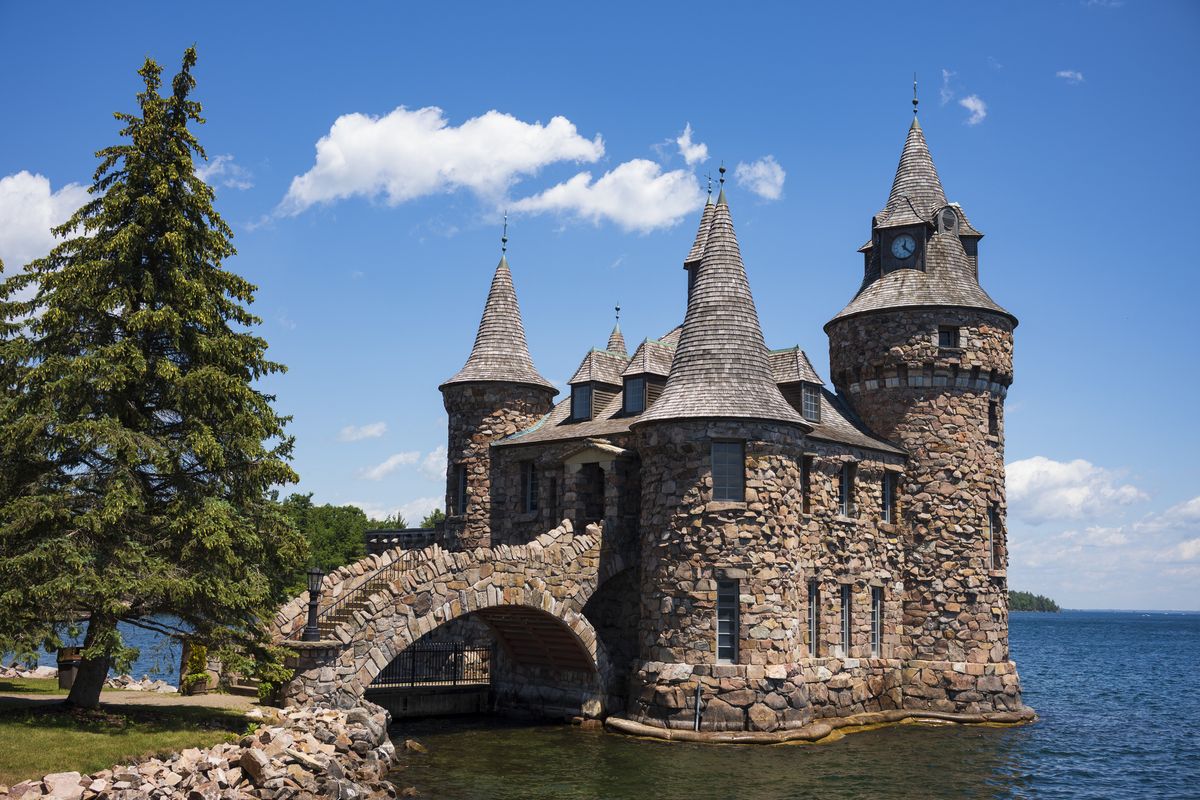
Boldt Castle (New York)
In 1900, the owner of New York's Waldorf Astoria Hotel, George C. Boldt, built this 120-room castle for his wife, Louise, on an island in the St. Lawrence River in Alexandria, New York. Sadly, Louise died unexpectedly months before it was completed, so a heartbroken George stopped construction and it was left vacant for 73 years—until the Thousand Islands Bridge Authority restored and opened it in 1977.
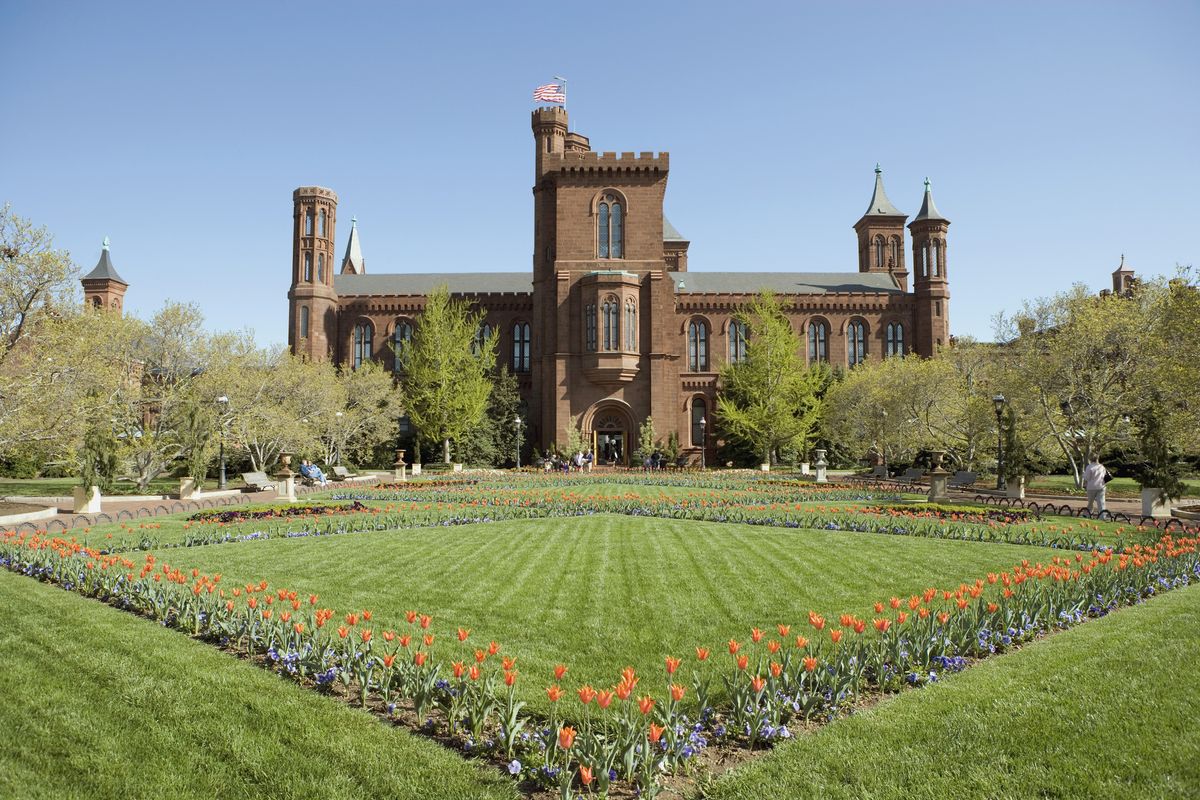
Smithsonian Institute Building (Washington, D.C.)
Located near the center of the National Mall in Washington, D.C. is this Norman-style structure . It was made from red sandstone in 1855 and served as the home and office of Joseph Henry (the first Secretary of the Smithsonian). However, today it's the visitors center for the Smithsonian Institute.
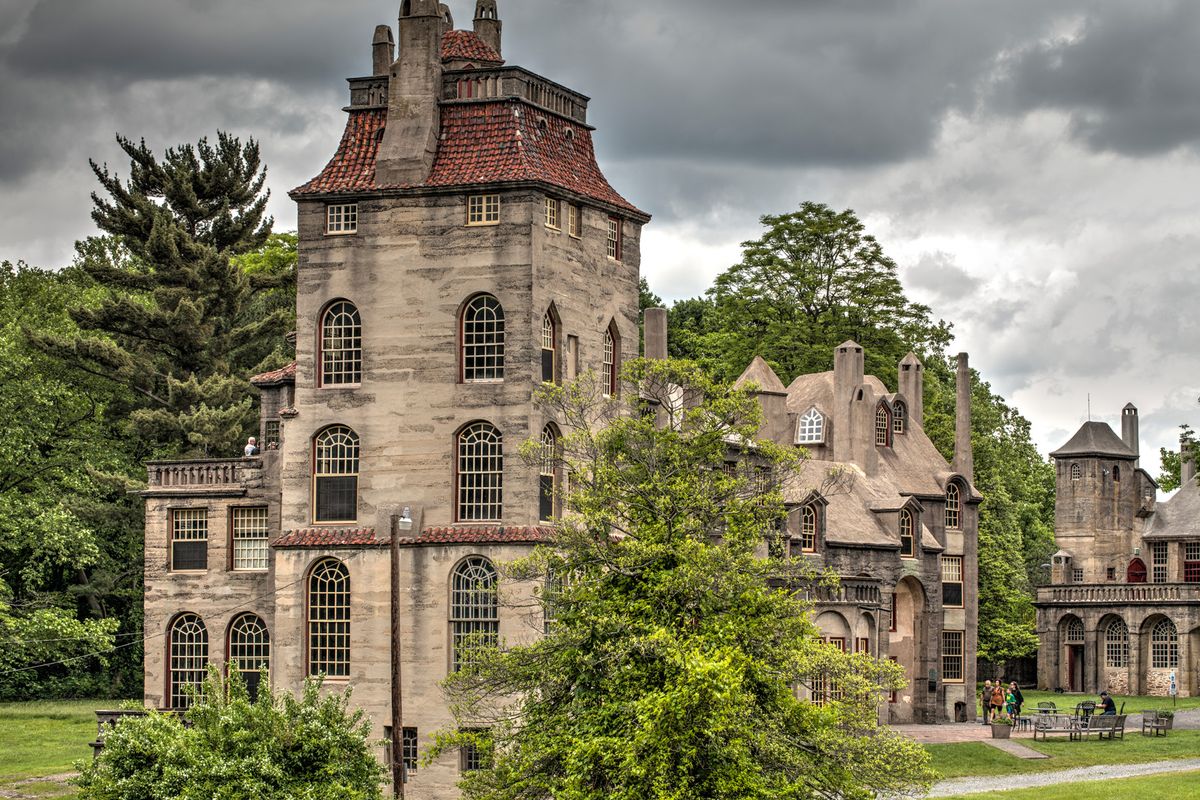
Fonthill Castle (Pennsylvania)
Henry Chapman Mercer, an archaeologist, artifact collector, and tilemaker, built this beauty in Doylestown, Pennsylvania, from 1908 to 1912. He chose a combination of medieval, Gothic, and Byzantine architectural styles for his home, which also served as a museum for his tiles and prints.

Biltmore Estate (North Carolina)
After George Vanderbilt visited the Blue Ridge Mountains near Asheville, North Carolina, in 1898, he fell in love with the area and built this estate. The 250-room French Renaissance chateau took six years to build, with the help of architect Richard Morris Hunt and landscape architect Frederick Law Olmsted. Now, the estate boasts an award-winning vineyard and winery.
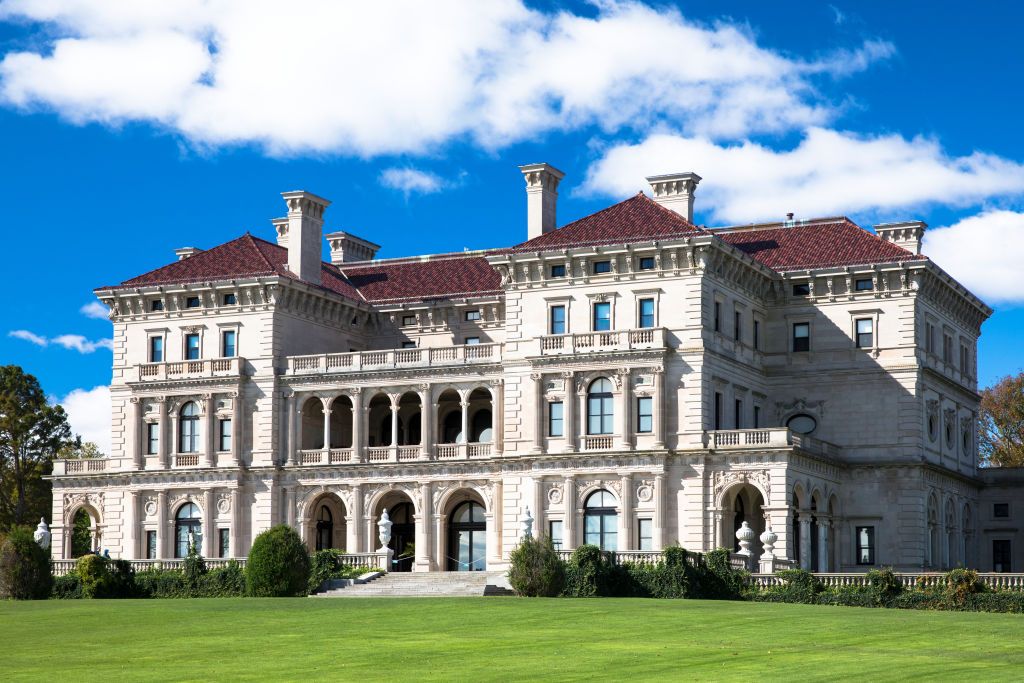
The Breakers (Rhode Island)
Look familiar? This Newport, Rhode Island, estate was also built by a Vanderbilt (this time Cornelius Vanderbilt II) and designed by architect Richard Morris Hunt in the late 19th century. The 70-room mansion was inspired by Italian Renaissance palaces from 16th-century Genoa and Turin.
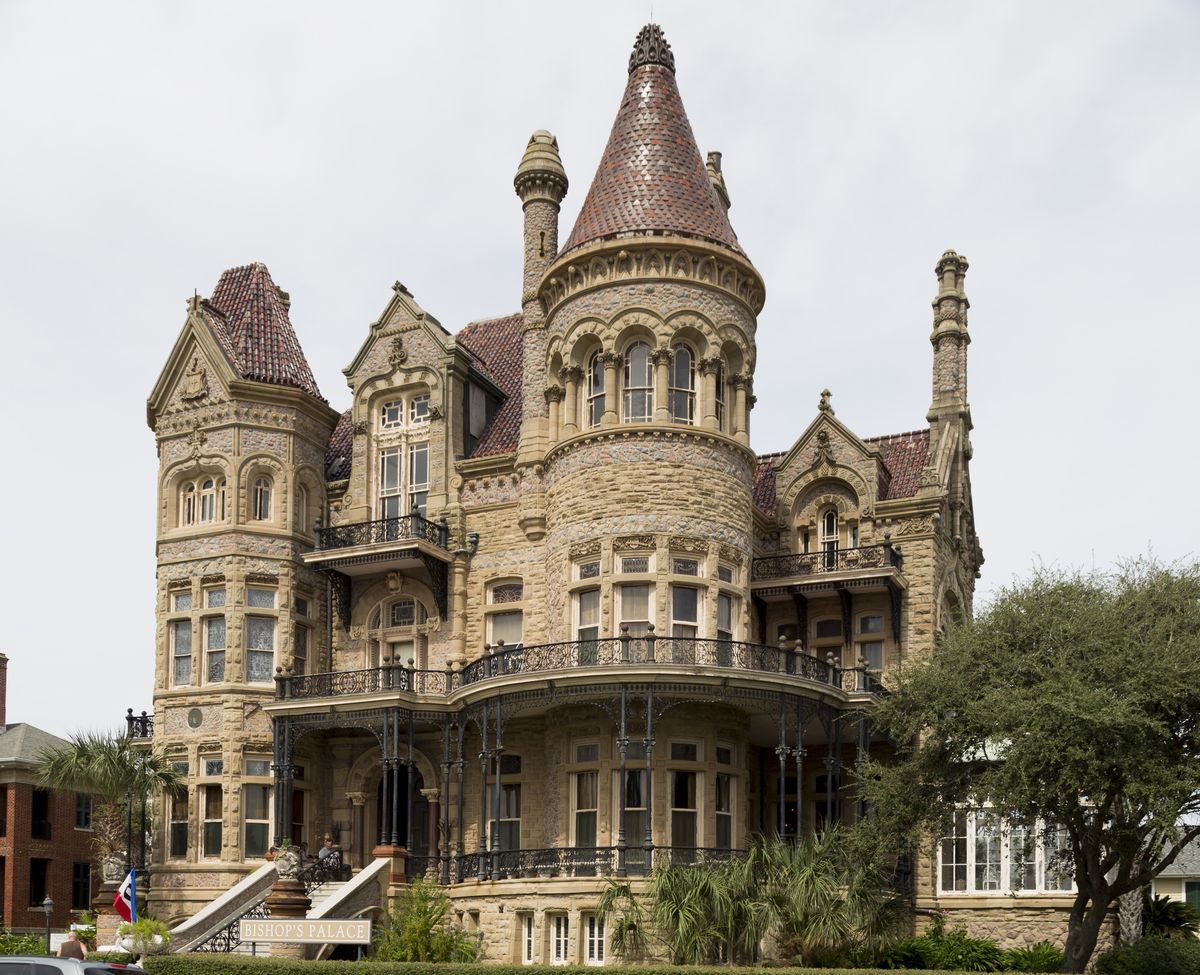
Bishop's Palace (Texas)
Previously known as Gresham Castle, this Victorian stunner in Galveston, Texas, was built by lawyer and railroad entrepreneur Colonel Walter Gresham and architect Nicholas Clayton from 1887 to 1892 . It went on to serve as a Catholic bishop's residence—hence the new name.
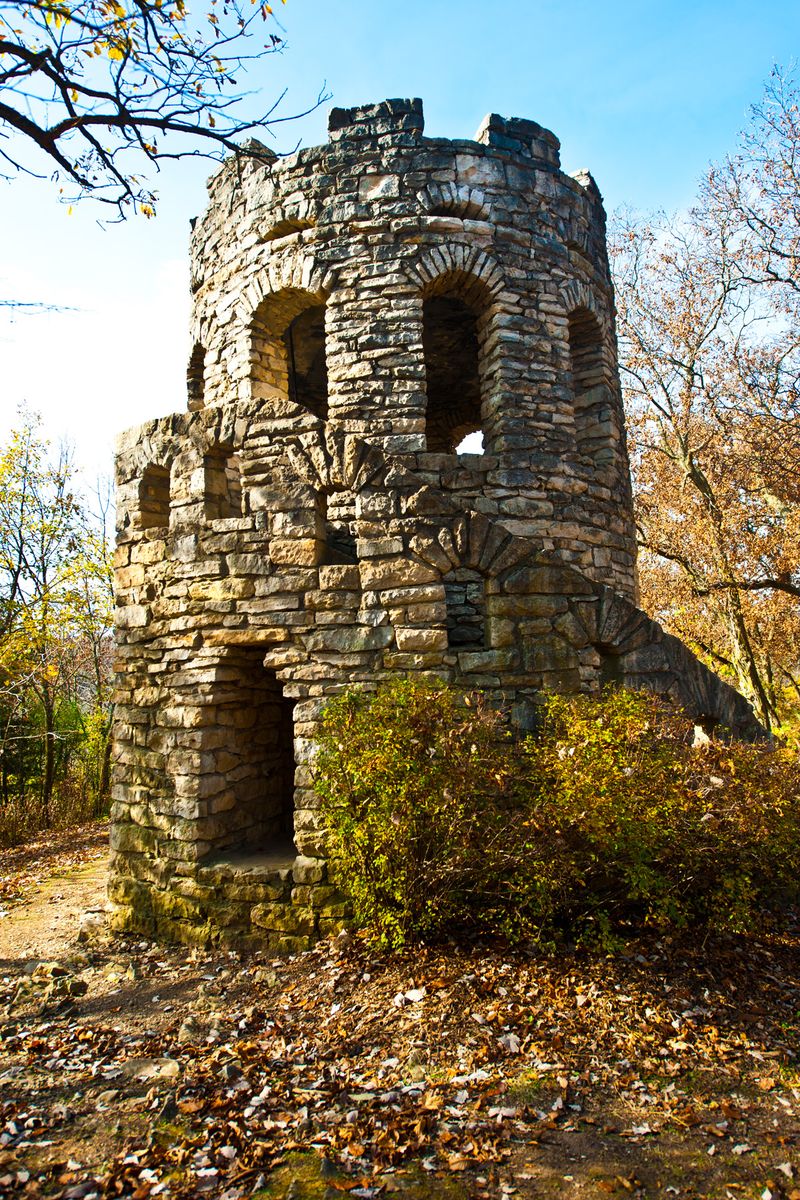
Clark Tower (Iowa)
Back in 1926, this 25-foot limestone castle tower was built in honor of Caleb and Ruth Clark, pioneers of Madison County, Iowa . The three-story tower overlooks the Middle River valley and is only accessible by a narrow, one-way, winding road.
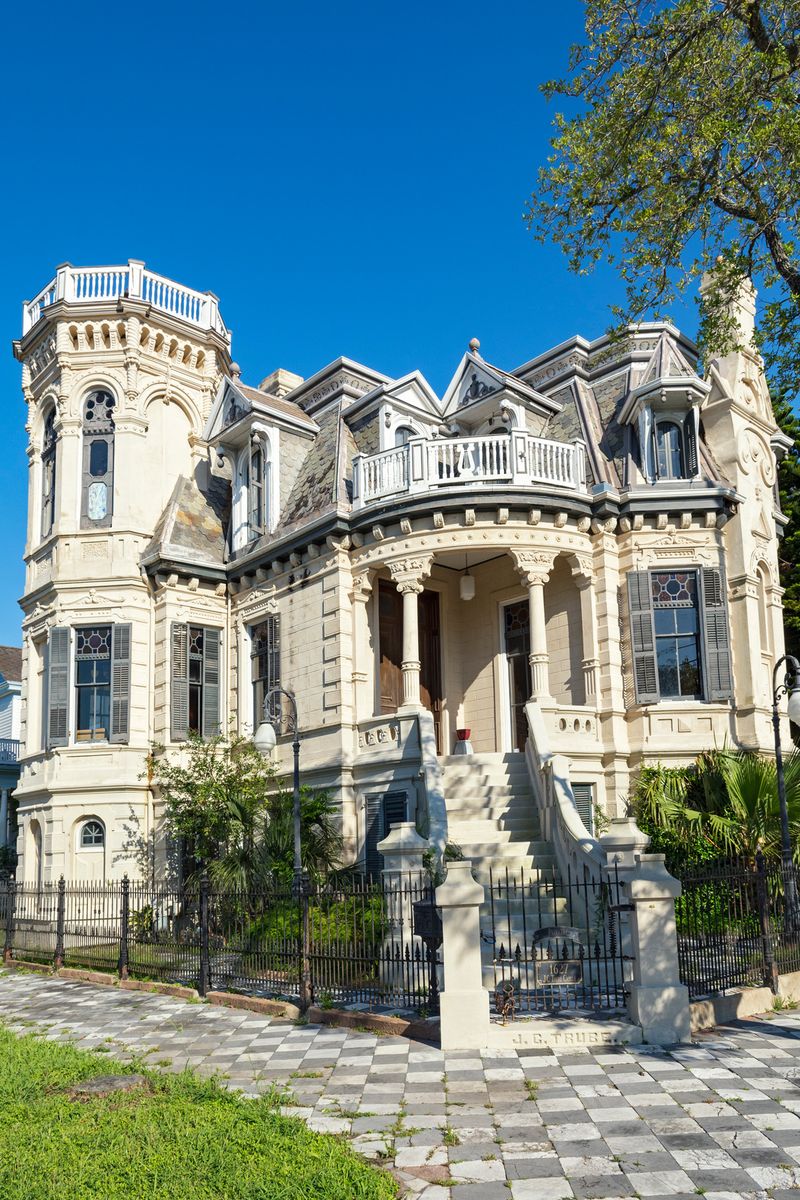
Trube House (Texas)
In 1890, John Clement Trube (who was from Kiel, Denmark) built this Danish-inspired castle home in Galveston, Texas, with the help of architect Alfred Muller. The castle was declared a Texas Historic Landmark in 1965.
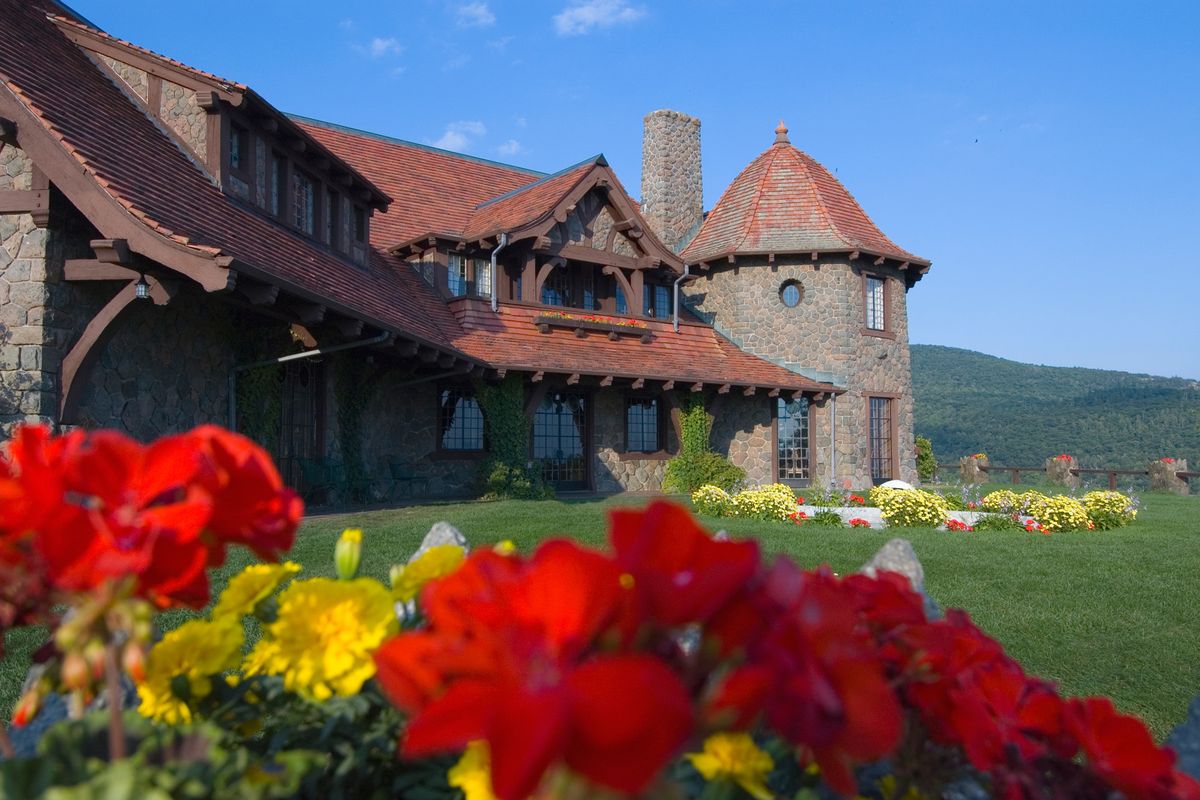
Castle in the Clouds (New Hampshire)
Also known as Lucknow Estate , this Moultonborough, New Hampshire–based structure was built from 1913 to 1914 by shoe manufacturer and millionaire Tom Plant. It served as his escape in the Ossipee Mountains and was designed to keep harmony with nature.
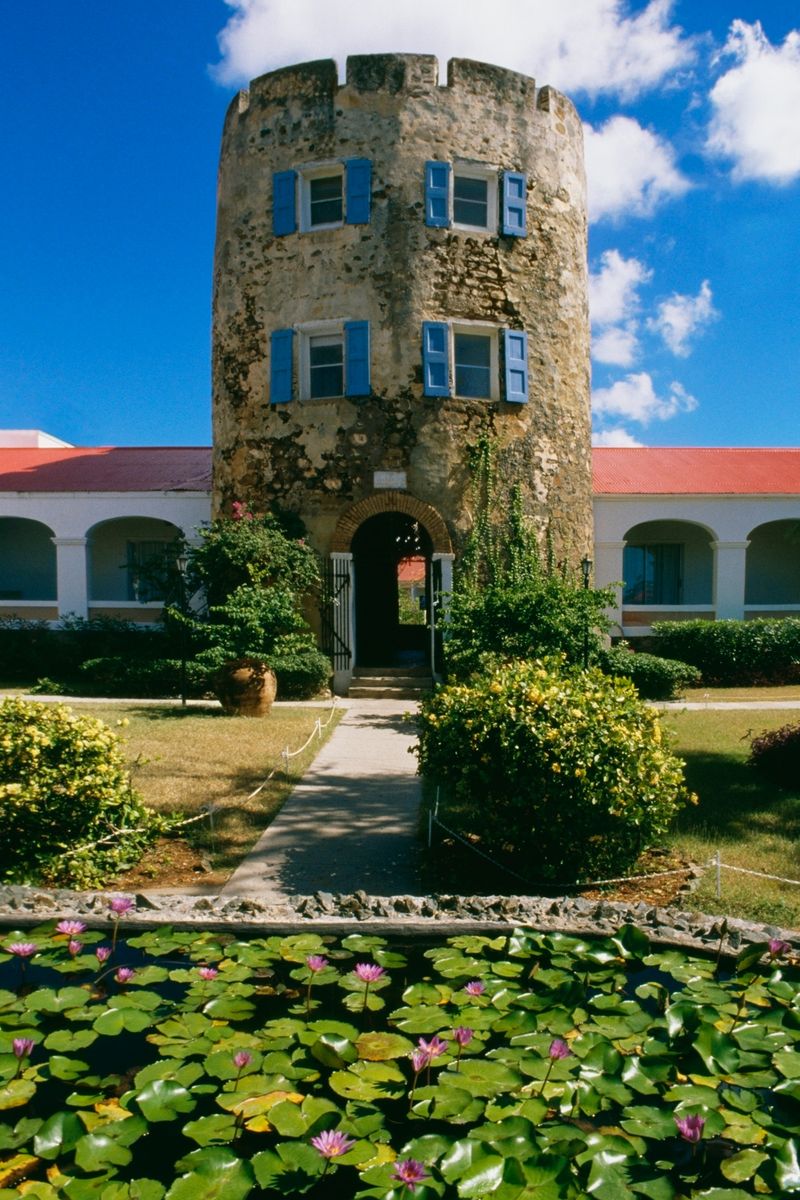
Bluebeard's Castle (Virgin Islands)
Based on St. Thomas, one of the U.S. Virgin Islands, this castle has had many different lives. It was first built by the Danes in the late 1600s as a stronghold to help reinforce Fort Christian. It was later purchased by the U.S. Government in 1933 and turned into a hotel to help promote tourism. Even President Franklin D. Roosevelt visited it in 1934.

Castle Williams (New York)
This circular fortification made out of red sandstone was built in the early 19th century on Governors Island, New York, to protect New York City from a naval attack. However, as of 2003, it was transferred to the National Park Service under the administration of the Governors Island National Monument.
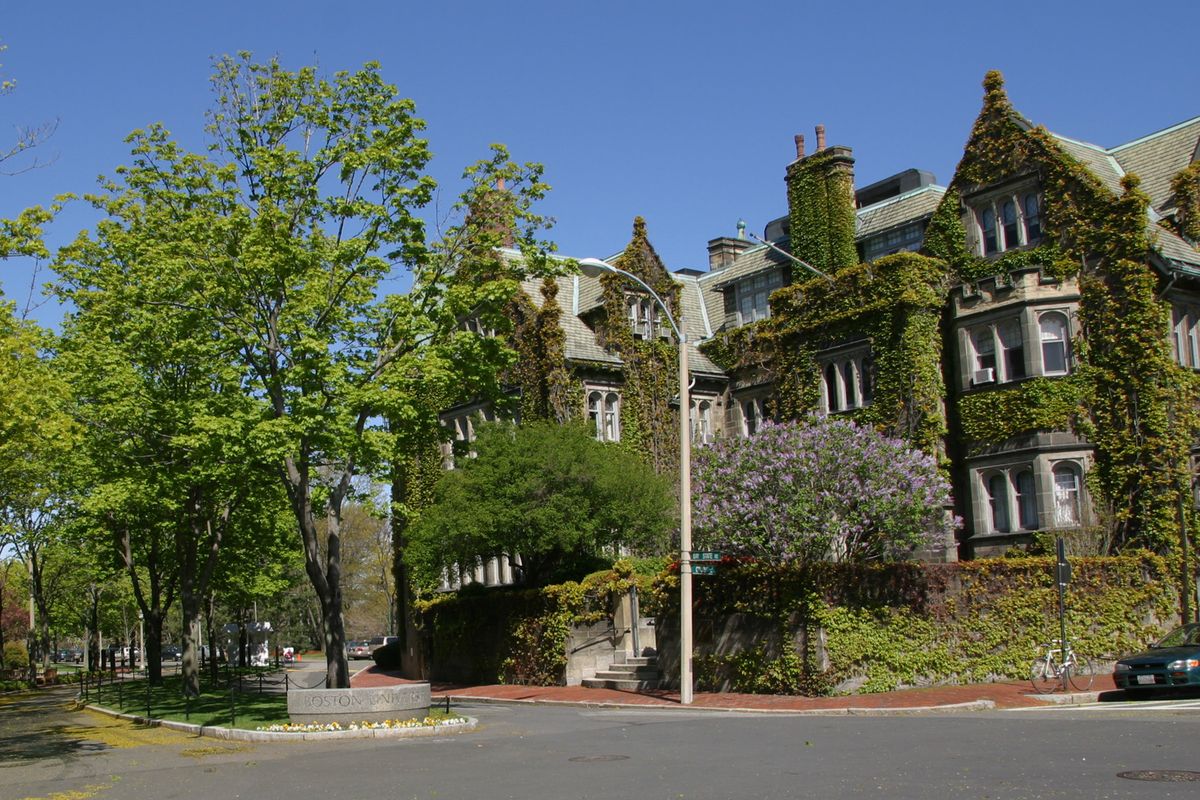
Boston University Castle (Massachusetts)
Prominent Boston businessman William Lindsey built this castle to serve as his home in 1915. After changing hands, it was donated to Boston University in 1938. Today, the Tudor Revival-style castle is used by the school for receptions and concerts and is also rented out for special occasions.
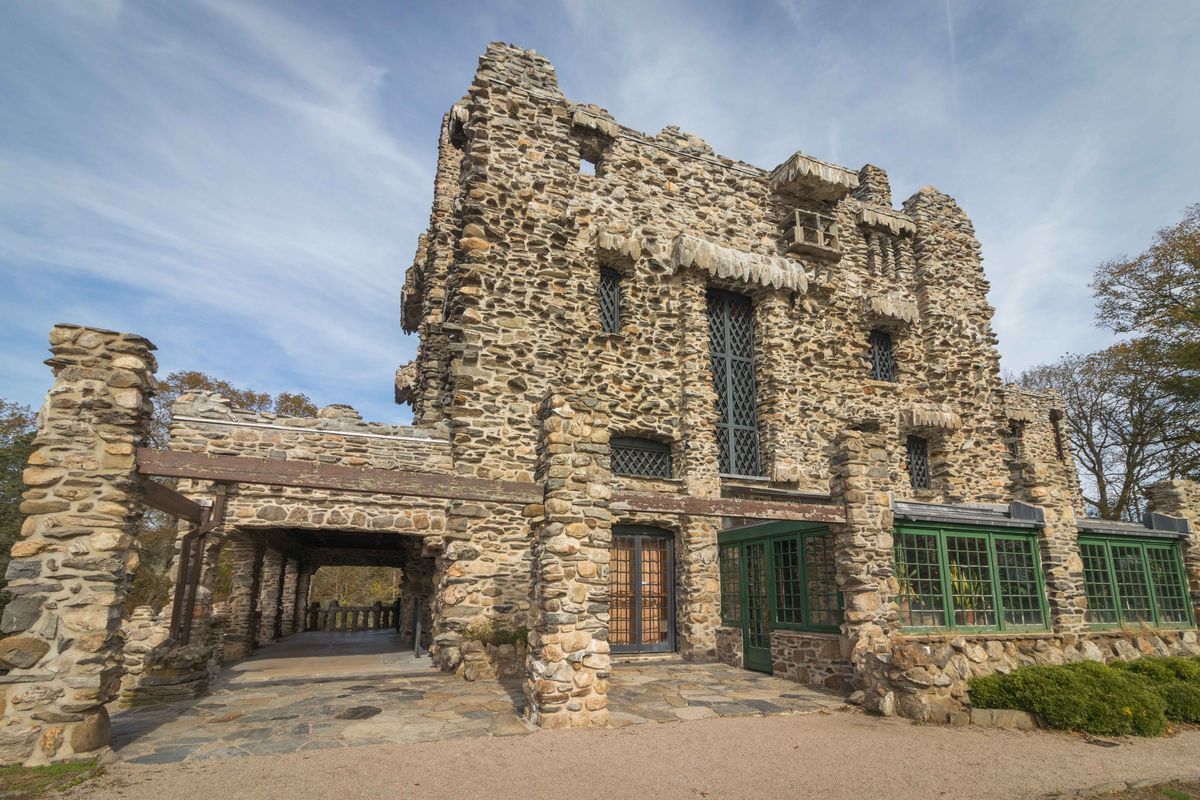
Gillette Castle (Connecticut)
In 1914, actor, director, and playwright William Hooker Gillette built this castle in East Haddam, Connecticut, as part of his estate. Even though the outside looks like ruins, the inside is full of modern innovations—making it especially unique.

Lambert Castle (New Jersey)
In 1892, Catholina Lambert — the owner of a prominent silk mill—built this Medieval Revival home in Paterson, New Jersey. His goal was to replicate the castles he remembered from his childhood in Great Britain. It was originally called Belle Vista, but the name changed when it was sold to the City of Paterson in 1923 after Lambert's death.
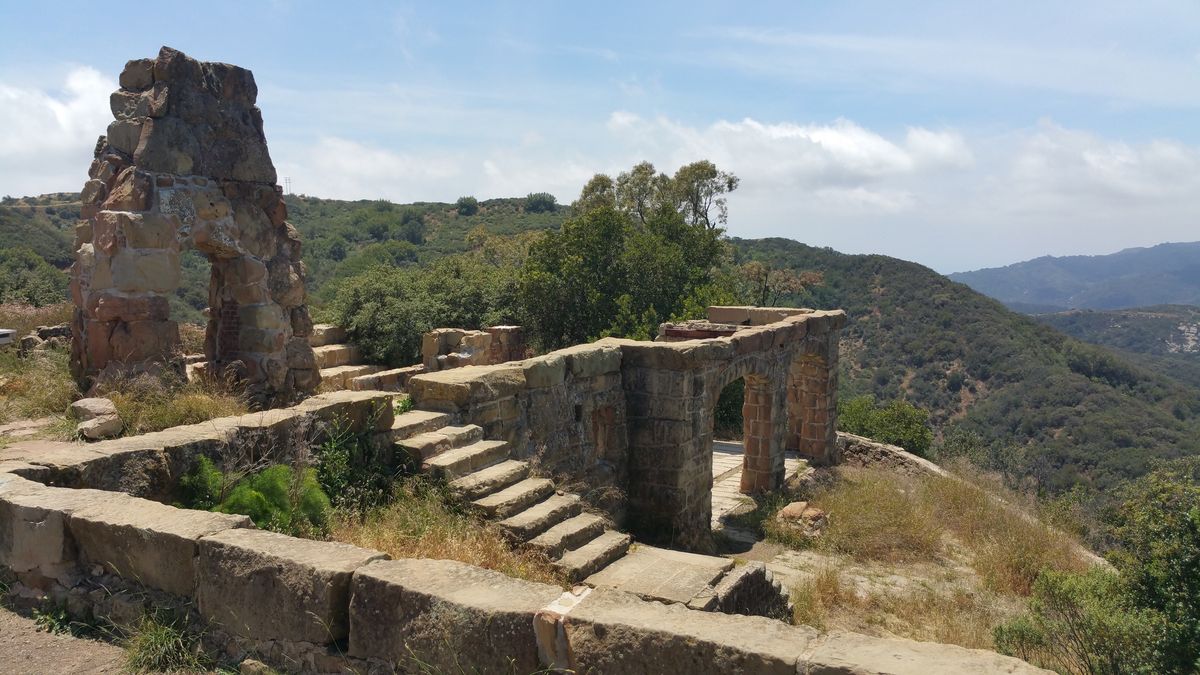
Knapp's Castle (California)
George Owen Knapp, the founder of Union Carbide, built this California home in 1916—but it was destroyed in 1940 by a forest fire. Only the sandstone foundation, fireplace pillars, and walls of the original structure remain, making it a popular destination for hikers and photographers.
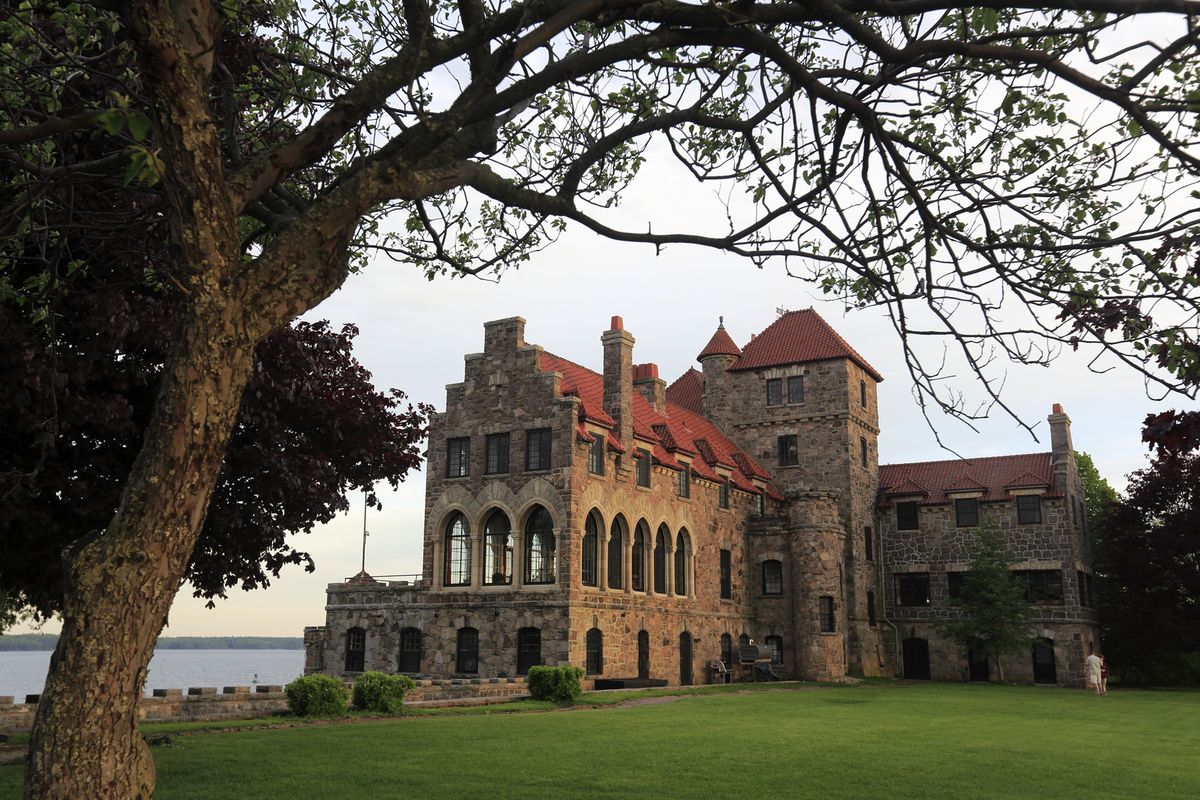
Singer Castle (New York)
Construction began on this estate, located on Dark Island near New York's Chippewa Bay, in 1905. It was commissioned by Frederick Bourne , the fifth President of the Singer Sewing Machine Company—hence the name. It remained in possession of the original owners until the mid-1960s.

Morningside Castle (New York)
This sight for sore eyes on the Upper West Side of Manhattan was built in a Gothic architecture style that almost blends into the city streets. Today, it serves as a beautiful wedding venue .
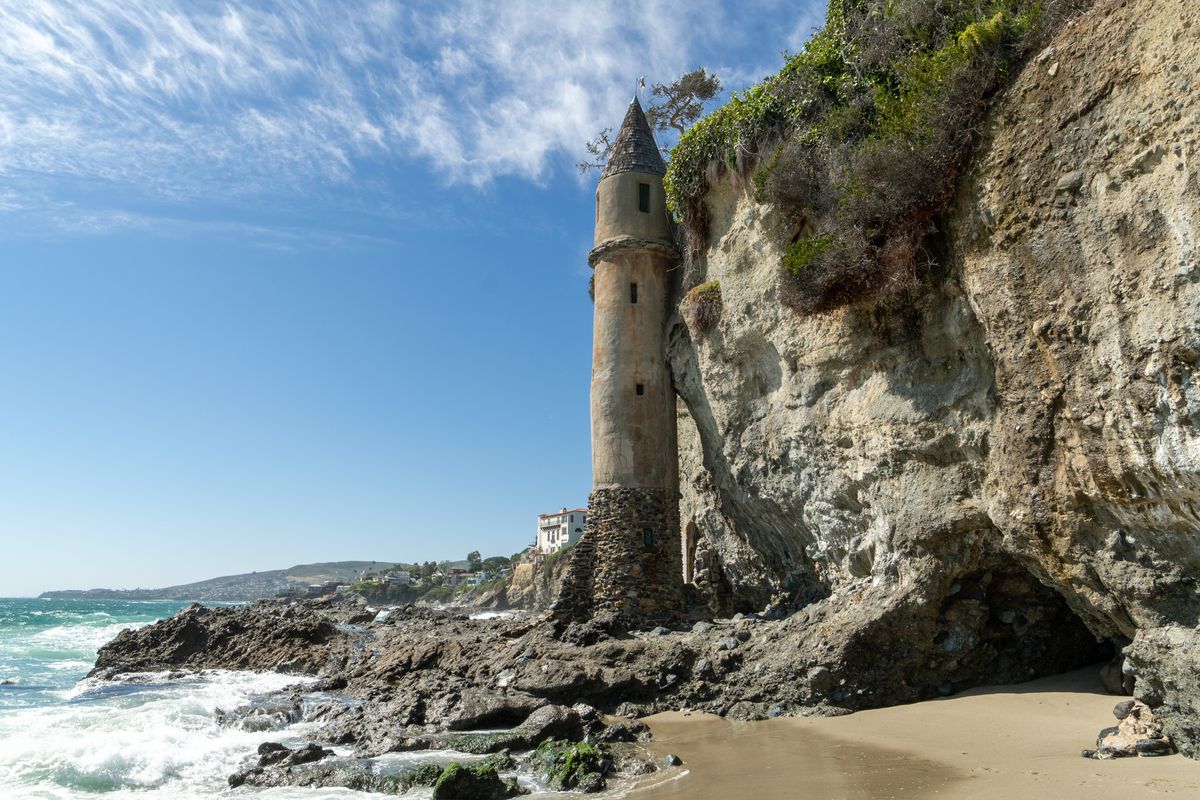
Victoria Beach Pirate Tower (California)
This 60-foot spire built into a rocky beach cliff in Laguna Beach, California, was originally built in 1926 by the owners of the house at the top of the cliff to serve as a private staircase to the beach. However, over the years, the tower has changed hands—once even supposedly belonging to Bette Midler .

Hovenweep Castle (Utah)
These Ancestral Puebloan ruins once served as home to 2,500 people and were built between 1200 and 1300 A.D. Today, they are part of the Hovenweep National Monument , which spans across southwestern Colorado and southeastern Utah.
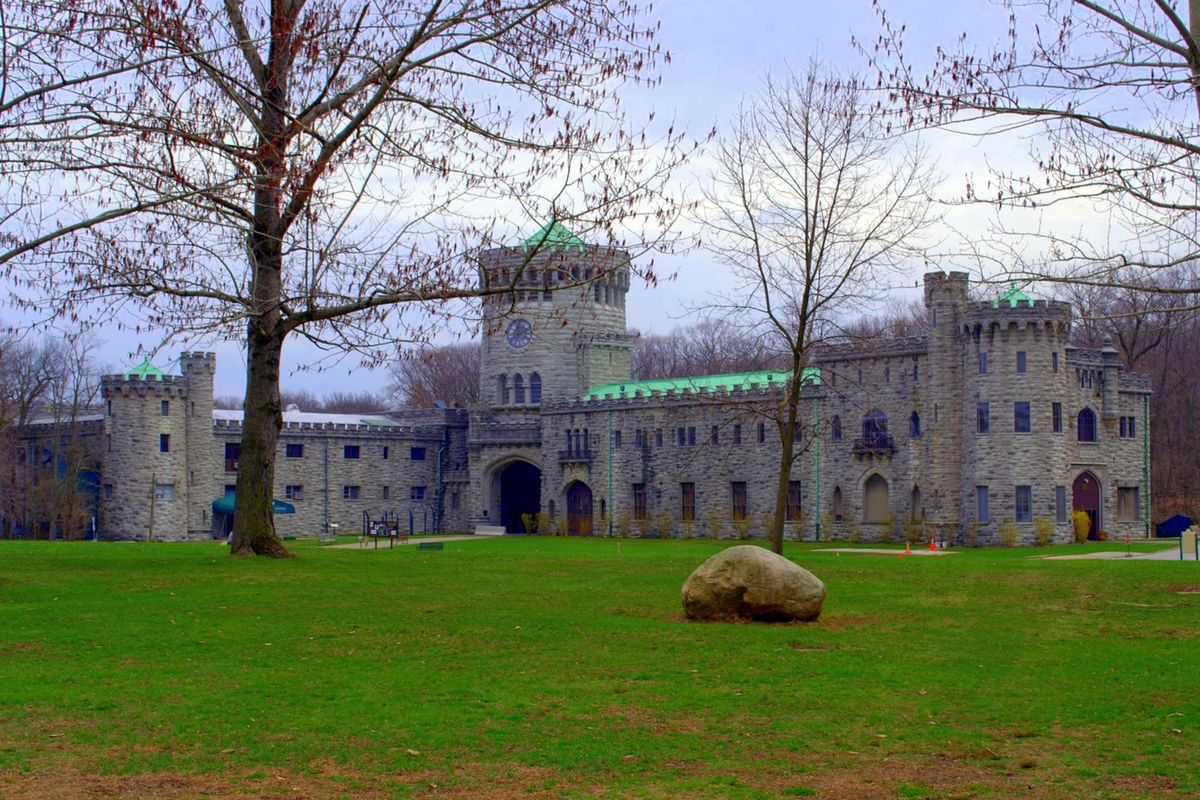
Castle Gould (New York)
In 1900, Howard Gould and his wife, actress Katherine Clemmons, purchased the Sands Point, New York, property that Castle Gould and three more mansions would be built on. This one was designed by architect Augustus N. Allen in 1902 and was inspired by Ireland's Kilkenny Castle.
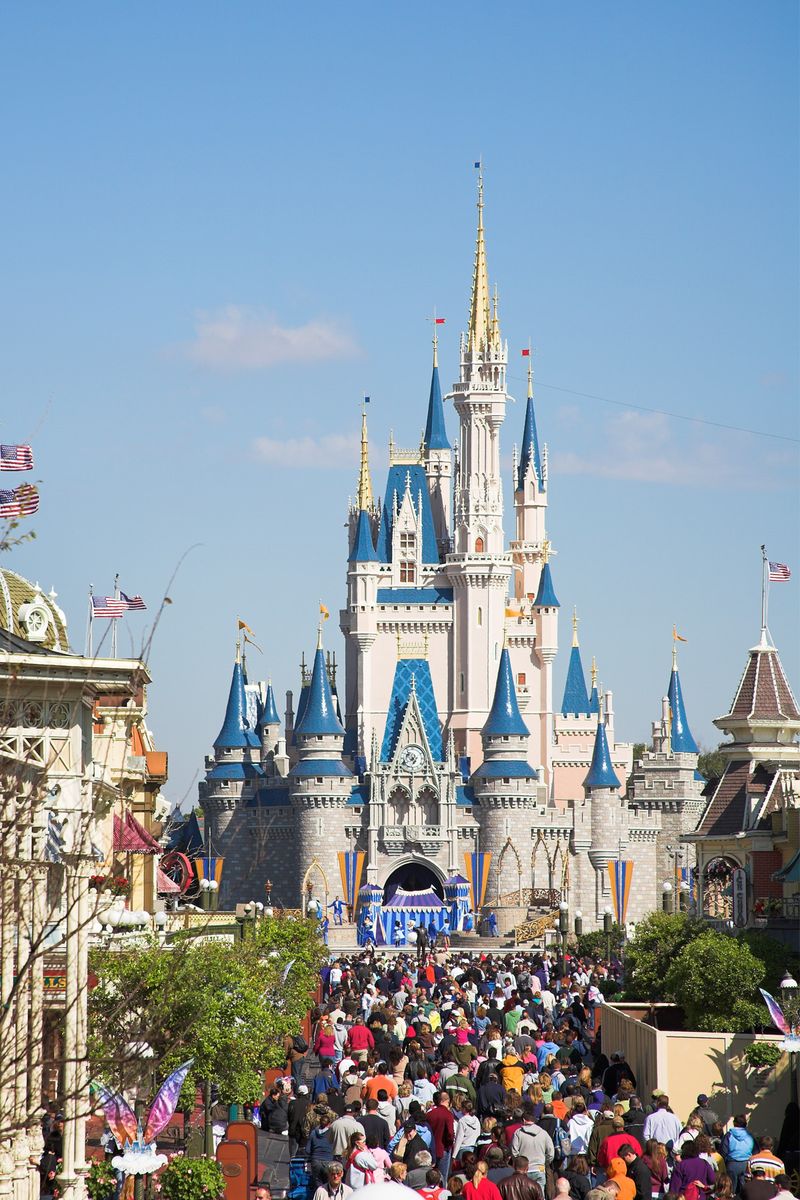
Cinderella Castle (Florida)
Perhaps the most famous castle in the country is this beauty at the Walt Disney World Resort (not to be confused with Sleeping Beauty Castle in California's Disneyland) . It was inspired by many real palaces , most notably Neuschwanstein Castle in Germany. It took 19 months to build and opened in July 1971.
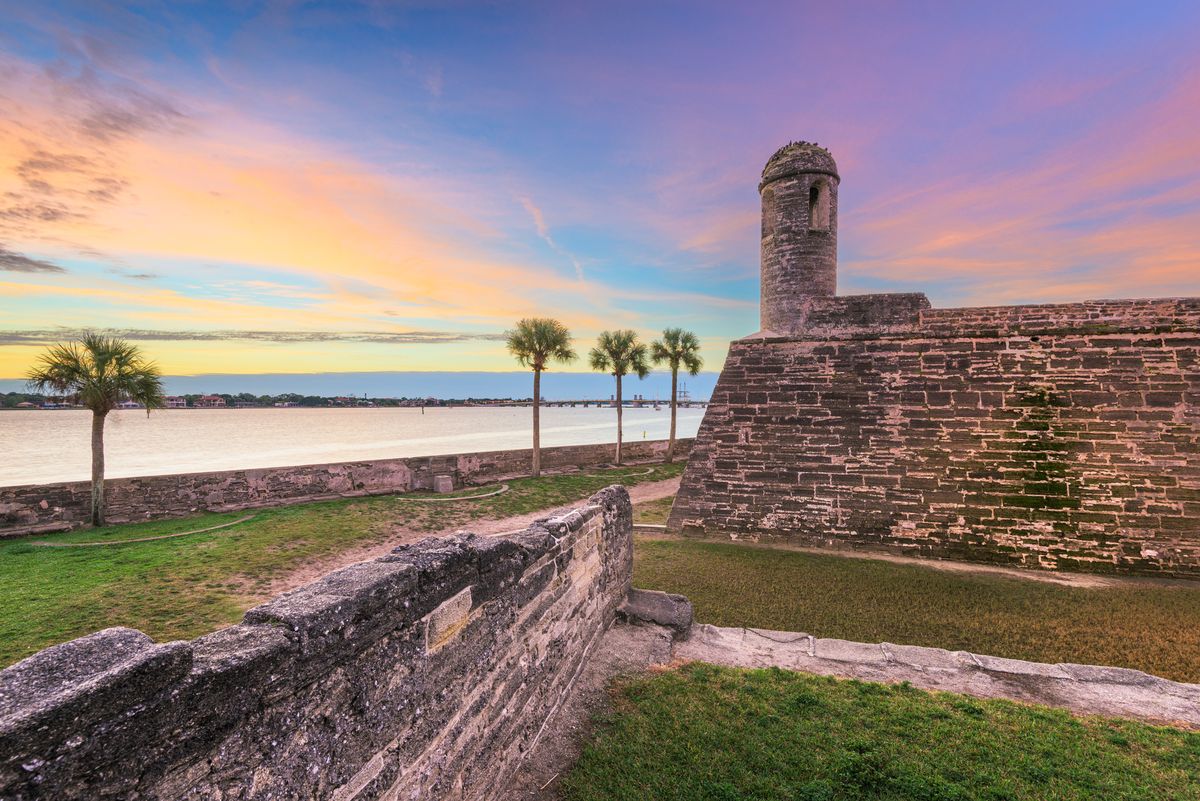
Castillo de San Marcos (Florida)
The oldest masonry fort in the United States is located in St. Augustine, Florida. Castillo de San Marcos is a Spanish stone fortress that was built over 315 years ago to defend Spain's claims to the New World. Today, it's a National Monument, where people can explore the rooms soldiers used to live in.
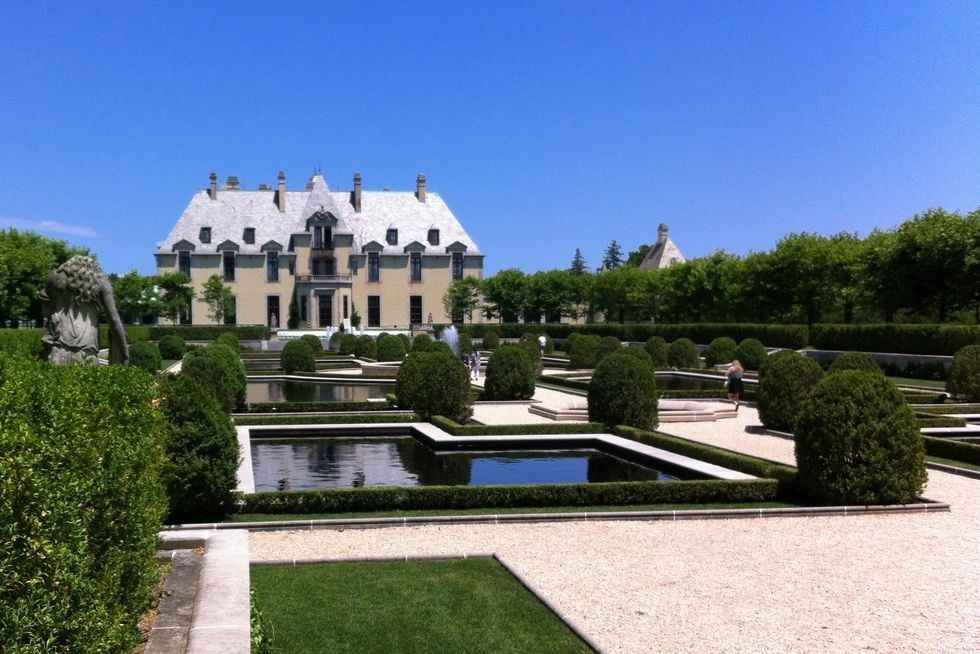
Oheka Castle (New York)
This French-style chateau dates back an entire century and remains the second-largest home ever built in America . The sprawling Huntington, New York, estate now serves as both a hotel and site for special events. It's become a celebrity hotspot as well, serving as Kevin Jonas's wedding venue and Taylor Swift's "Blank Space" music video set.
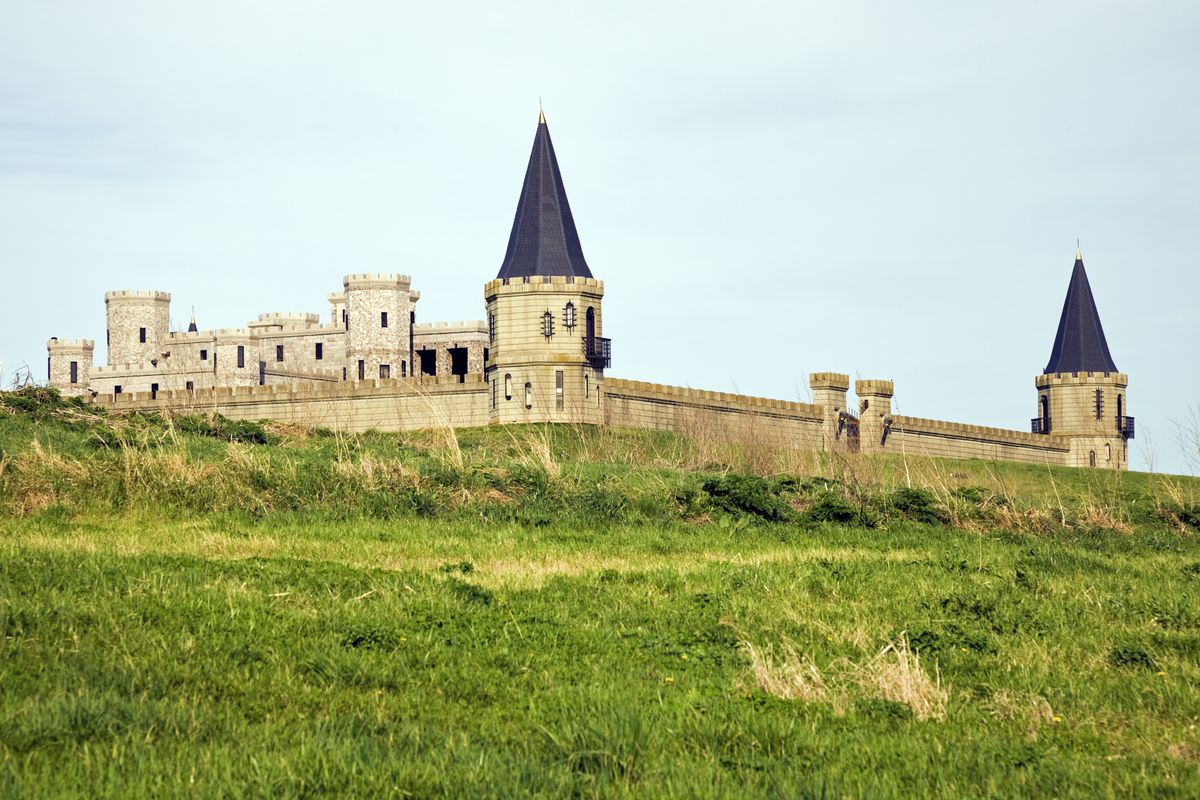
The Kentucky Castle (Kentucky)
After their European honeymoon, wealthy newlyweds Rex and Caroline Martin began construction on this Palace of Versailles-inspired structure in 1969. However, following their 1975 divorce, it remained vacant for nearly 30 years. Now, it serves as a boutique hotel and center for public events.
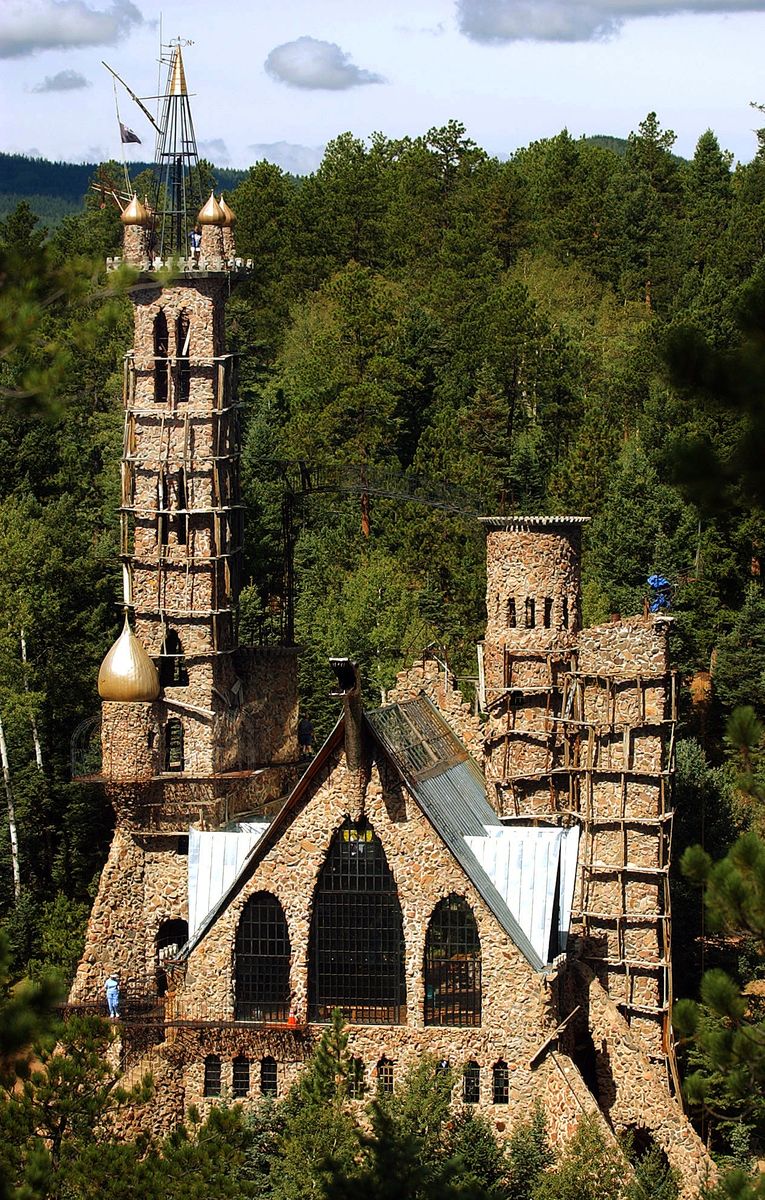
Bishop Castle (Colorado)
With quirky features, like a fire-breathing dragon and rooftop walkways, visiting this Colorado attraction is an adventure in every sense of the word. The entire structure was built by a man named Jim Bishop over the course of 60 years.
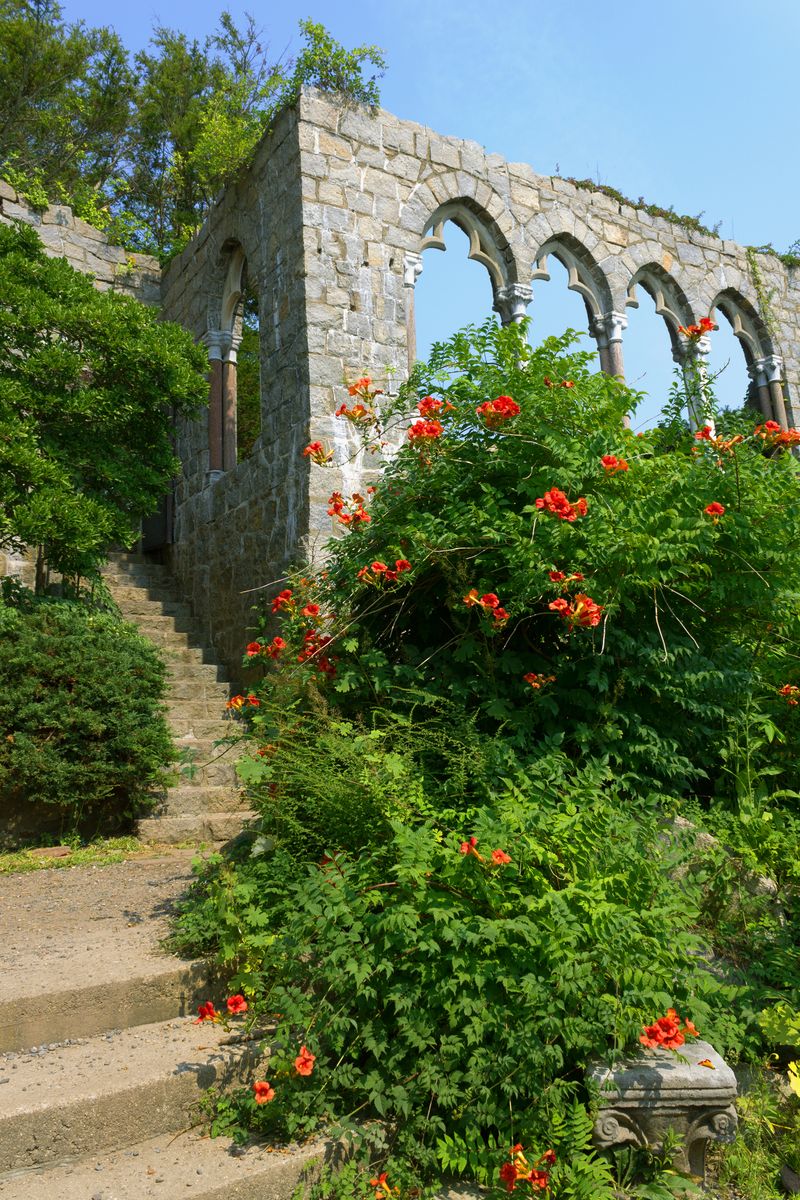
Hammond Castle (Massachusetts)
Built in the late 1920s, this once served as the laboratory of John Hays Hammond Jr. , an inventor who held 19 pipe organ technology patents. Between the medieval arches, winding stairwells, and seaside views, be sure to bring your camera for this one.
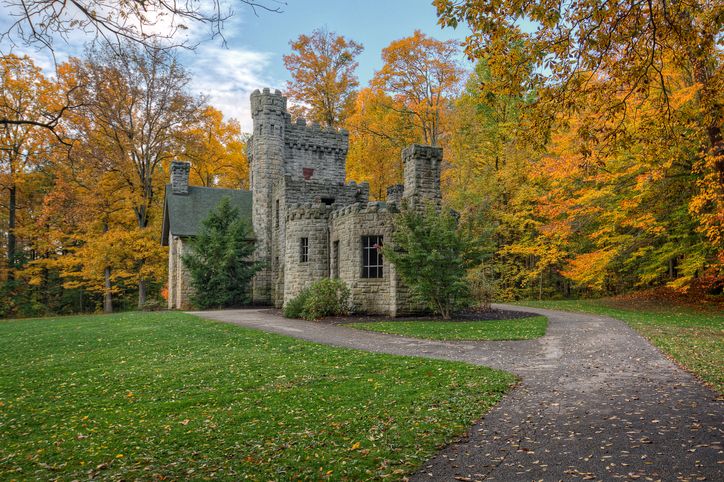
Squire's Castle (Ohio)
This mysterious gatehouse dates back to the 1890s and was inspired by German and English baronial castles . Located in the heart of Ohio's North Chagrin Reservation, there are hiking trails and picnic areas nearby to make a full day out of your visit.
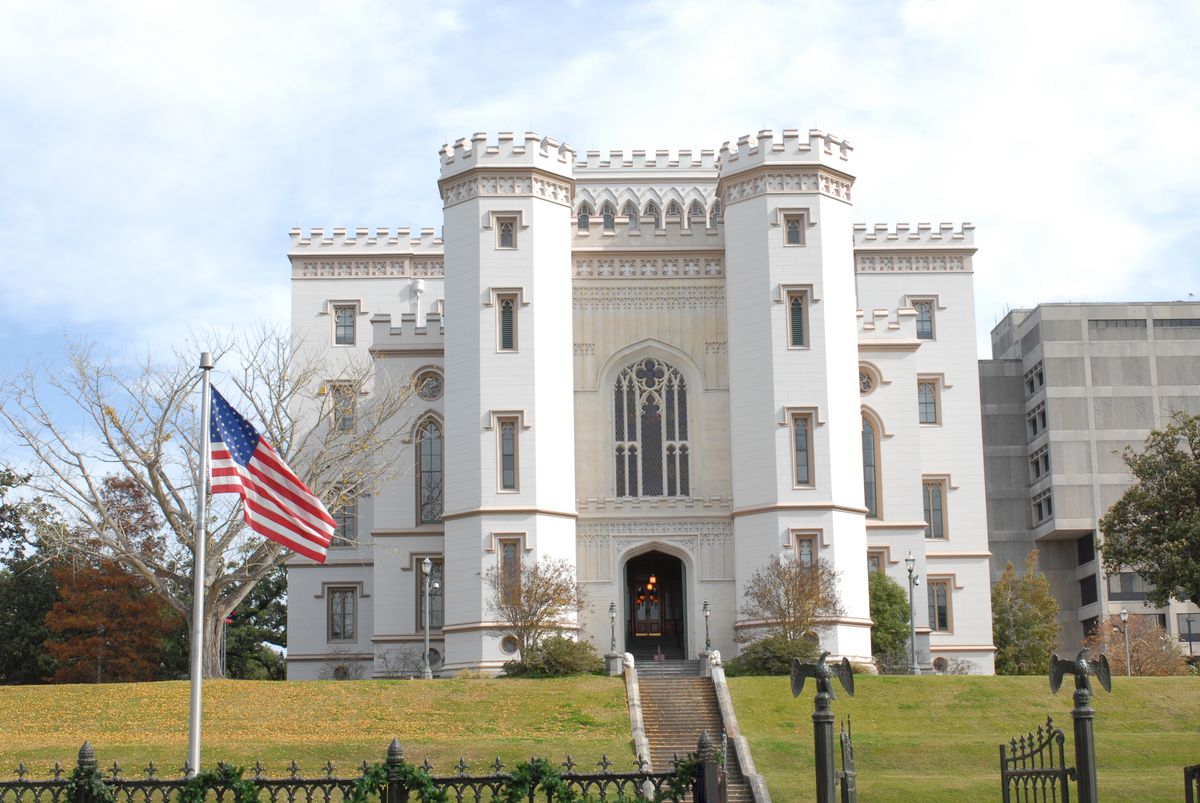
Louisiana's Old State Capitol (Louisiana)
The 165-year-old Baton Rouge statehouse overlooks the Mississippi River. Its Gothic design and castle-like inspiration is even more stunning in person. In 1994, the building reopened as the Center for Political and Governmental History, which is now known as the Museum of Political History.

Washington National Cathedral (Washington, D.C.)
While cathedrals aren't castles per se, they have several traits and architectural elements that closely resemble them—making them just as glorious to admire. This one, for example, was D.C.'s longest-running construction project that first began in 1907 .
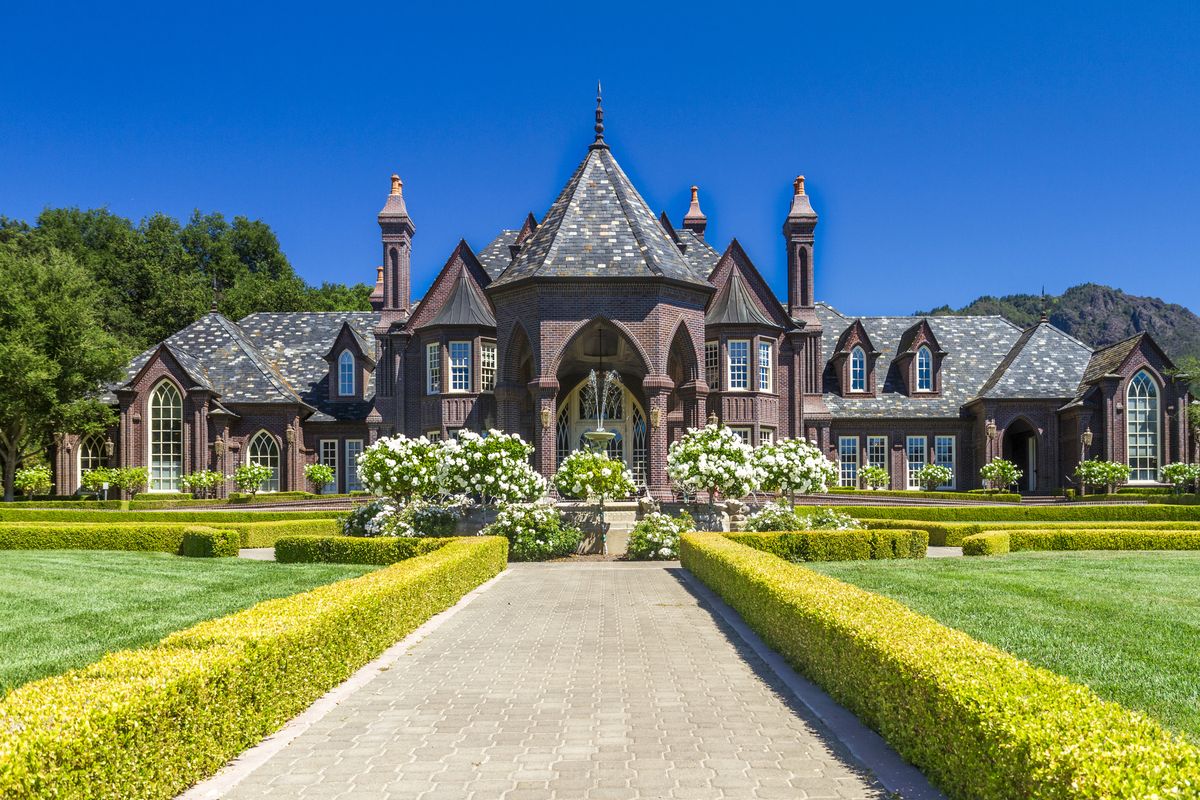
"The Castle" at Ledson Winery (California)
This California winery was first built in 1989. Steve Ledson designed the entire 16,000-square-foot French Normandy property himself, with some help from his son. While the exterior has everything from turrets to fountains, you'll find even more gorgeous features inside—including over five miles of wood inlays and mosaics.
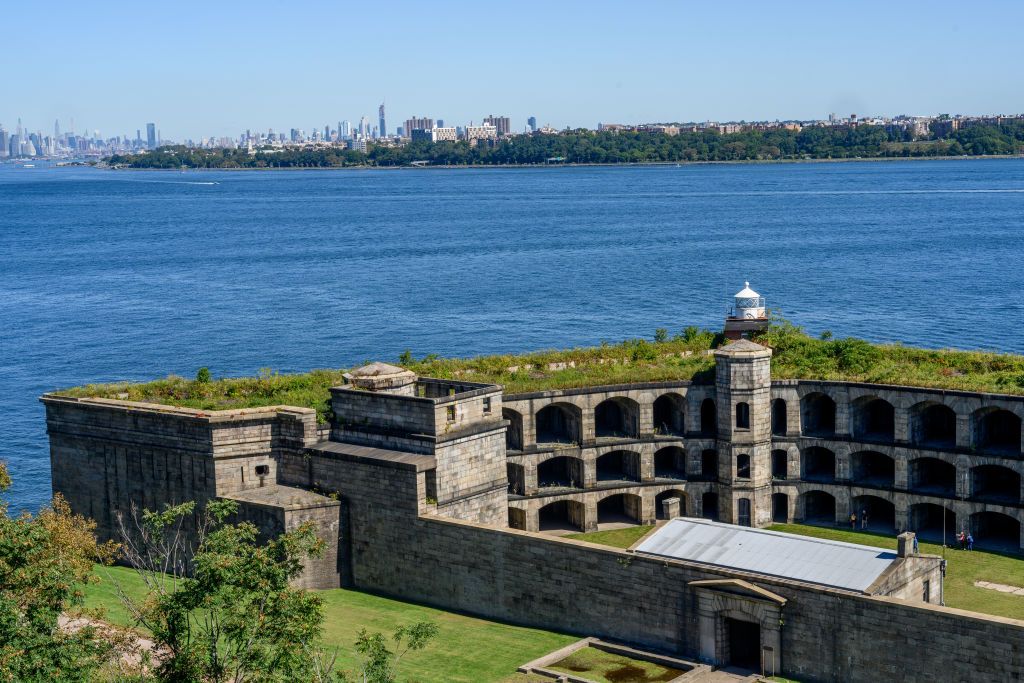
Battery Weed (New York)
This 19th-century Staten Island fortress took 14 years to complete. It's named after Stephen Weed , a New Yorker who was killed during 1863's Battle of Gettysburg. The contrast of the enormous brick structure and the Manhattan skyline makes for an eerily beautiful picture.
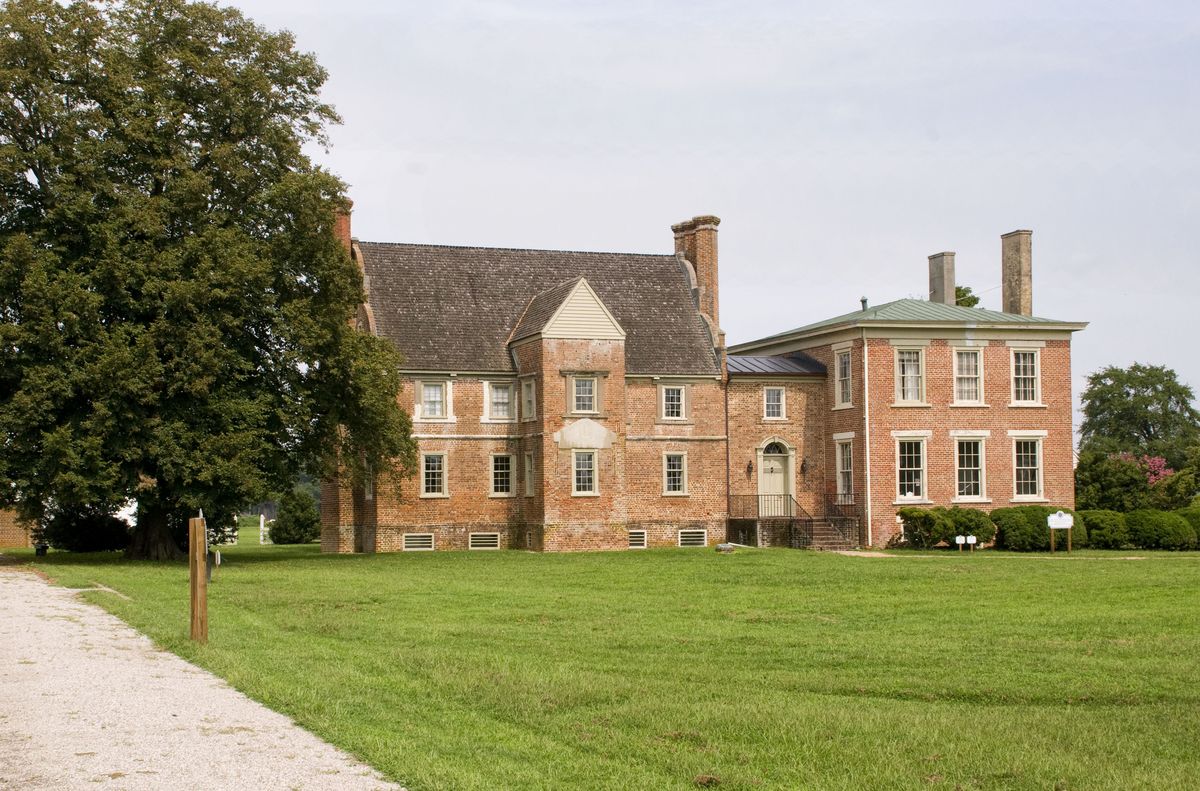
Bacon's Castle (Virginia)
While this house might not look as showy as the others, it has a pretty lengthy history. Arthur Allen first bought the land in 1650 and constructed this huge brick estate 15 years later. In 1676, those fighting in the Bacon Rebellion seized the property and looted it—hence the name.
More for You
Fani Willis Disqualification Petition Passes 60k Signatures
Kiefer Sutherland Says No Bullying On Set Of ‘Stand By Me'
As his trans daughter struggles, a father pushes past his prejudice. ‘It was like a wake-up’
Why Do People Add Plywood Under Their Countertops, And Do You Need To Do It?
New hypothesis emerges on Parkinson's disease's origins and spread
The Dumbest Things You Can Do With Your Money
Here’s what to do with your eclipse glasses
Dam Starts to Leak After 60-Foot Crack Sparks Urgent Warning
A father with children born via surrogacy rejects the Vatican's view that condemns the practice
These are the 10 worst U.S. states to live in for your mental health, according to a new study
How to keep your kidneys healthy, and how to spot when things are going wrong
9 Insider Secrets You Should Know From a Goodwill Employee
Striking Roman paintings uncovered in Pompeii after nearly 2,000 years
Animated Sequel Aang: The Last Airbender Is Officially Coming To Theaters, New Voice Cast Announced
Parents who raise successful, resilient kids never do these 5 things, experts say
Gardener shares simple way to build raised garden beds on a budget: 'Best part is there are no tools required'
Buckingham Palace Feared King Charles Could Face Prosecution
Scientists say outdated diabetes drug still has something to offer
Billionaire In-N-Out Owner Takes a Stand Against Soaring Prices Amid California's Minimum Wage Rise
See a Restored Ancient Roman Helmet—and Two Shiny New Replicas
More From Forbes
England’s alnwick castle is a must-visit for harry potter fans.
- Share to Facebook
- Share to Twitter
- Share to Linkedin
Alnwick Castle is a medieval fortress dating from the 11th century which dominates the surrounding ... [+] Northumberland landscape.
In the heart of Northumberland, England, lies a castle and country house that draws history buffs, architectural enthusiasts, and movie fans alike.
With its majestic structure and long history, Alnwick Castle commands attention and admiration from all. However, it holds a special place in the hearts of Harry Potter fans worldwide, not least because it offers broomstick flying lessons.
Famed as a filming location for the beloved series of movies, the castle offers visitors a journey into the realm of witchcraft and wizardry that captured the imaginations of millions.
An 11th-Century Landmark
Built in the 11th century, the castle’s initial purpose was to serve as a defensive post against incursions from the north, helping to secure the volatile lands in the north of England.
Over time, Alnwick Castle evolved from a purely defensive stronghold to the esteemed residence of the Percy family, the Dukes of Northumberland. This lineage, notable for its significant influence within British nobility, has lent the castle a legacy of power and political intrigue.
Architecturally, Alnwick Castle is a patchwork of military and domestic design trends spanning the medieval to the post-medieval era.
Its formidable towers and broad battlements are emblematic of the castle's military origins, while subsequent renovations and expansions reflect a transition towards the more opulent design preferences of residences of the wealthy.
Alnwick Castle dominates the skyline of Alnwick in Northumberland, England.
Best High-Yield Savings Accounts Of 2024
Best 5% interest savings accounts of 2024.
Alnwick Castle's design intricacies offer insight into the technological advancements and artistic movements that influenced architecture over the years.
A Touch Of Hogwarts Magic
Alnwick Castle shot to global fame when its courtyards and grounds were used as a filming location for Hogwarts School of Witchcraft and Wizardry in the Harry Potter film series.
Specifically, it featured in Harry Potter and the Philosopher's Stone and Harry Potter and the Chamber of Secrets , portraying the iconic locations where Harry Potter and his friends learn to fly broomsticks and play Quidditch.
The castle's authentic medieval look provided the perfect setting for the magical school, enchanting viewers and making it an instant must-visit for fans.
Visitors to Alnwick Castle can take part in various Harry Potter-themed activities that bring the movies to life.
The castle offers broomstick training sessions in the very spot where Harry had his first flying lesson, allowing fans to step into the shoes of their favorite characters, and get some memorable photos.
Guided tours delve into the castle's role in the Harry Potter films, highlighting specific locations used in the movies and sharing behind-the-scenes stories. These tours offer a fascinating insight into the filmmaking process and how Alnwick Castle was transformed into Hogwarts.
Beyond Harry Potter
While Alnwick Castle's Harry Potter connection might be the main draw for many, the castle has so much more to offer.
The formidable towers and broad battlements of Alnwick Castle are emblematic of its military ... [+] origins.
Firstly, the castle’s fame on screen is not limited to the Harry Potter franchise. Alnwick Castle has featured in Transformers: The Last Knight , and stood in for Brancaster Castle in two Downton Abbey Christmas specials.
Its rich history is encapsulated in well-preserved interiors, where visitors can explore opulent rooms filled with art and antique furniture. The castle also hosts various historical and cultural exhibitions throughout the year, providing a deeper understanding of its significance through the ages.
It also provides an atmospheric backdrop for cultural events ranging from book talks from historical fiction authors to comedy performances of medieval history.
Alnwick Garden , adjacent to the castle, is another attraction not to be missed. This contemporary pleasure garden, created by the Duchess of Northumberland, features spectacular water sculptures, a poison garden, a treehouse restaurant, and garden cafe.
Alnwick Castle Planning Tips
The castle is open to the public from late March to late October, with various events and activities for all ages. Visitors are advised to check the castle's official website for the latest information on opening times, ticket prices, and any special events in order to make the most of their trip.
Given its location in the far northeast of England, accommodation will likely be required as part of your trip.
For the most authentic taste of rural England, stay in Alnwick itself. Home to just 8,000 people, this historic market town offers hotel accommodation, shops and restaurants.
Stay in the 300-year-old coaching inn The White Swan Hotel , which incorporates a magnificent staircase and restaurant decor taken from the former ocean liner RMS Olympic , sister vessel of Titanic .
Venturing farther afield to Newcastle offers a wider range of accommodation options, from luxurious hotels to budget-friendly hostels, and is an appealing base for those wanting to combine history and culture with the excitement of a city break.

- Editorial Standards
- Reprints & Permissions

IMAGES
COMMENTS
The motte of Fotheringhay Castle. Fotheringhay Castle, also known as Fotheringay Castle, was a High Middle Age Norman Motte-and-bailey castle in the village of Fotheringhay 3 + 1 ⁄ 2 miles (5.6 km) to the north of the market town of Oundle, Northamptonshire, England (grid reference).It was probably founded around 1100 by Simon de Senlis, Earl of Northampton.
Fotheringhay Castle: The Power-Base of the House of York. Before we visit the site of Fotheringhay Castle and recreate the medieval palace as it was in the sixteenth century, let's say a little about why this site became so significant.Fotheringhay would likely be of little interest were it not for the rising fortunes of the House of York, which allowed the early twelfth-century castle to be ...
About Fotheringhay. Address: Castle Farm Cottage, Fotheringhay, Northamptonshire, England, PE8 5HZ. Attraction Type: Castle. Location: No dedicated parking area; park on the main Fotheringhay road. The castle is on a footpath beside Castle Farm, off the main road. The village is four miles north of Oundle. off the A605.
Fotheringhay Castle (also known as Fotheringay Castle) was a High Middle Age Normal Motte-and-Bailey castle around three miles north of the market town of Oundle, Northamptonshire, England. It was likely founded in around 1100 by Simon de Senlis (St Liz), Earl of Northampton. It changed hands successively until it finally fell into the hands of ...
Visiting Fotheringhay Castle. Unlike many of the castles on this site, Fotheringhay isn't much to look at now. It is mostly a ruin. However, although much of the original structure has been destroyed or lost over time, there are still some parts that have survived such as sections of walls and towers which provide insight into how impressive this medieval fortress once looked.
After Mary's execution the castle was abandoned, with its stones reused to build an inn in Oundle and incorporated into the nearby Castle Farm. Today you can climb the mound and admire this great example of a motte and bailey site. Look out for the remaining masonry wall where a commemorative plaque commemorates the death of Mary, Queen of Scots.
Fotheringhay Castle is the remains of a large, medieval motte-and-bailey castle. The castle was built in the early 12th century by Simon de Senlis I, the Earl of Northampton who also built Northampton Castle. It strategically overlooks a crossing point on the River Nene and it also acted as a royal palace and a prison from the 13th century ...
Visiting Fotheringhay Castle. The castle can be found down a signposted footpath between Castle Farm Guest House and the "New Inn", now a private home, on the sharp bend as the road goes through the village. The site is free to enter and open during day light hours. ... To get the best out of your visit make sure you walk through the ...
Fotheringhay is a sleepy Northamptonshire riverside village with a magnificent stone church and the earthworks of an ancient castle, which have long since been forgotten. ... So little of the castle remains today that unless you know where to look you would be hard pressed to believe that it ever stood here. The thistles that grow on the mound ...
The motte and bailey castle at Fotheringhay lies at the south eastern end of the present village close to the River Nene. The castle consists of a substantial earthwork motte, an inner bailey and the remains of the outer bailey earthworks. The motte is a steep-sided round mound approximately 7m high and about 70m in diameter.
Fotheringhay Castle, Fotheringhay - 16/10/2020. Oct 2020. How little remains of Fotheringhay Castle, and yet how important its place is in the history of our islands. If wanting to visit this site on account of history you will not need long; little remains of Fotheringhay. A weighted kissing gate (which I confess flummoxed us; kissing gates ...
Jan 2019 • Solo. Thought to be over a 1000 years old,Fotheringhay Castle is situated a short distance from the River Nene in the pretty village of Fotheringhay. It was the birthplace to Richard 111 whilst Mary, Queen of Scots was executed here some 120 years later. The castle was finally taken down in 1628.
Fotheringhay's great days were largely over. The Chancel of the massive church was pulled down in 1553 during the dissolution of the monasteries. The castle was levelled in the 1630's. What's left is a beautiful echo of it's former glories - the lovely stone church across the river, and signs of grand stones and carvings in the ...
Sept 2019. Fotheringhay is a very attractive and well kept village with an architecturaly interesting church and a good pub. The castle, now just a mound, is where Mary Queen of Scots was beheaded. There is a fine view from the top of the mound over the surrounding countryside. Read more.
5. Edinburgh Castle. A royal residence, a vital stronghold and an iconic structure, Edinburgh Castle is one of the most famous castles in the world. The castle was the site of the birth of King James VI, also James I of England from 1603, to Mary Queen of Scots in 1566. Visitors can still see the small room where this monarch was born.
Mary herself was not informed of where she was going, and she arrived at Fotheringhay Castle on 25 September. She was accompanied by five or six servants. Mary refused to confess her guilt, and on 12 October a letter arrived from Elizabeth. "You have in various ways, and manners attempted to take my life and to bring my kingdom to destruction ...
There's some nice views along here & we get our first view of the remains of Fotheringhay Castle… 38. So let's go & have a closer look… Fotheringhay Castle has lots of history. It was probably built around 1100 by Simon de Senlis, Earl of Northampton. In 1113 possession passed to Prince David of Scotland when he married Simon's widow.
Fotheringhay Castle was a motte-and-bailey fortification raised in the early twelfth century by the Earl of Northampton. It was subsequently owned by various Scottish Princes before being incorporated into the Dukedom of York. In 1587 the castle was chosen to host the trial and execution of Mary, Queen of Scots. The castle was dismantled in the 1630s and most of the masonry was removed ...
Fotheringhay Castle, Fotheringhay: See 16 reviews, articles, and 35 photos of Fotheringhay Castle, ranked No.3 on Tripadvisor among 4 attractions in Fotheringhay.
Fotheringhay is a village and civil parish in North Northamptonshire, England.It is 4 miles (6.4 km) north-east of Oundle and around 13 miles (21 km) west of Peterborough.It is most noted for being the site of Fotheringhay (or Fotheringay) Castle which was razed in 1627. There is nothing left of the castle to be seen today other than the motte on which it was built that provides excellent ...
Queen Elizabeth I visited Fotheringhay in 1566. She may have remembered this visit when later in her reign she chose the castle as the place to hold the trial and execution of Mary Queen of Scots. The castle site was in a marshy landscape and access was difficult, especially during the heart of winter.
Folklore has it that King Richard III may well have been baptised in the font, as he was born in Fotheringhay Castle in 1452. ... If you are looking to visit Fotheringhay, we can help provide you with all the information you need to plan out your visit and have the most enjoyable experience of the village, Church and surrounding areas. ...
1 / 40. Belvedere Castle (New York) ©Photo by Scott Dunn - Getty Images. Sitting pretty in the middle of New York City's Central Park is one of the country's most famous castles. Completed in ...
The castle's authentic medieval look provided the perfect setting for the magical school, enchanting viewers and making it an instant must-visit for fans. Visitors to Alnwick Castle can take part ...